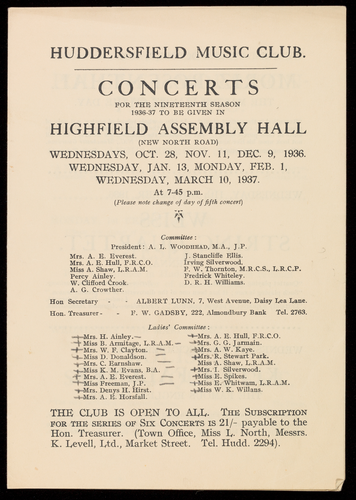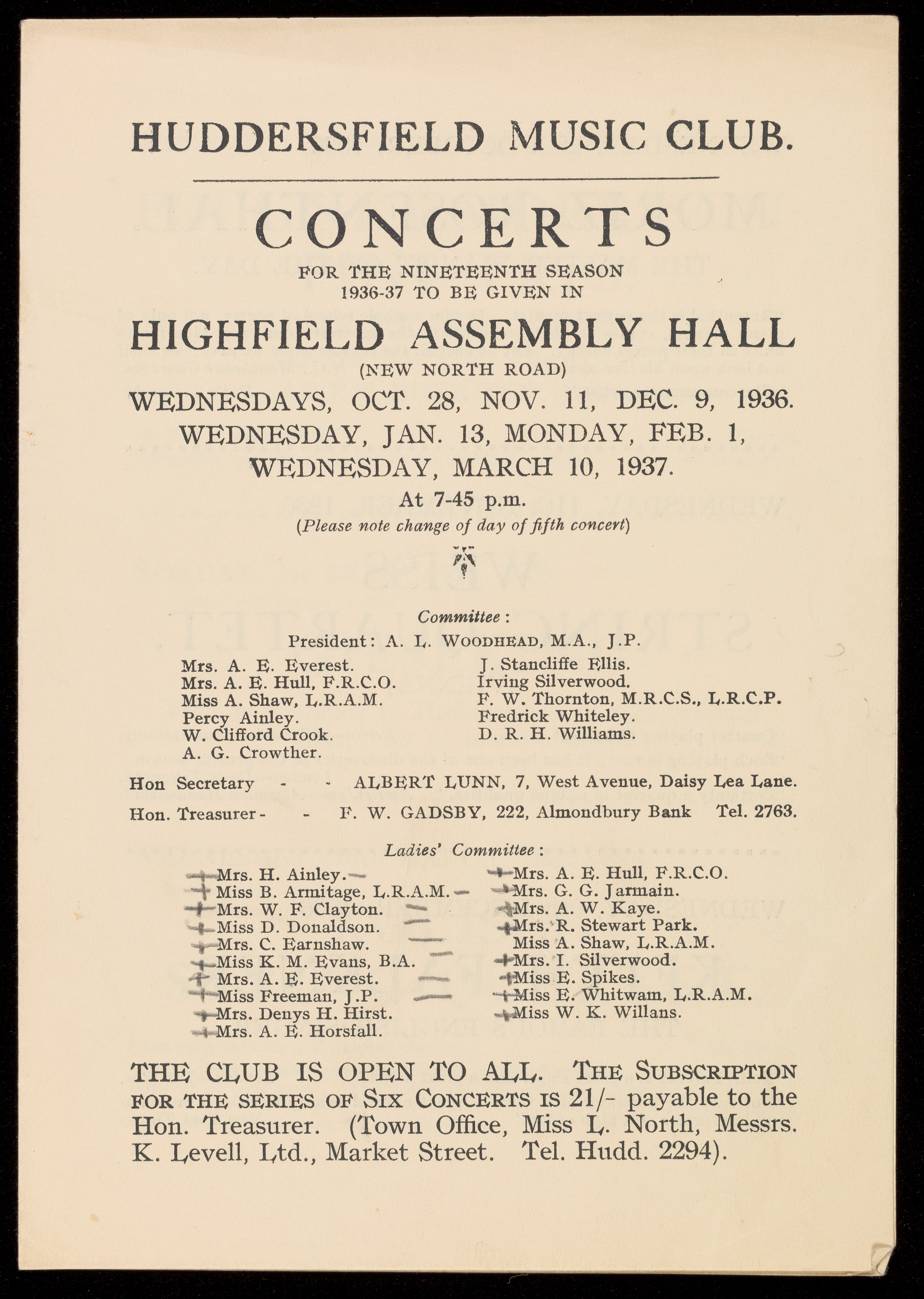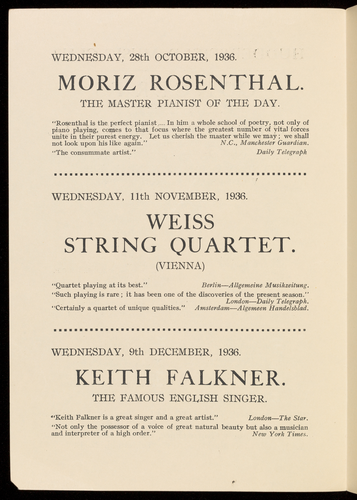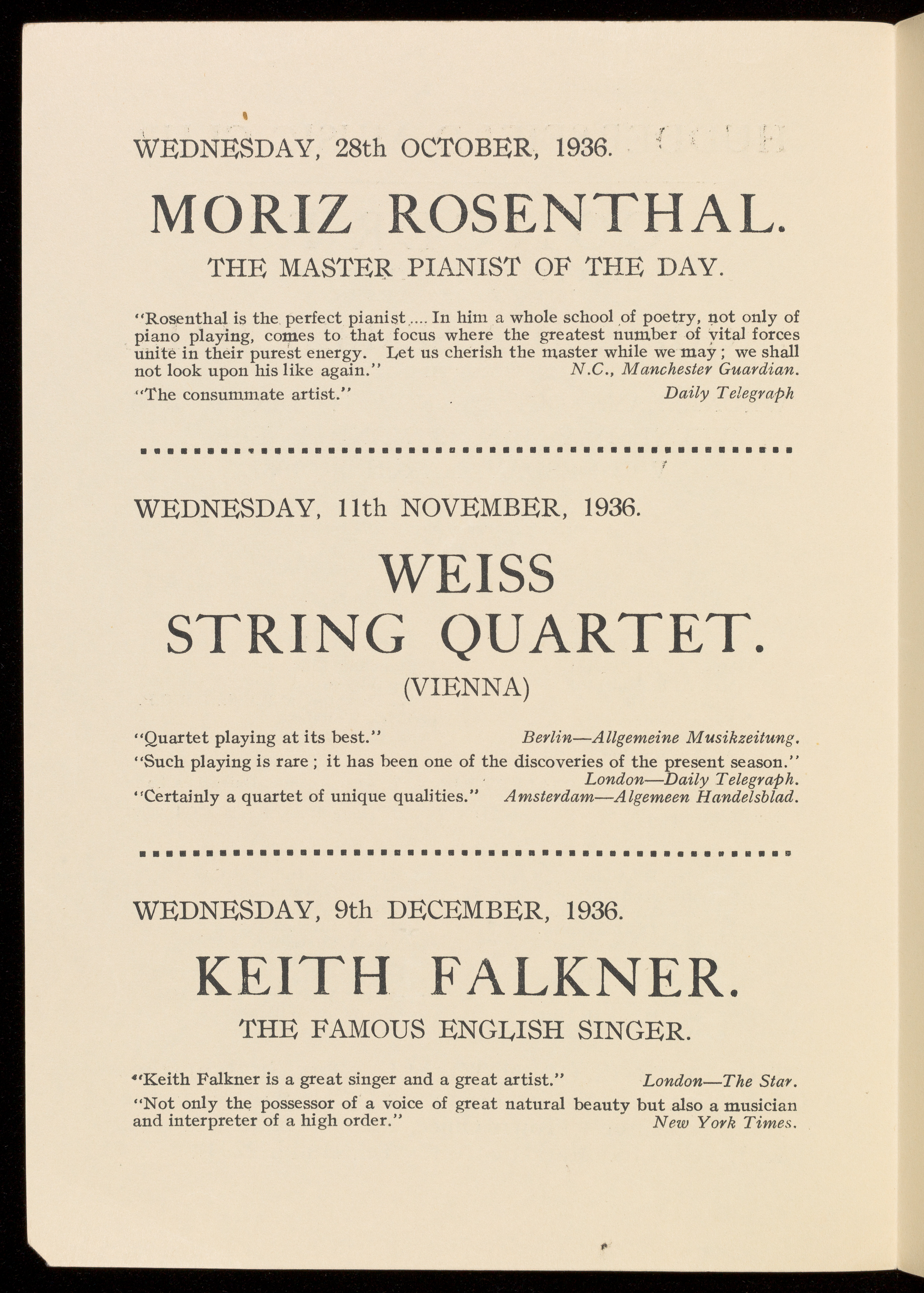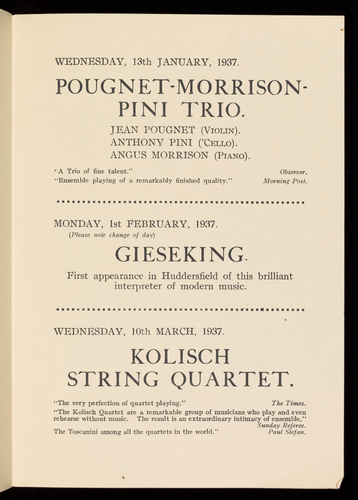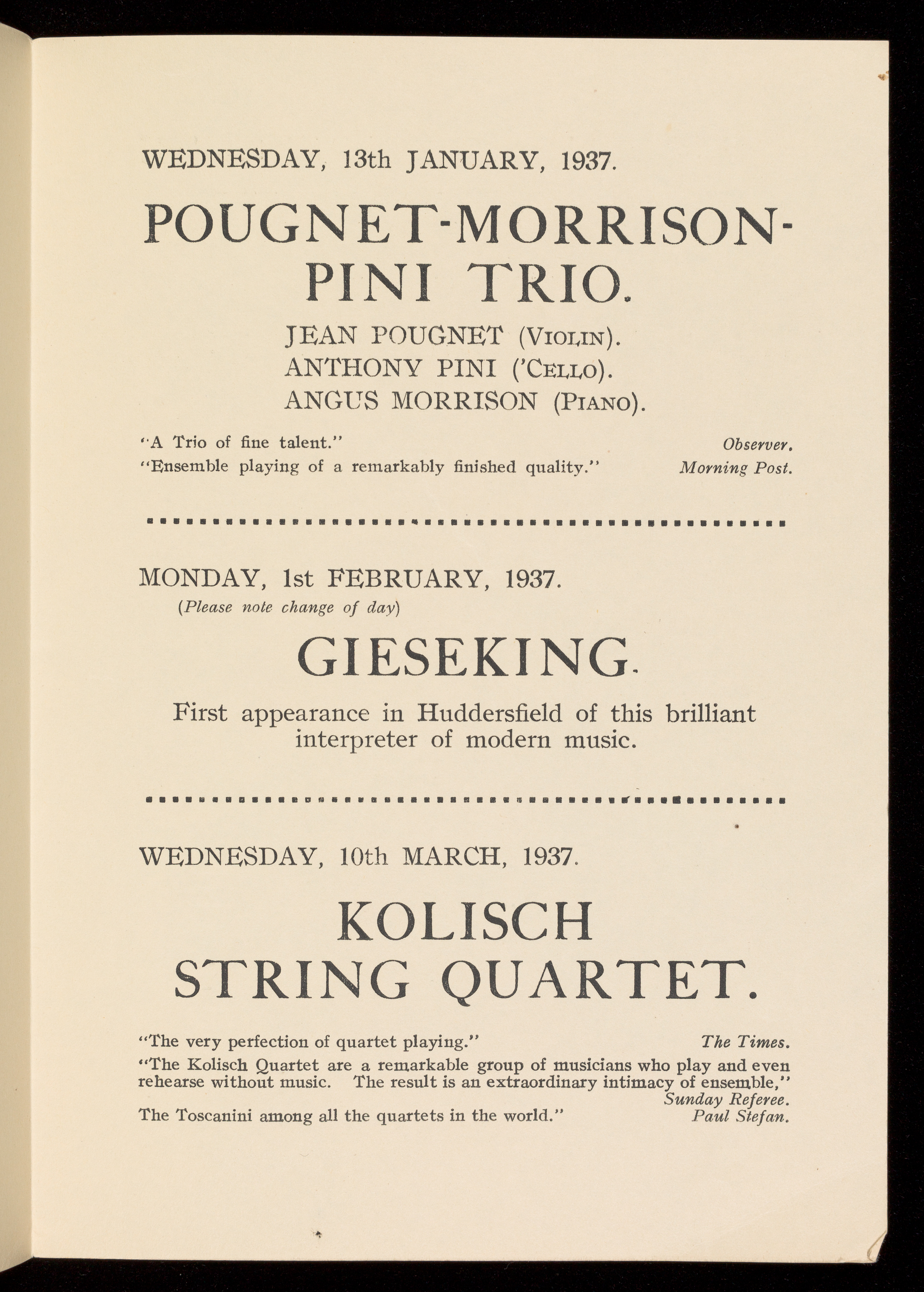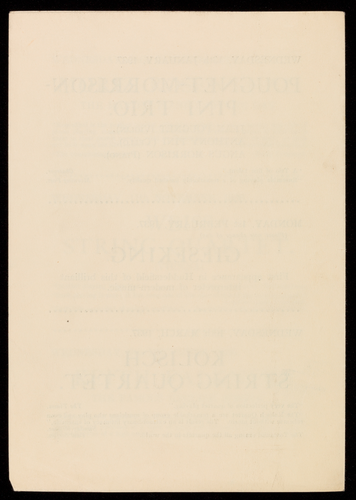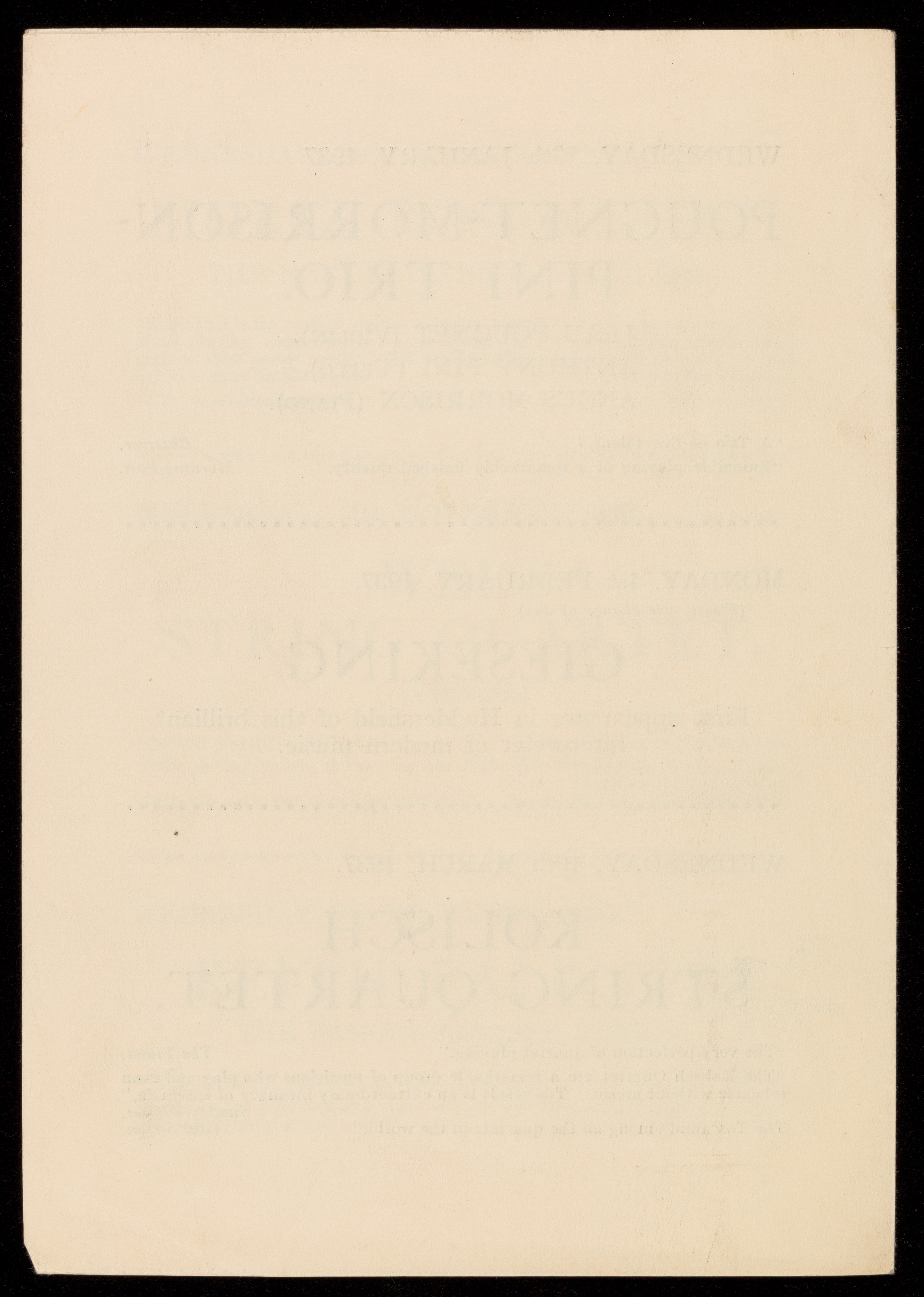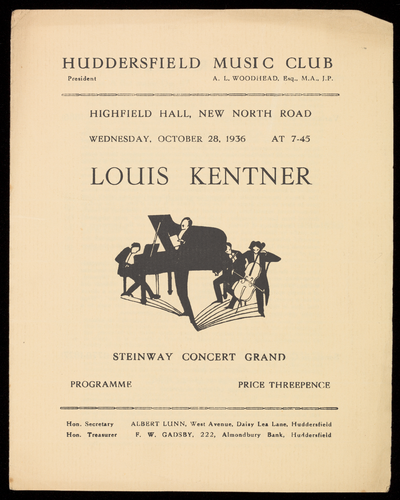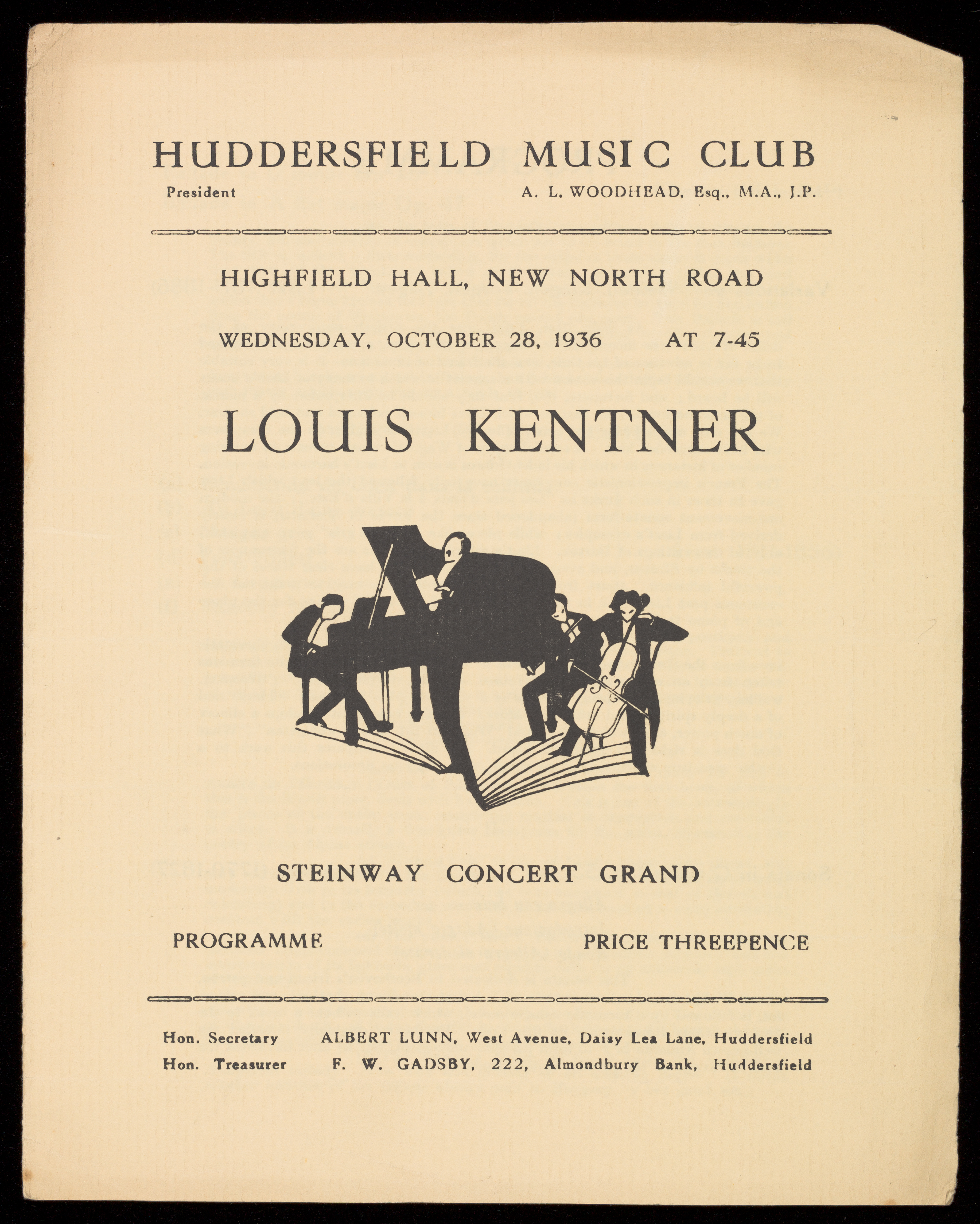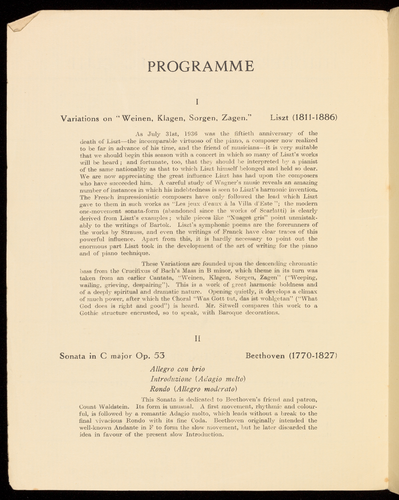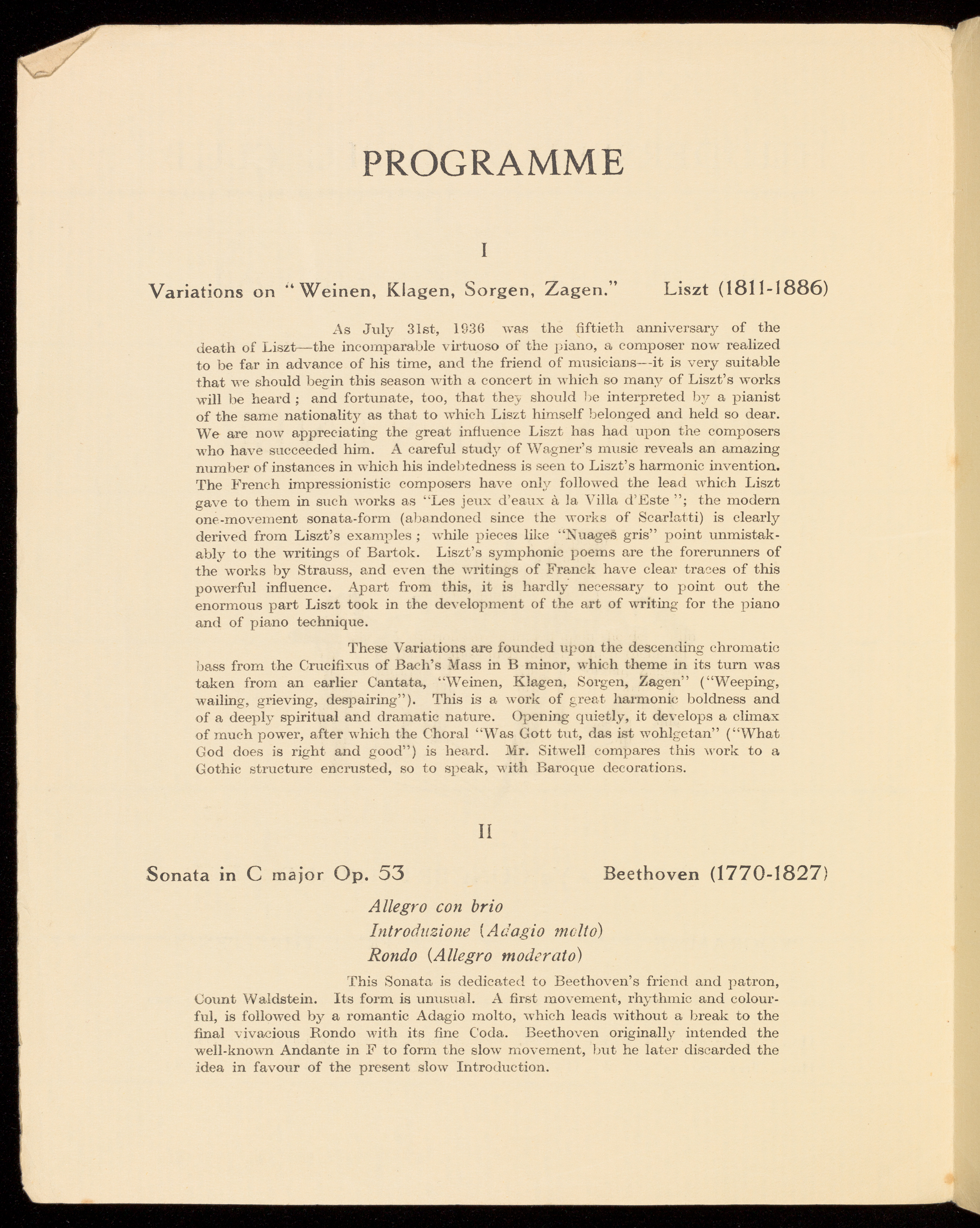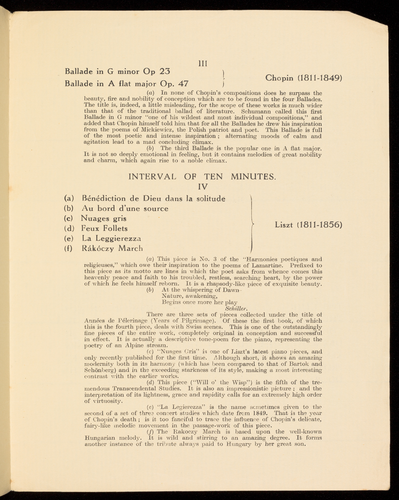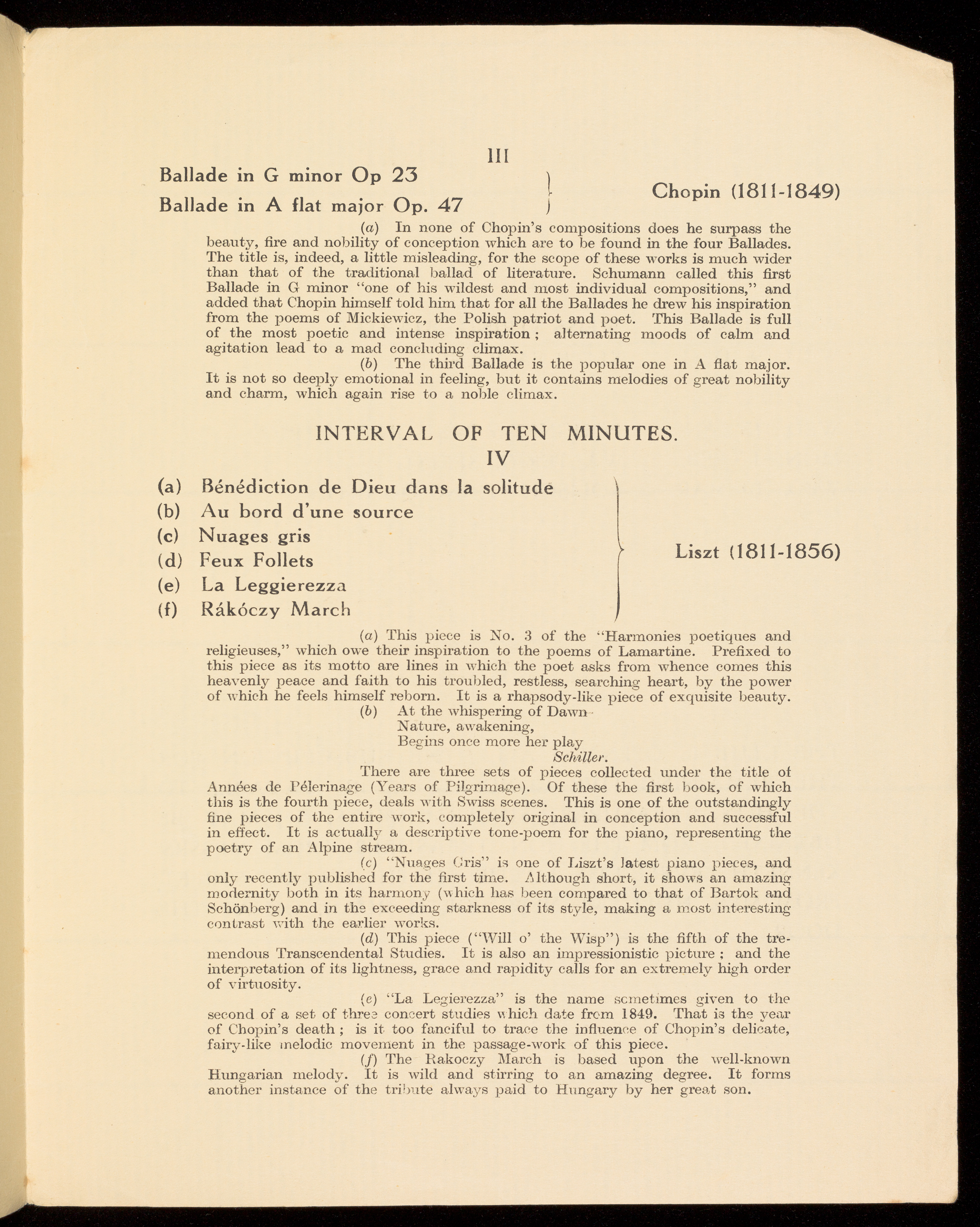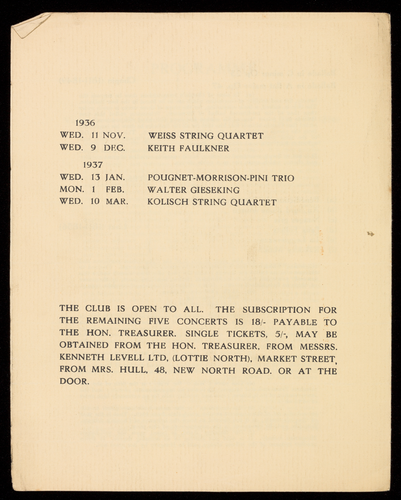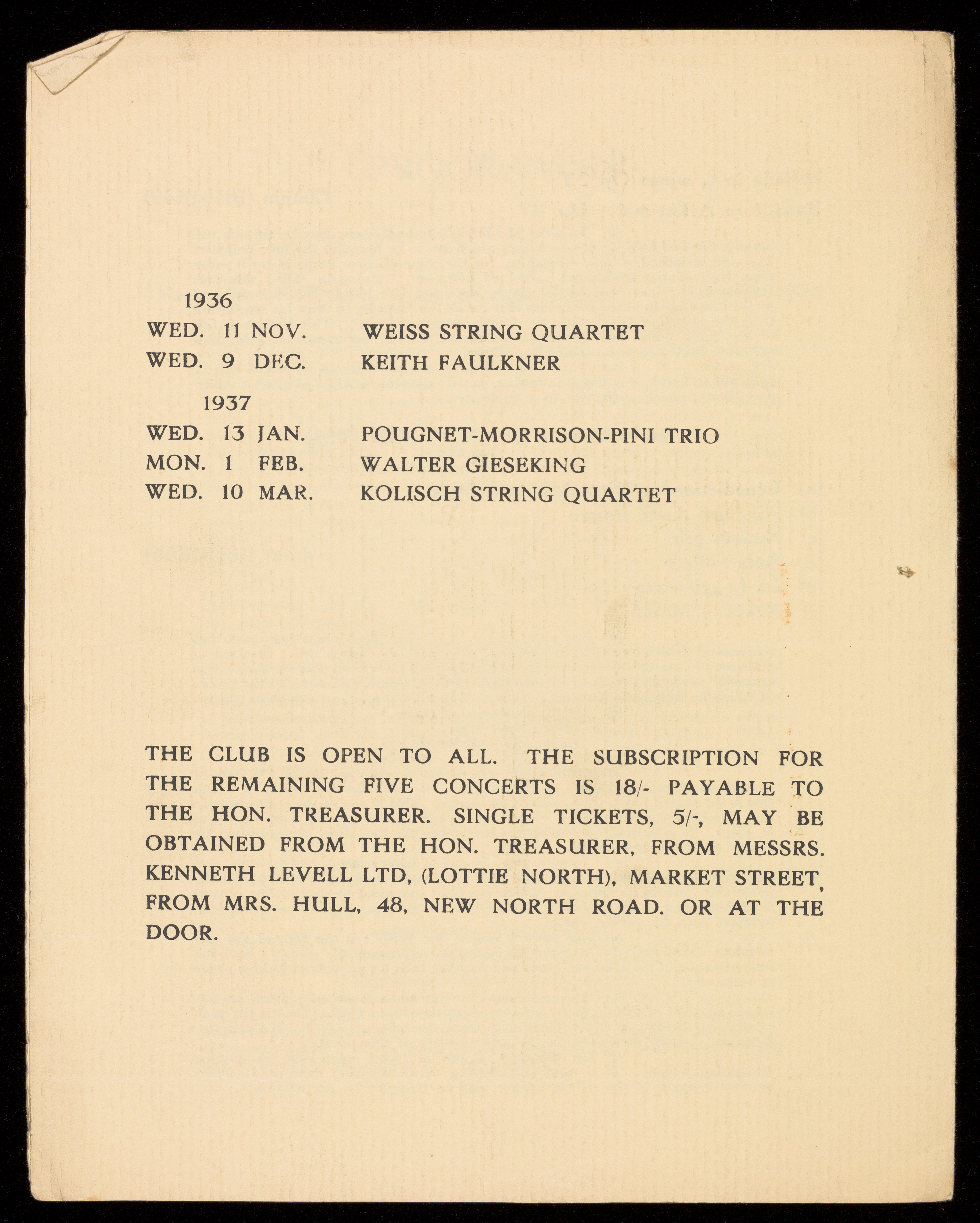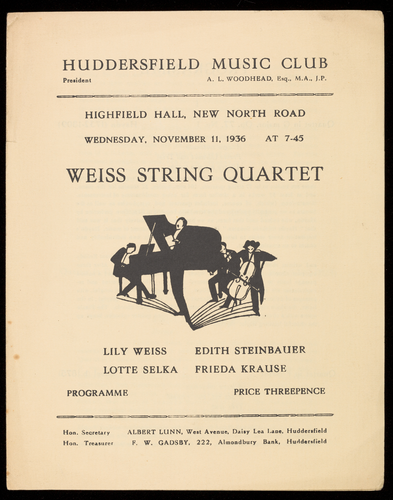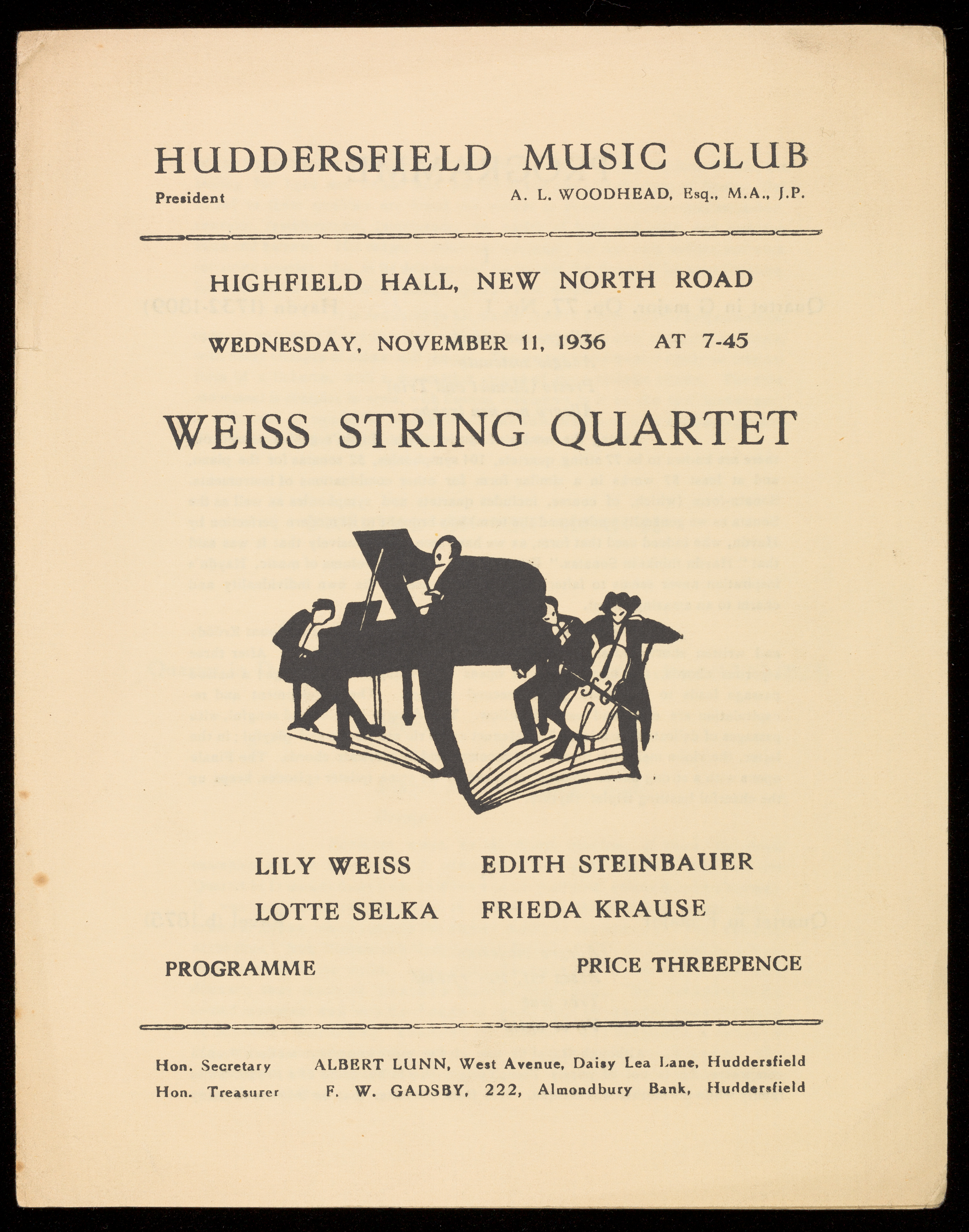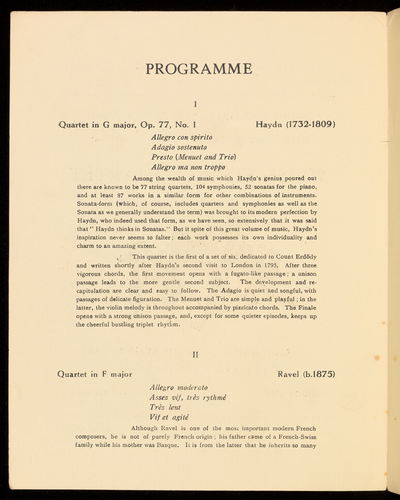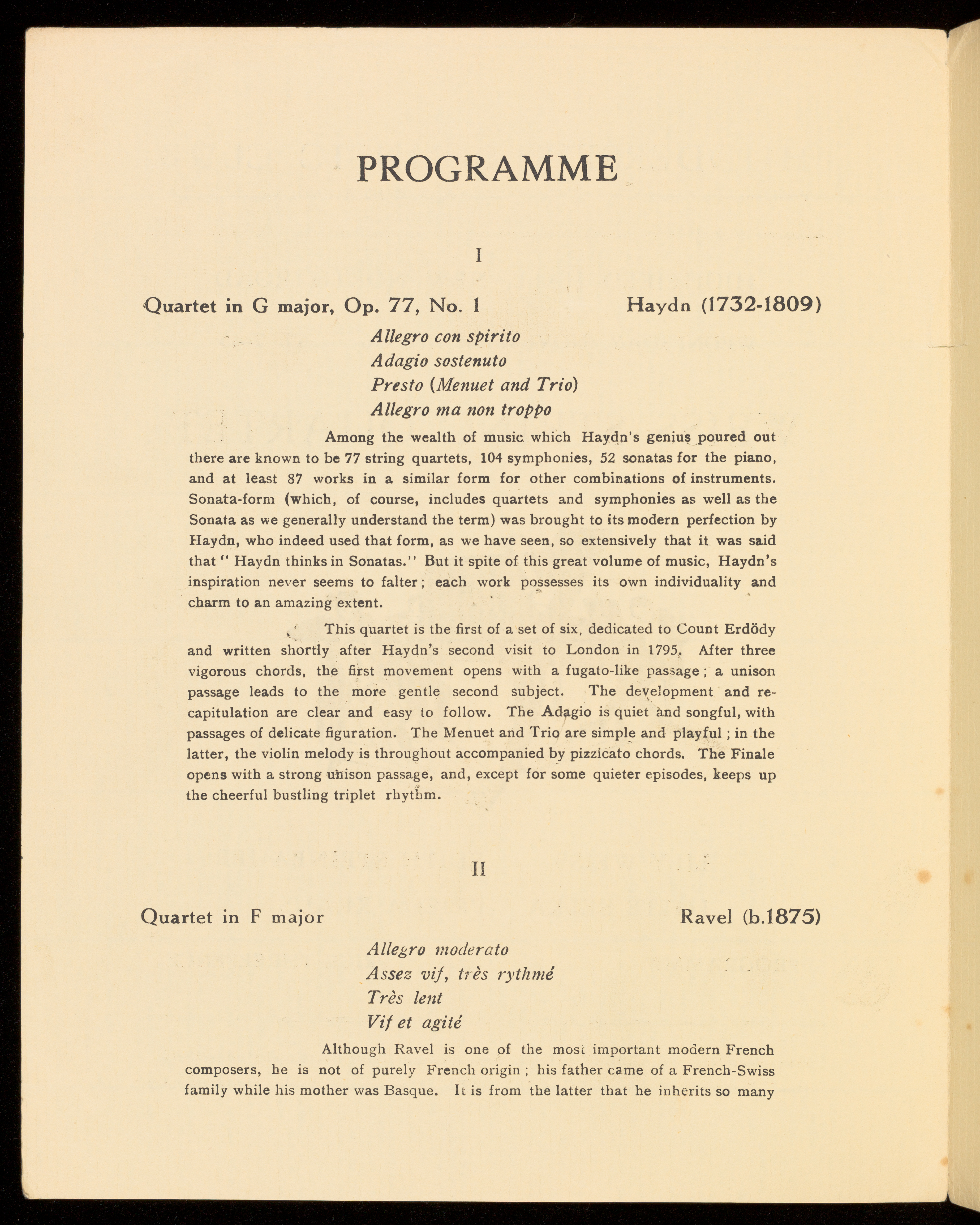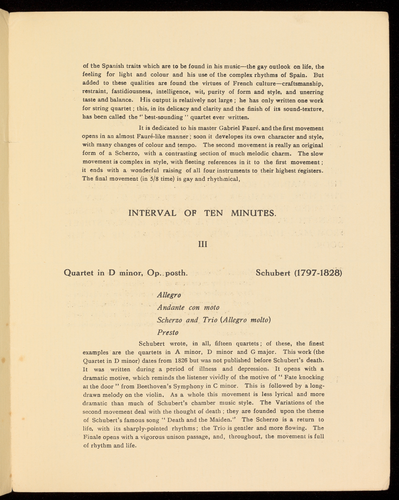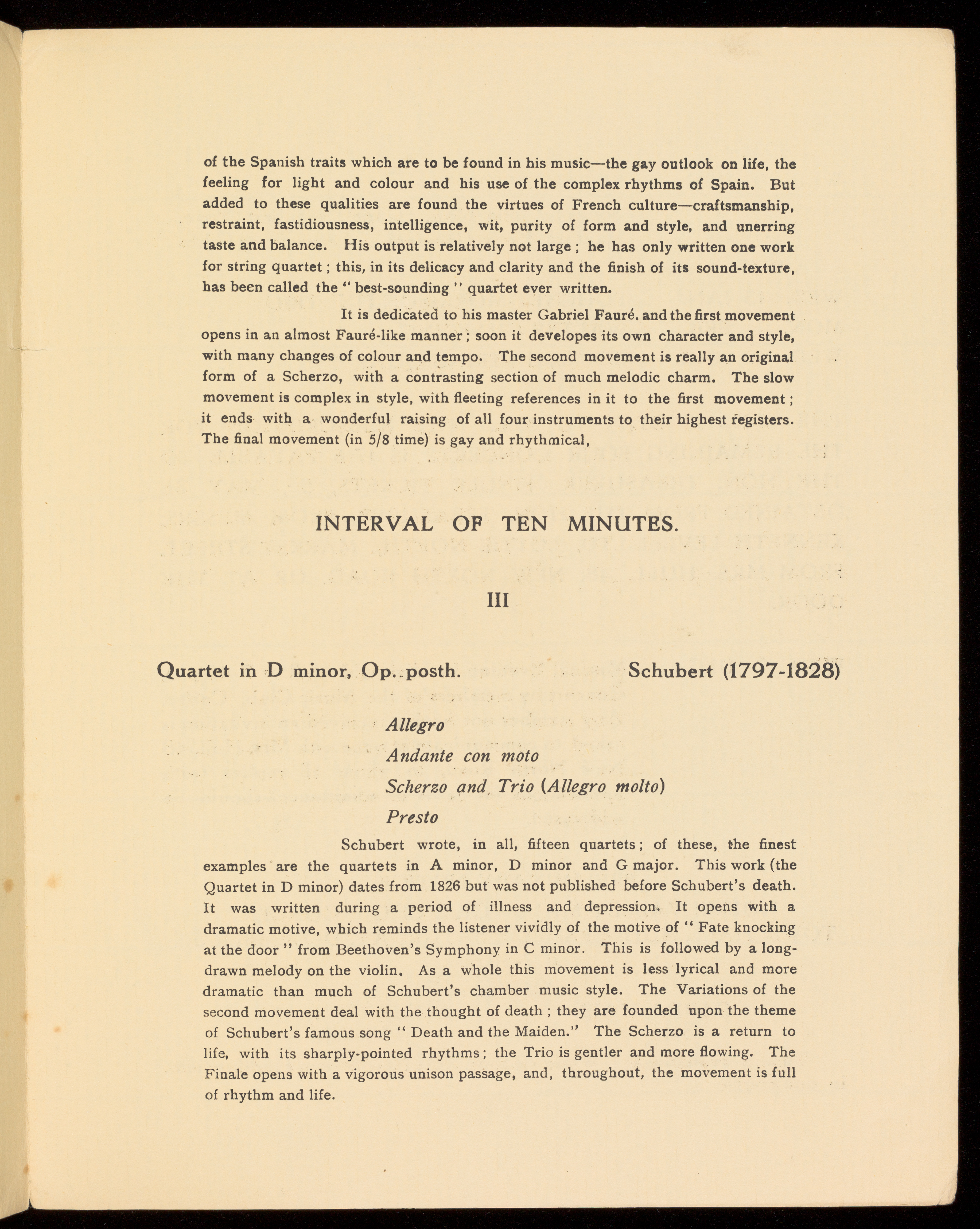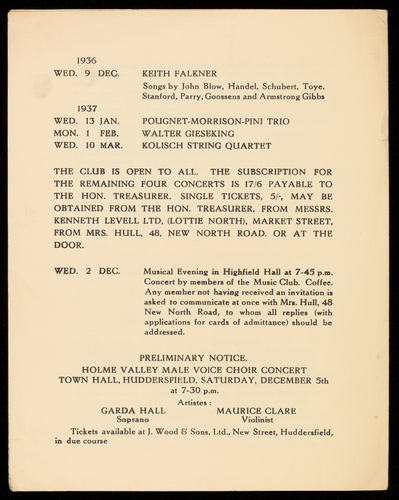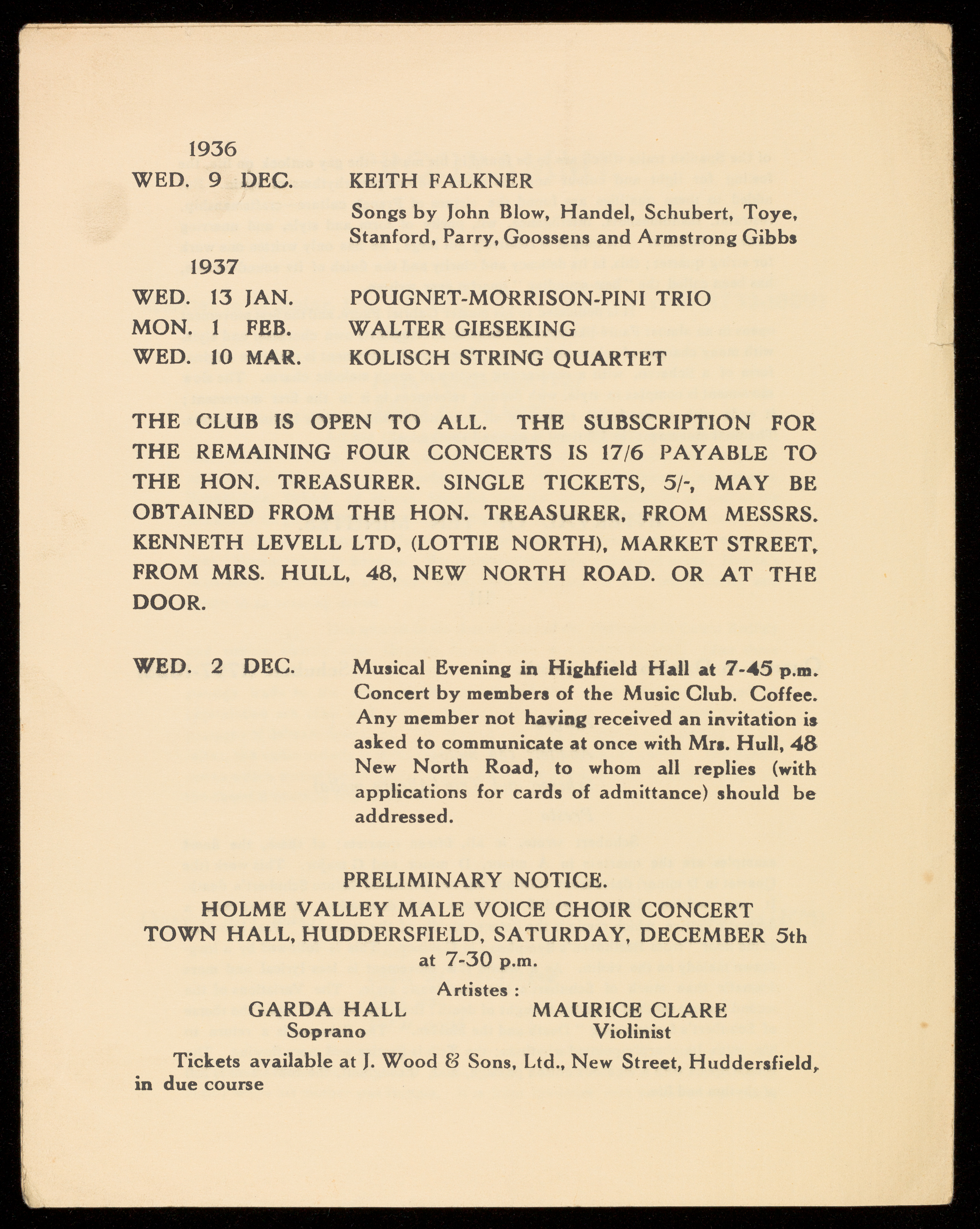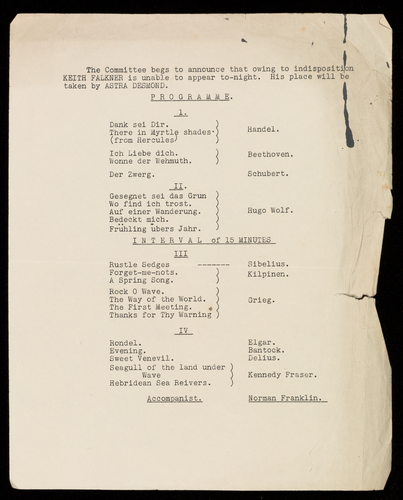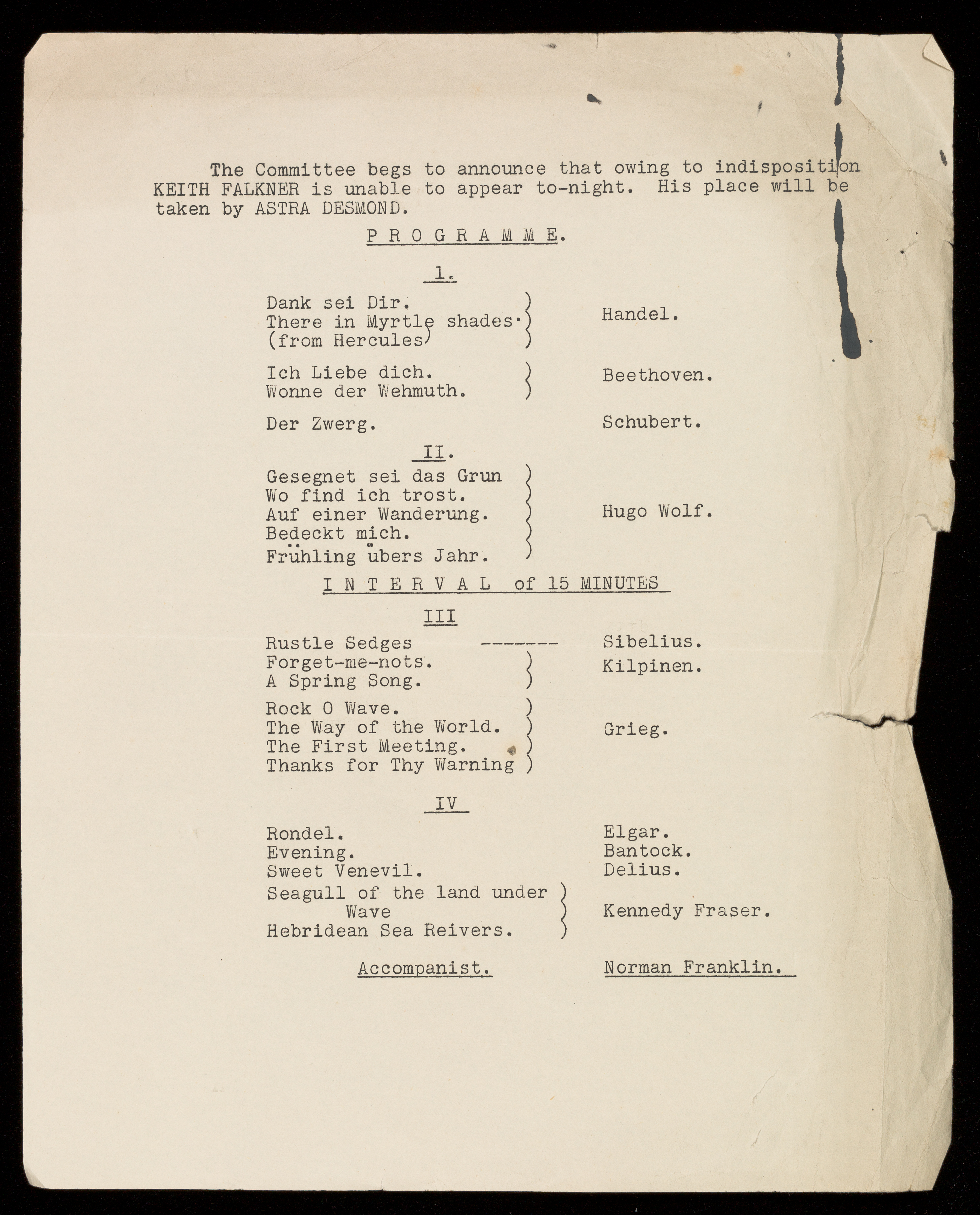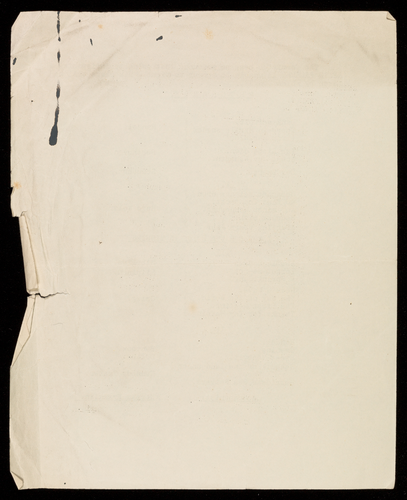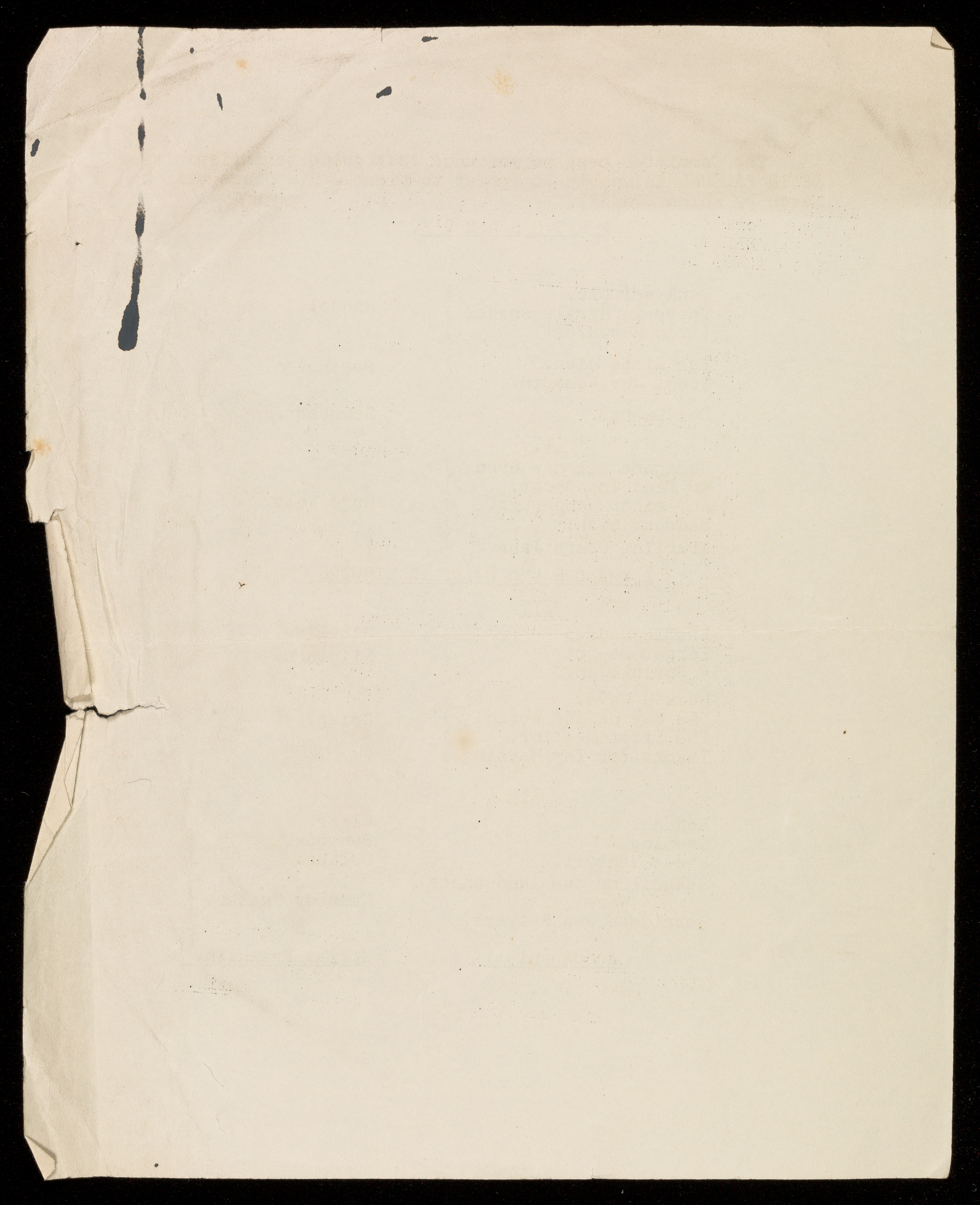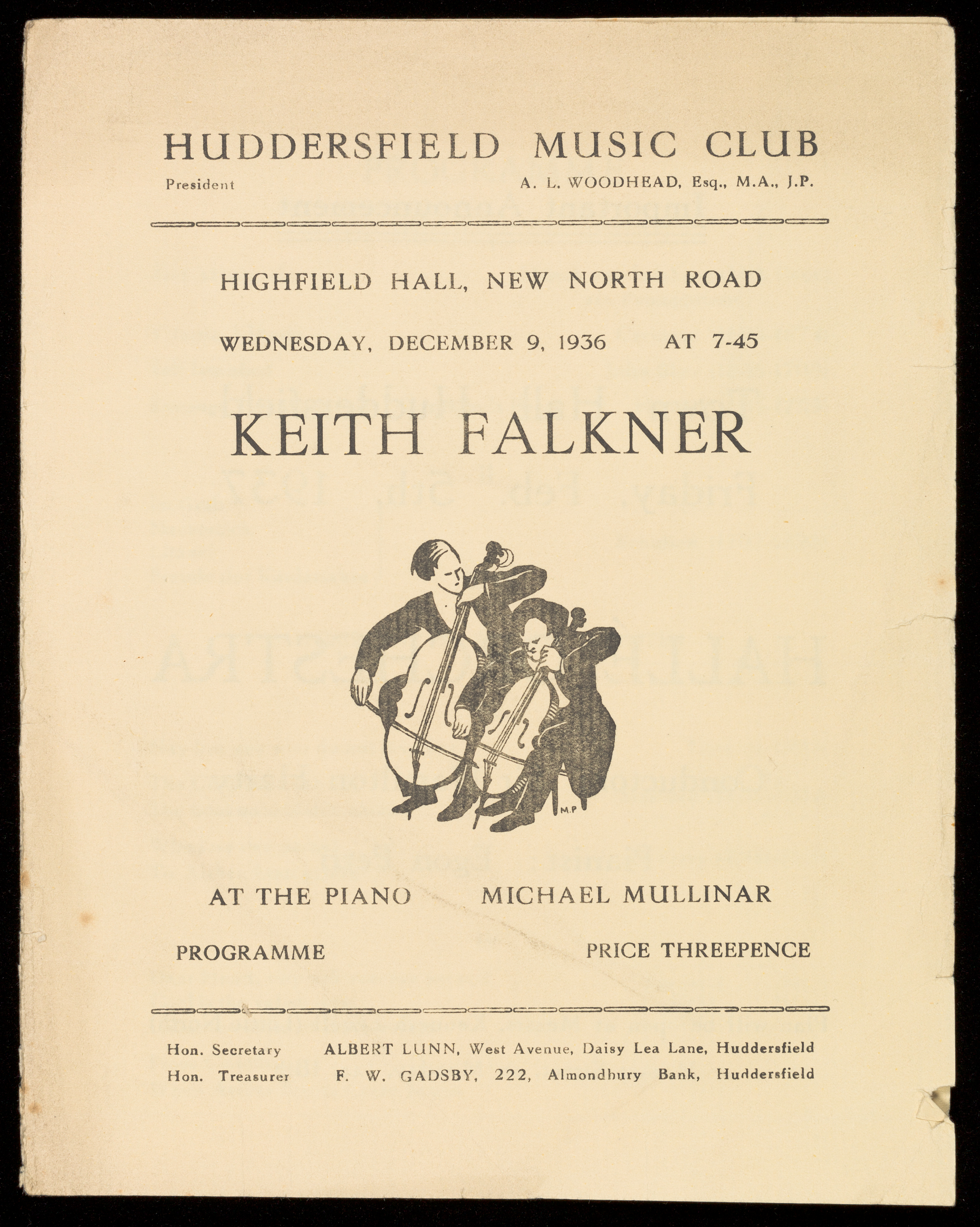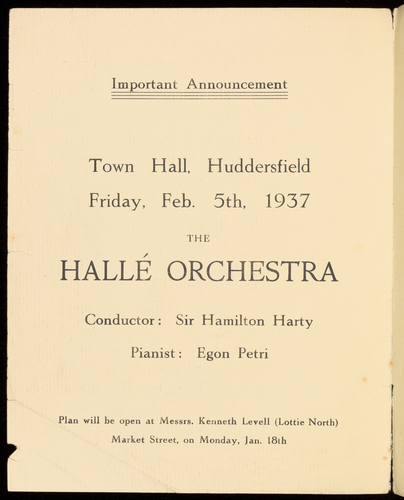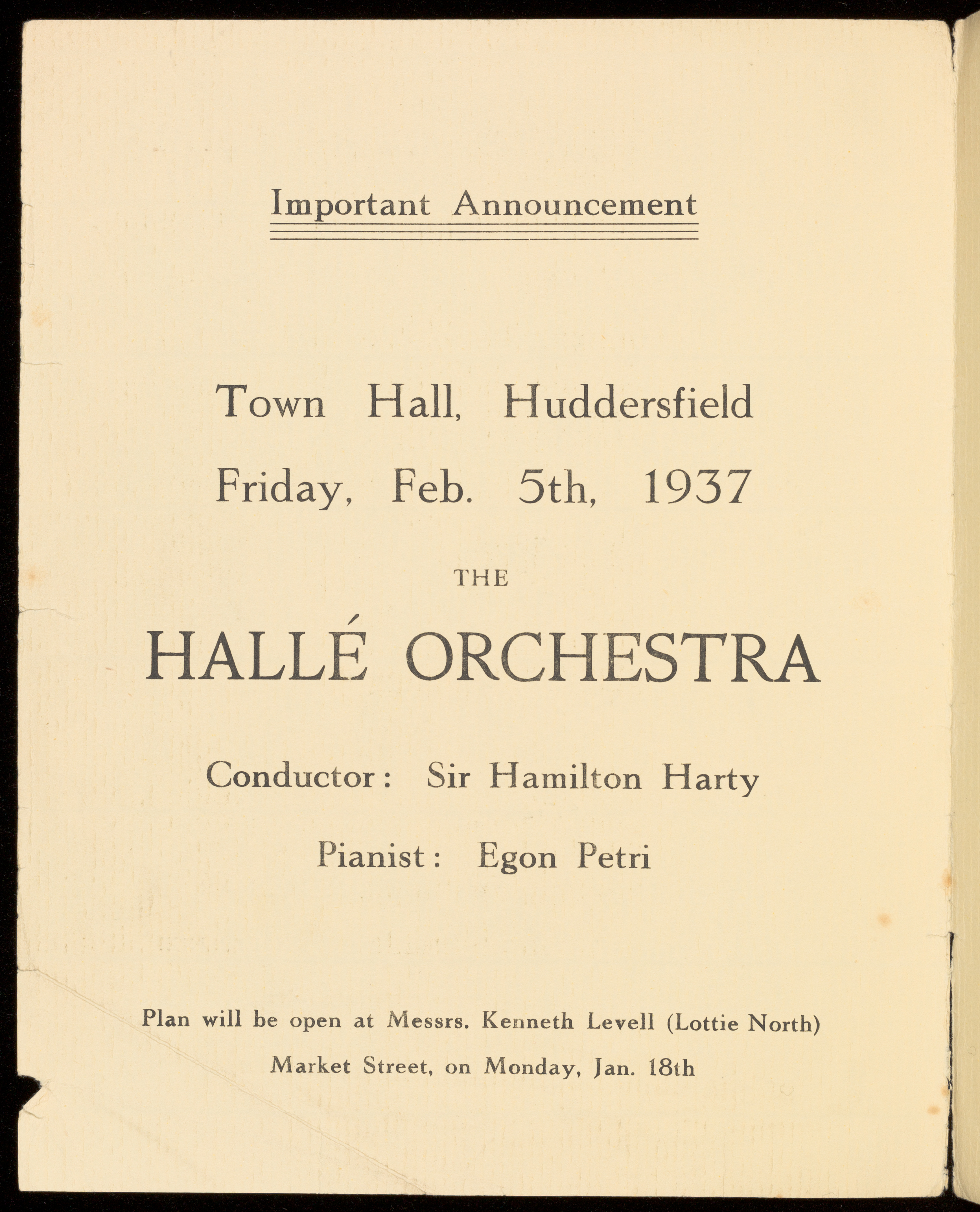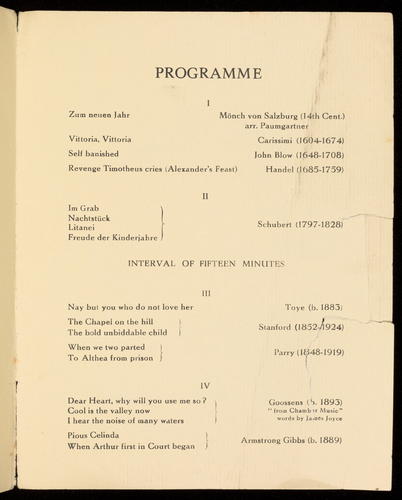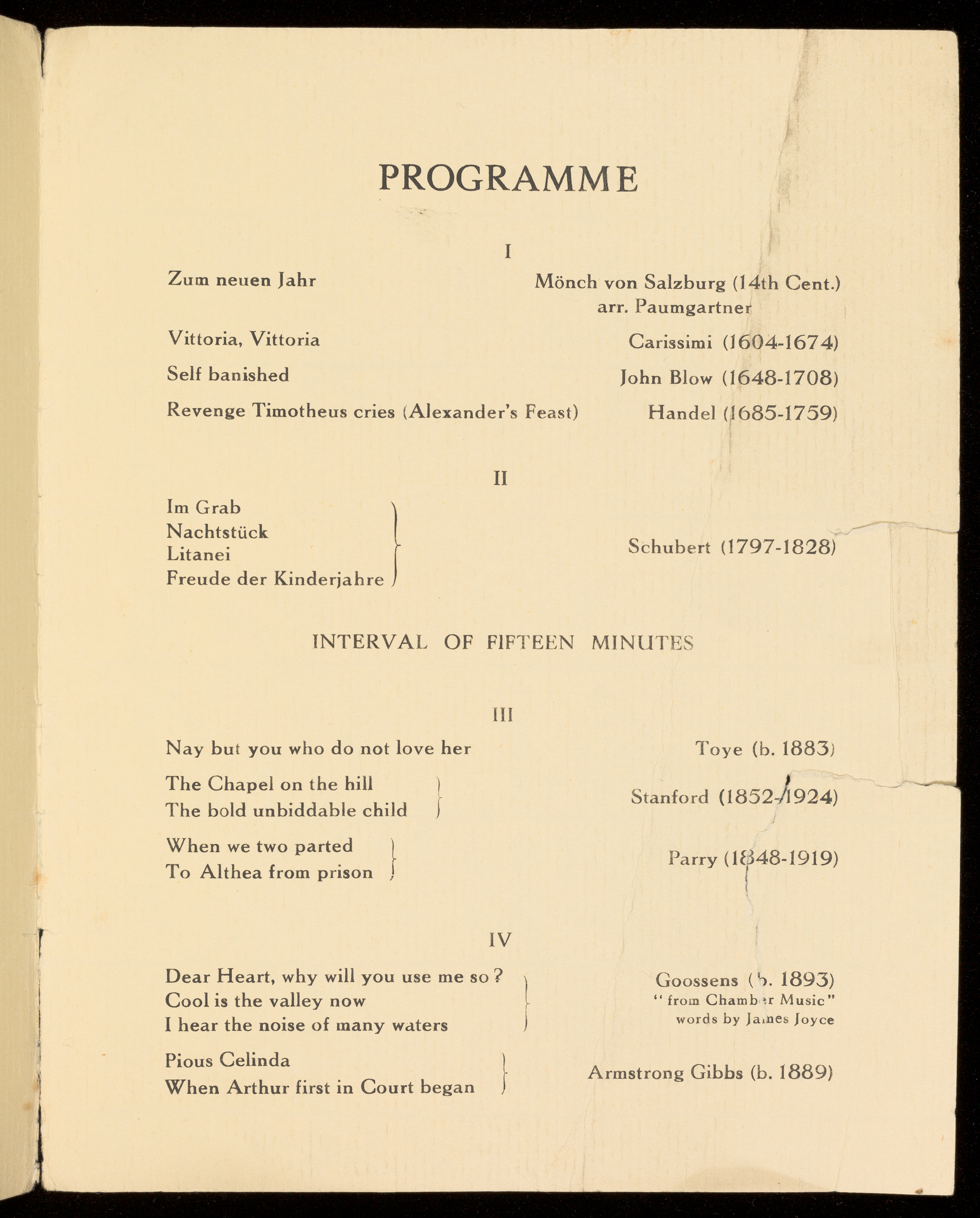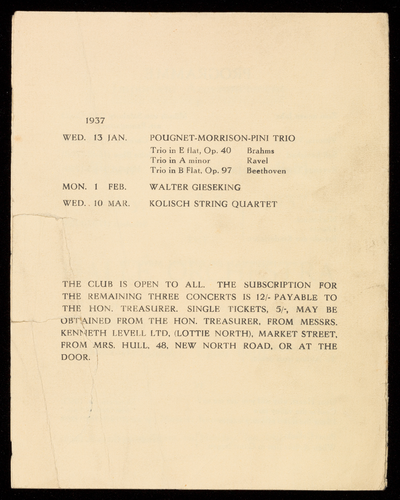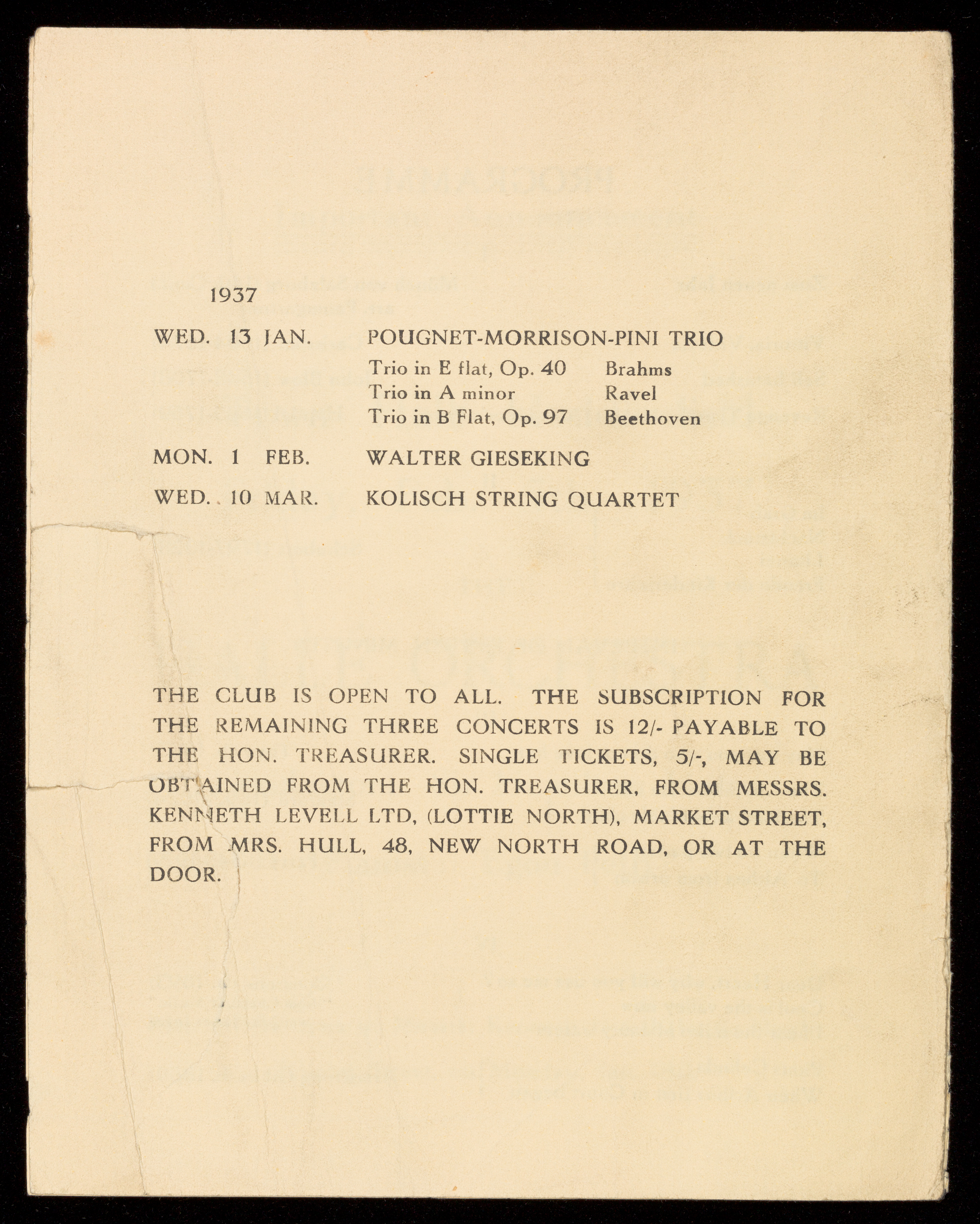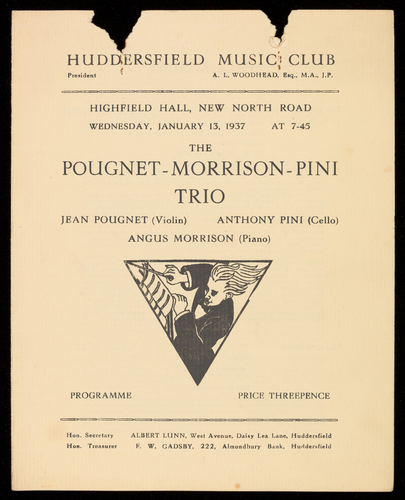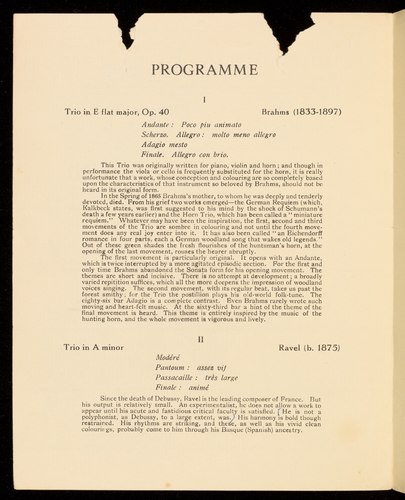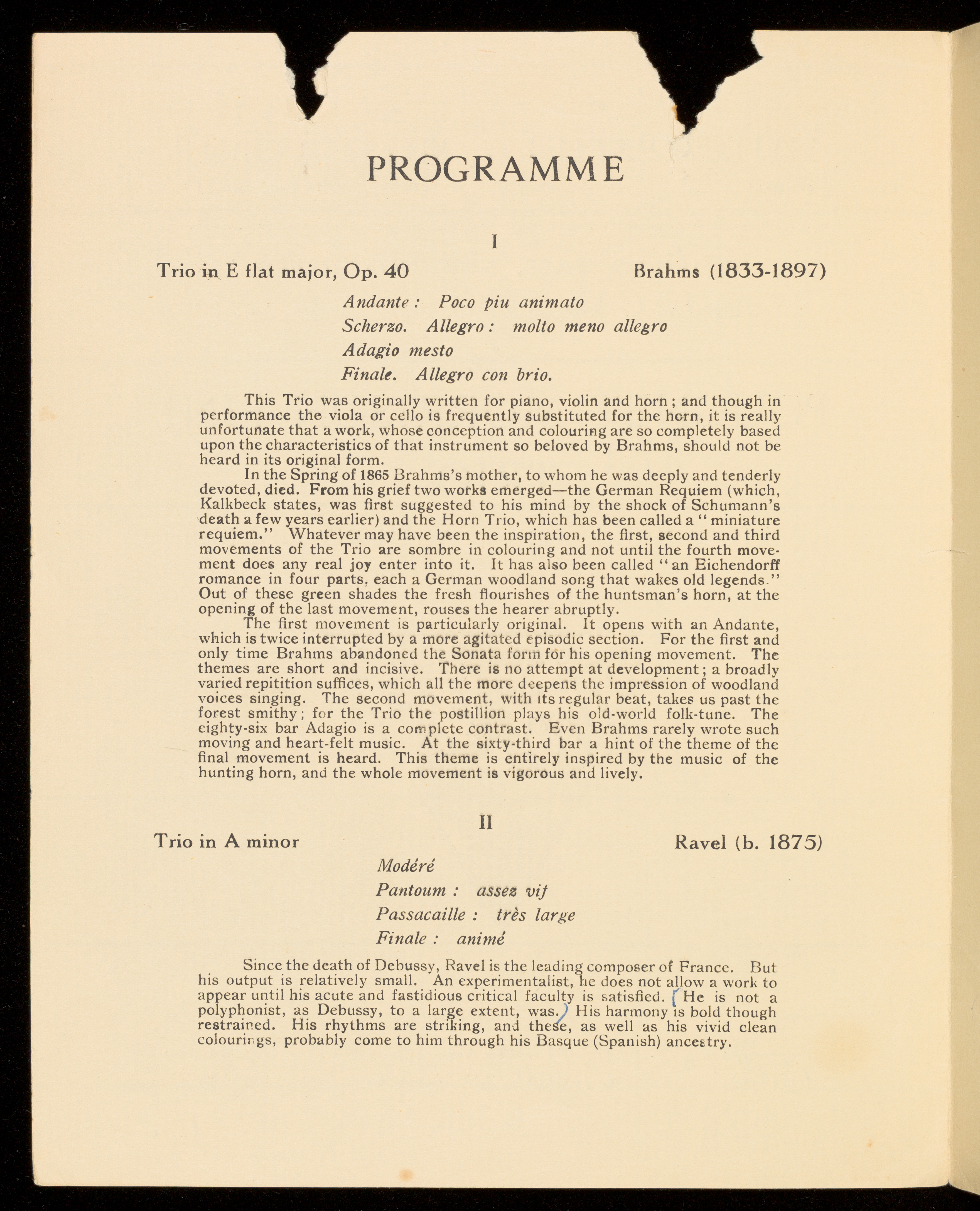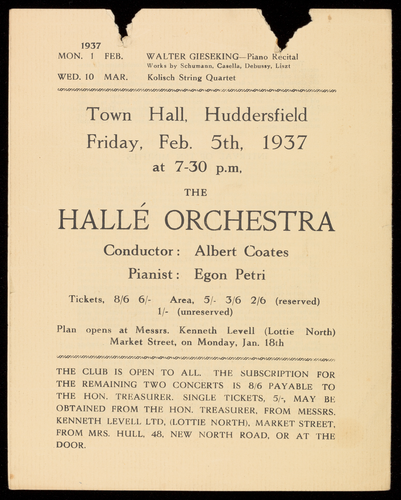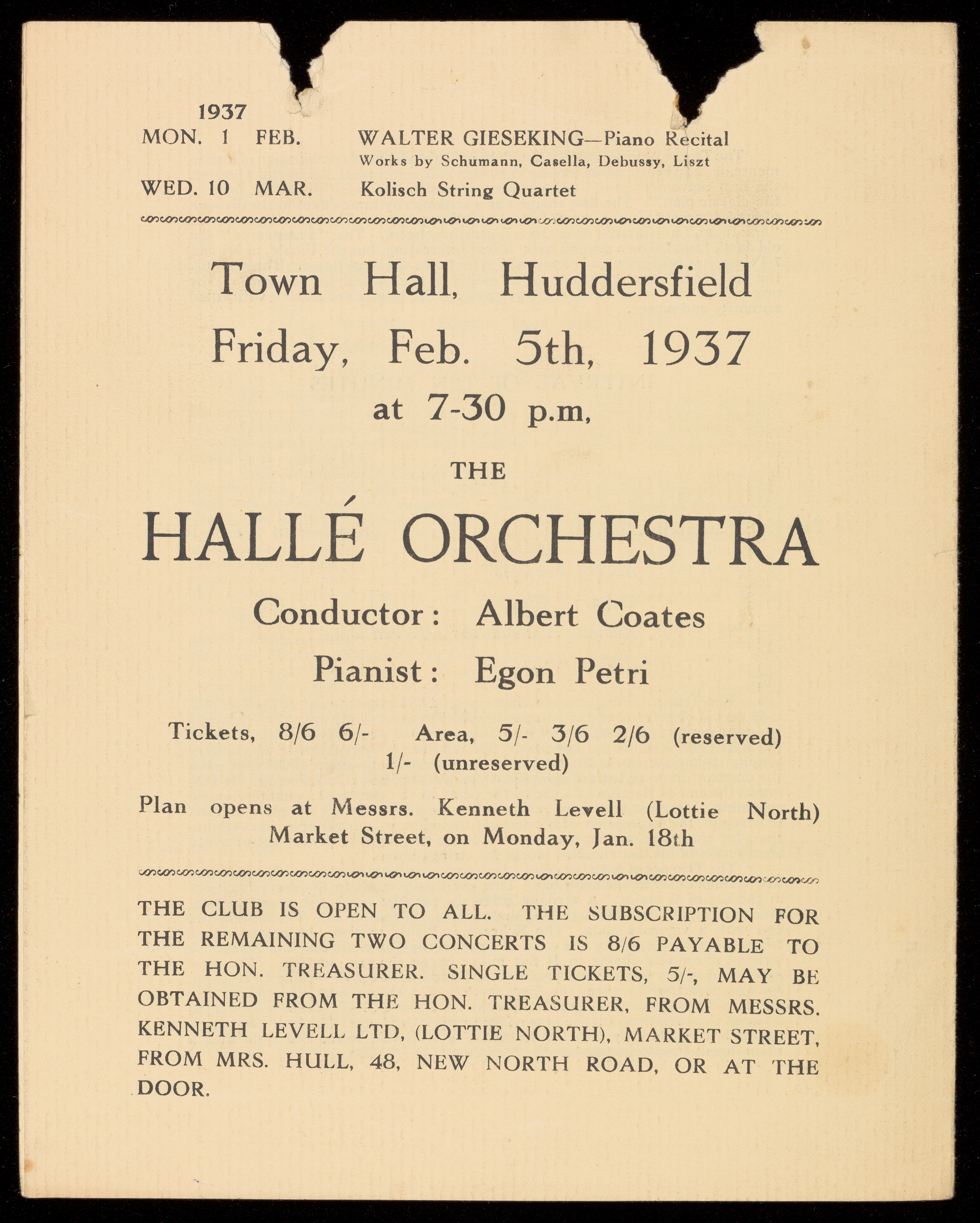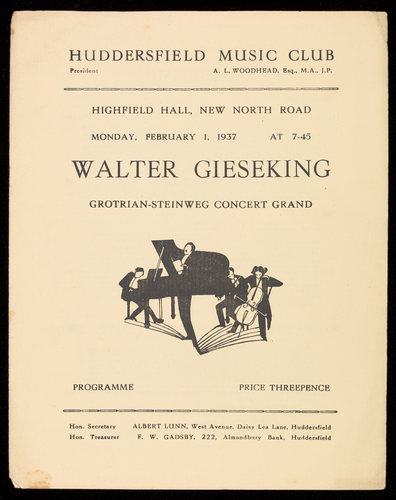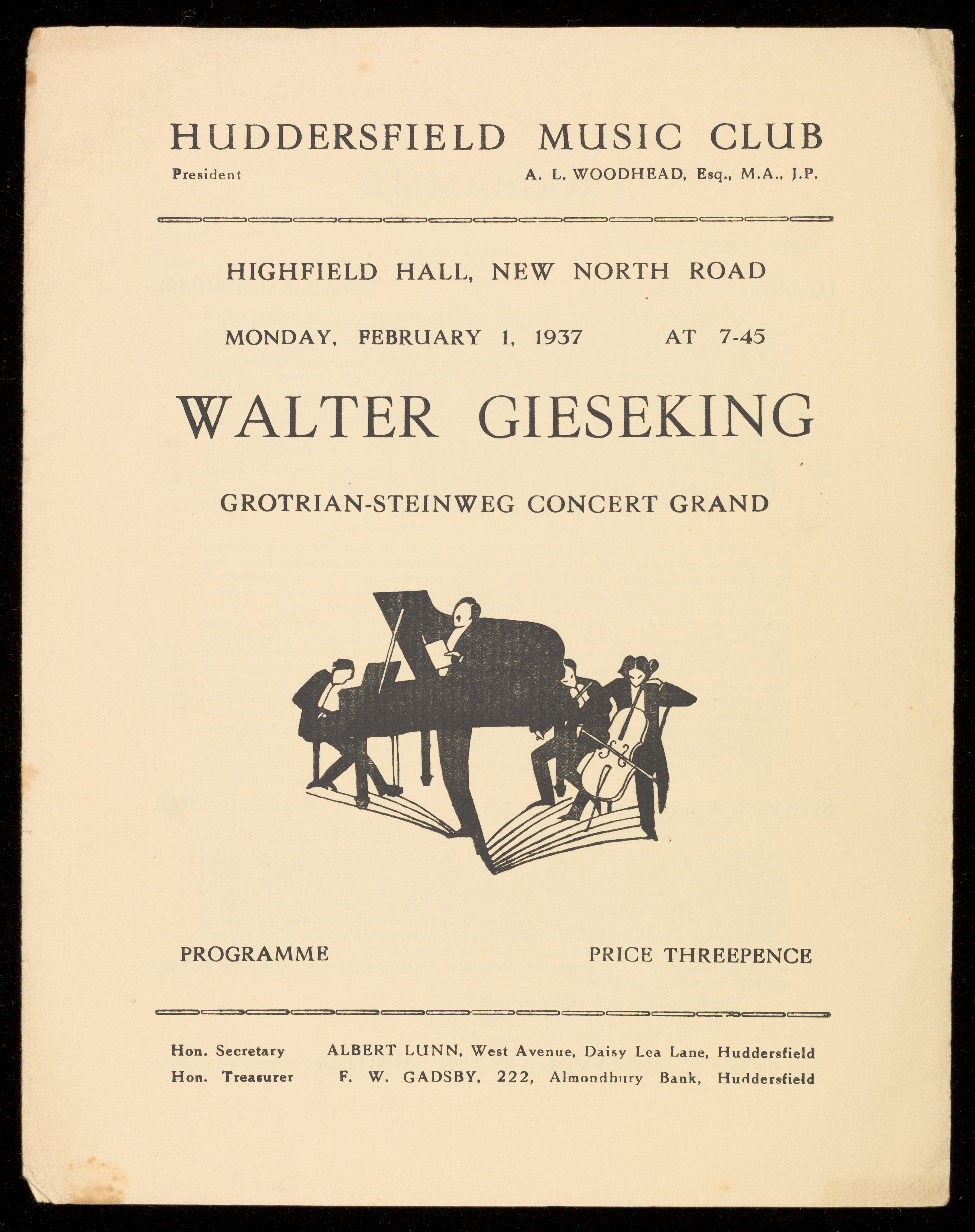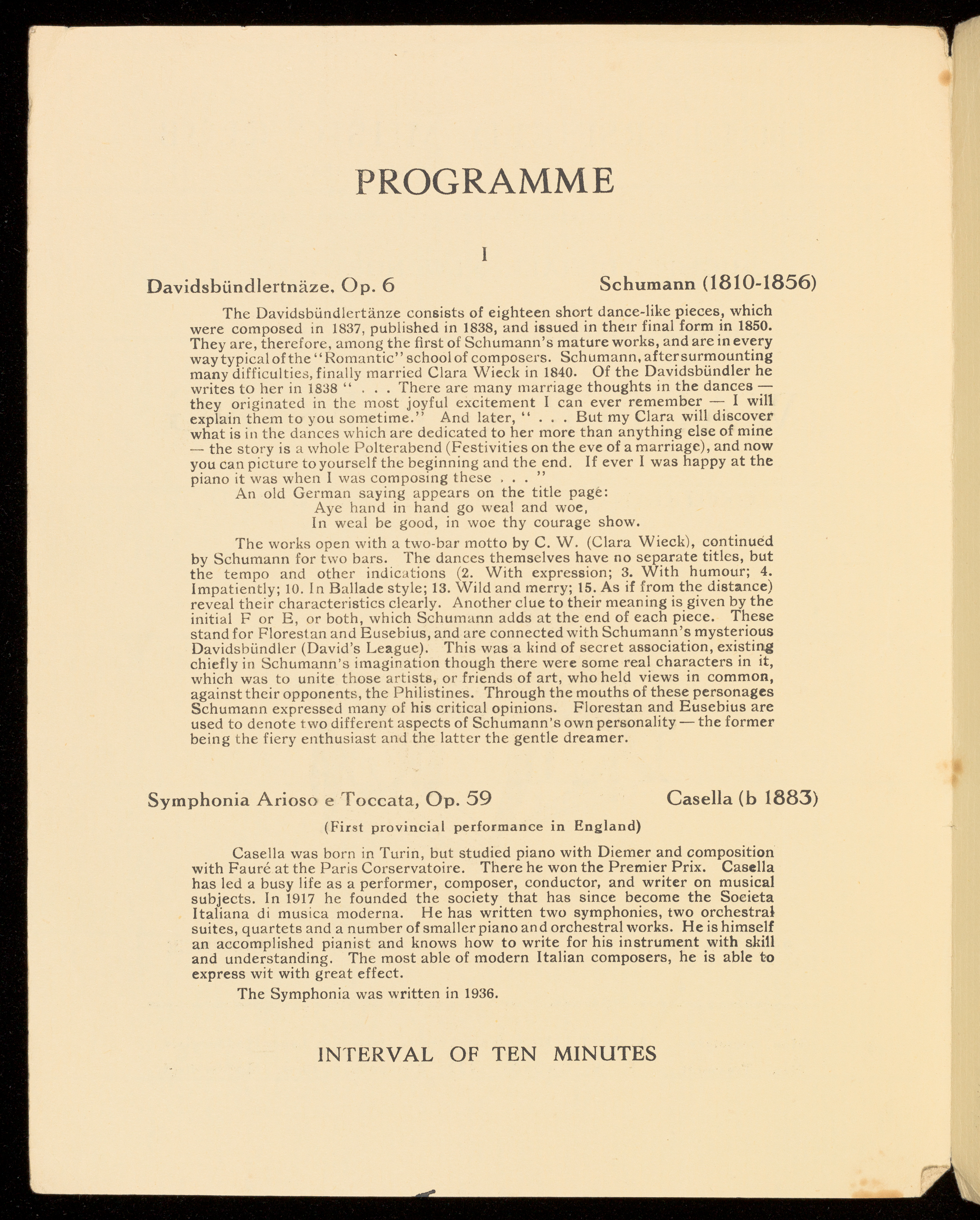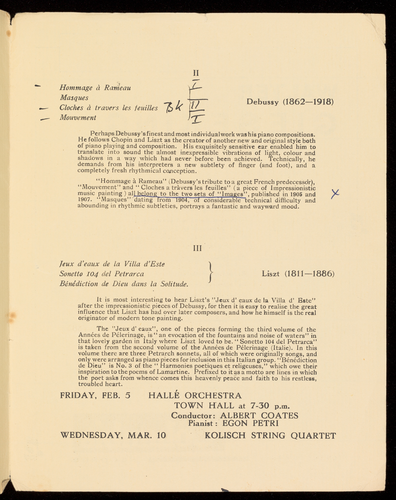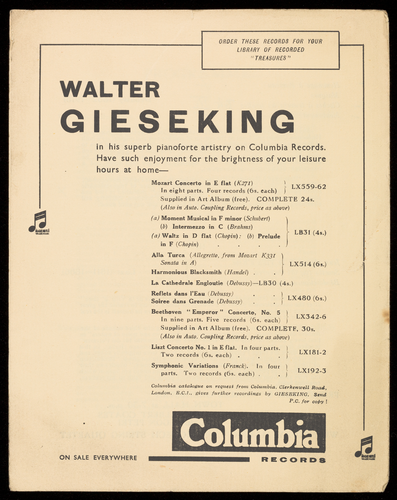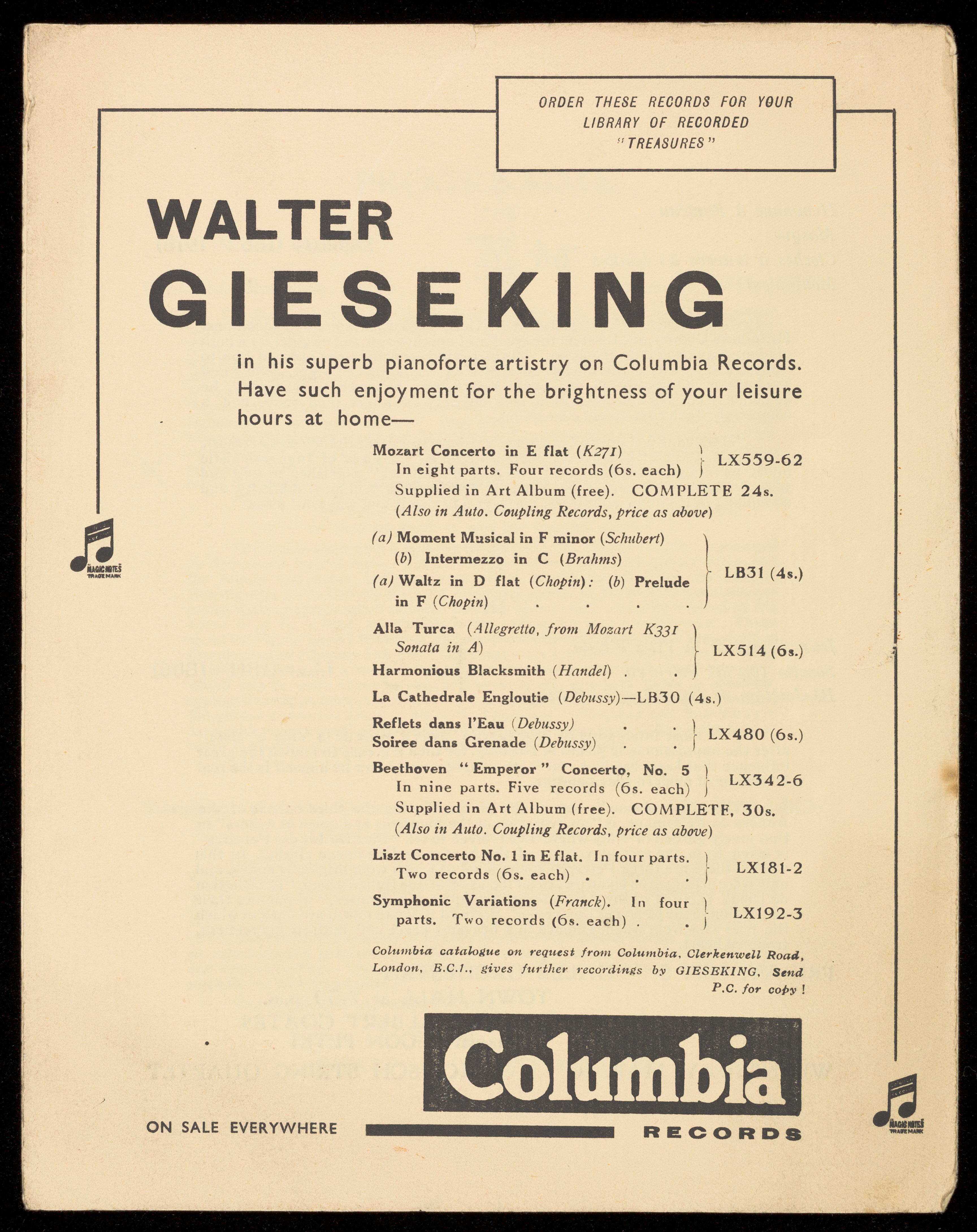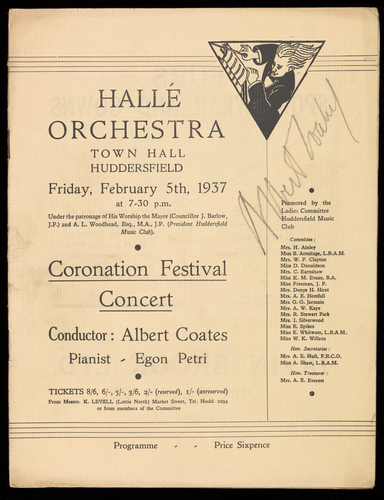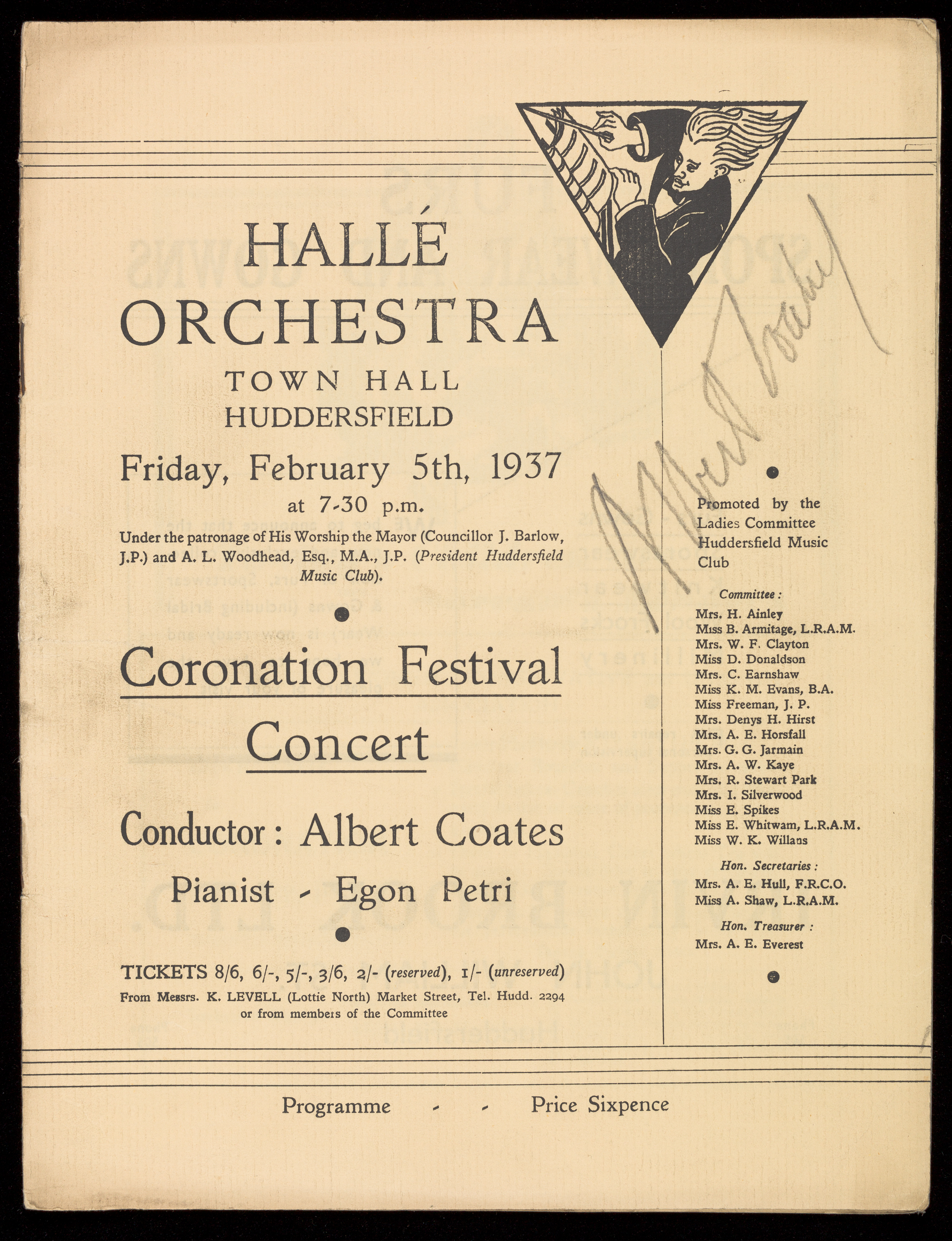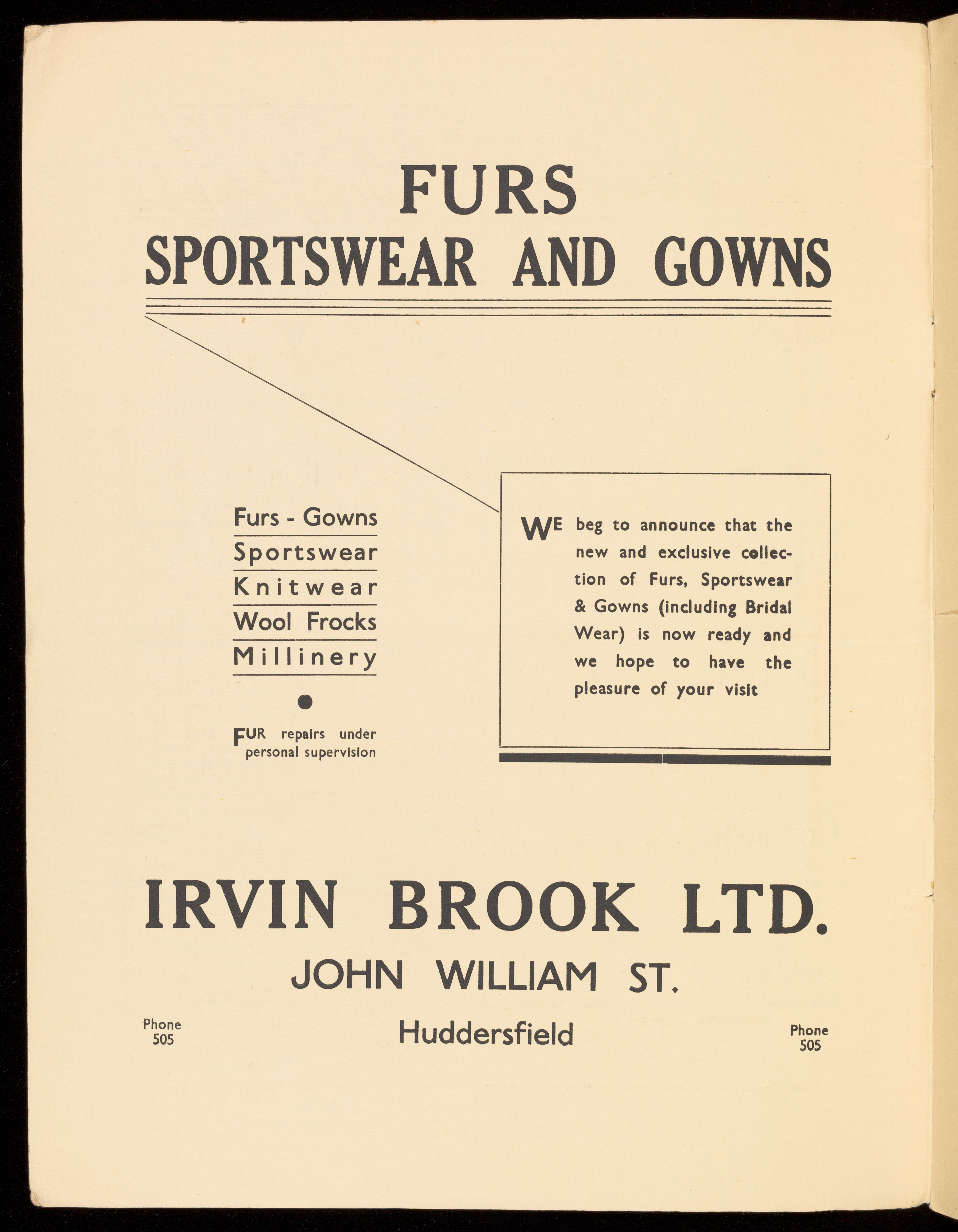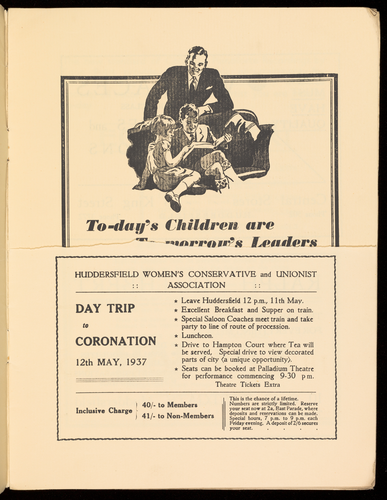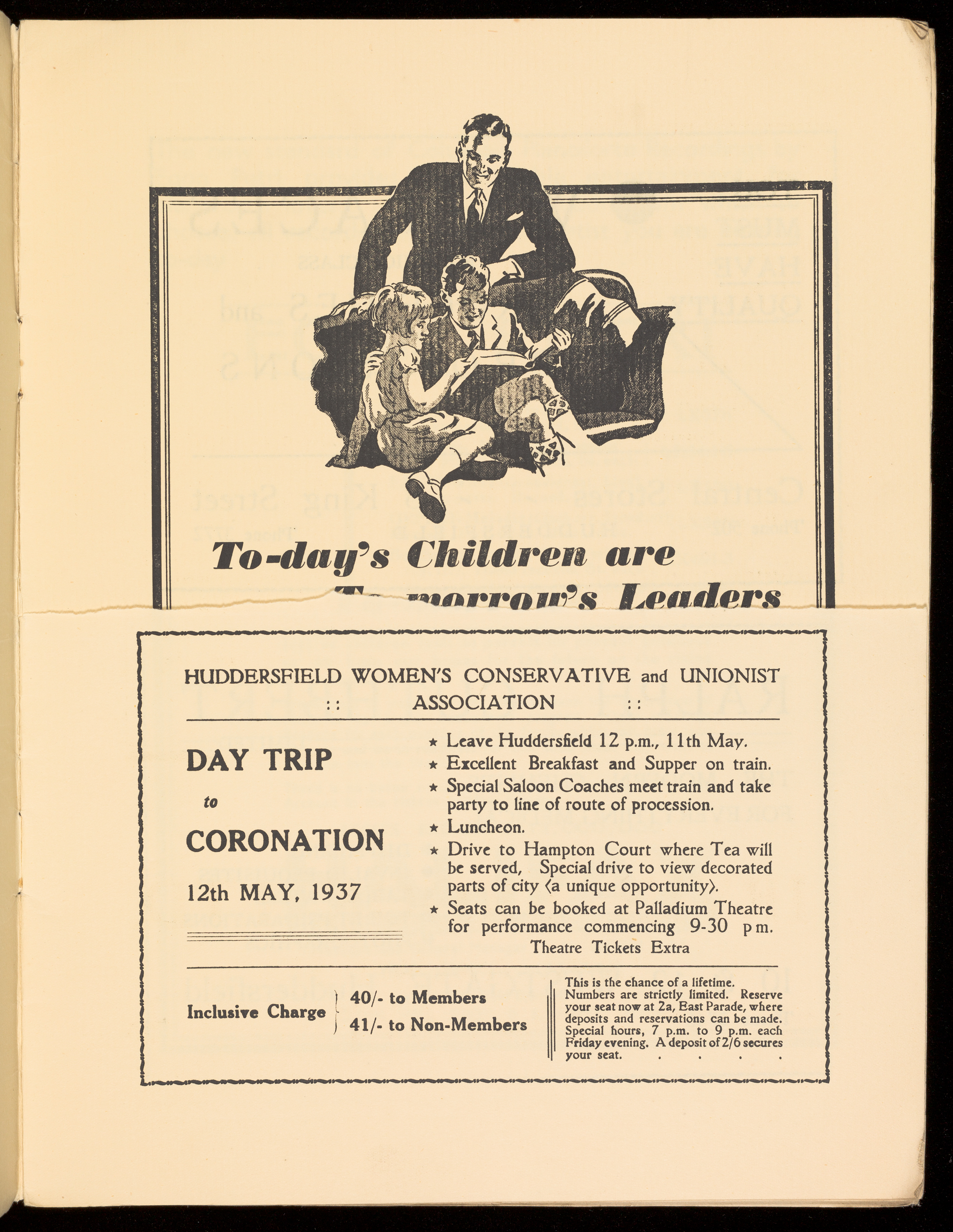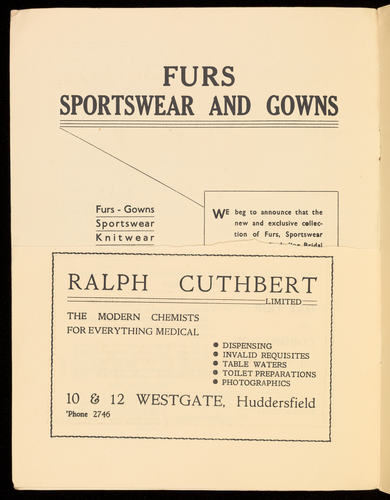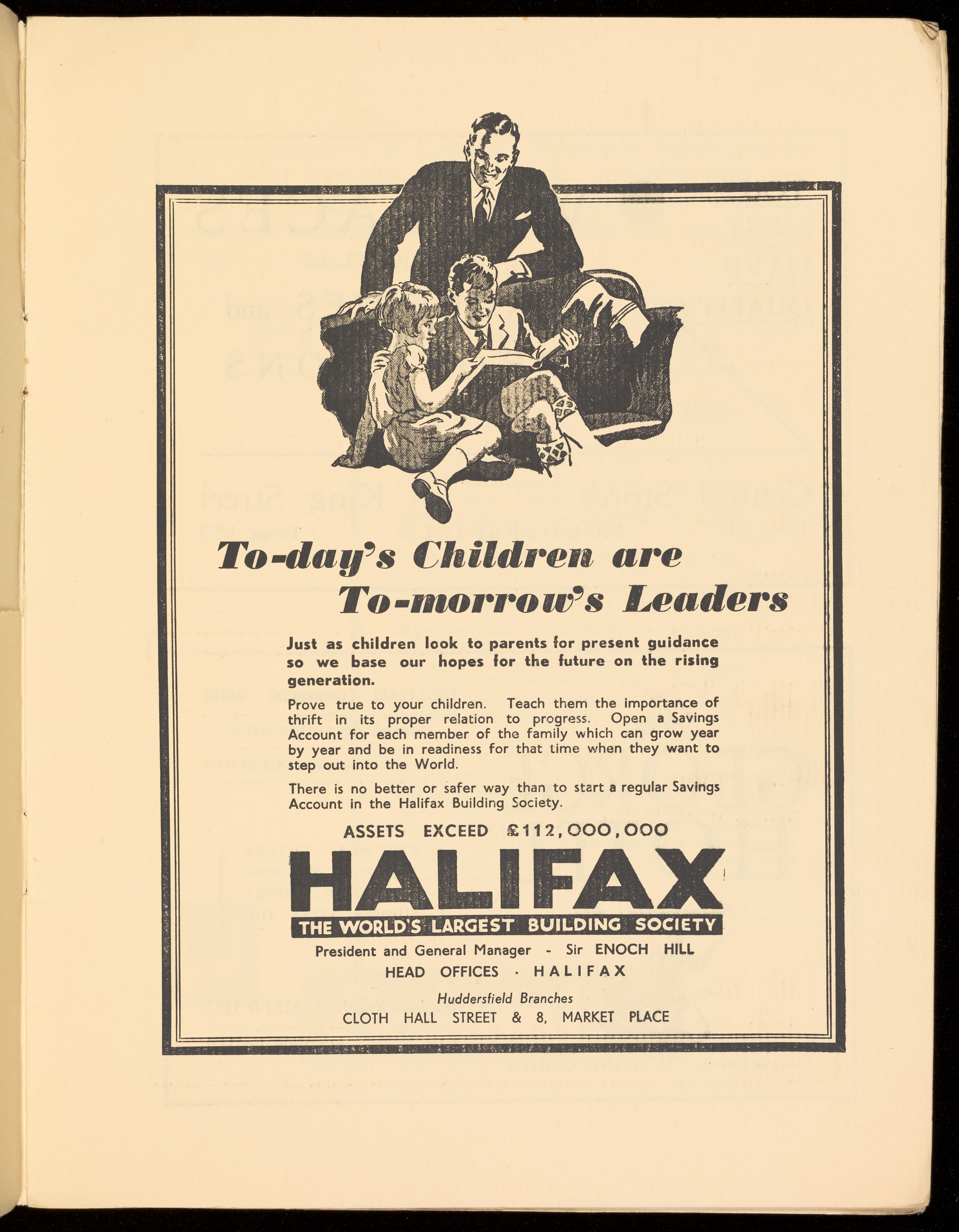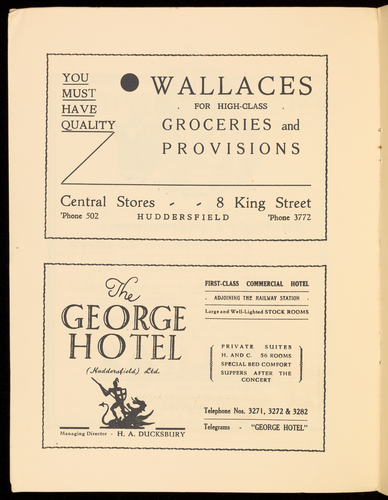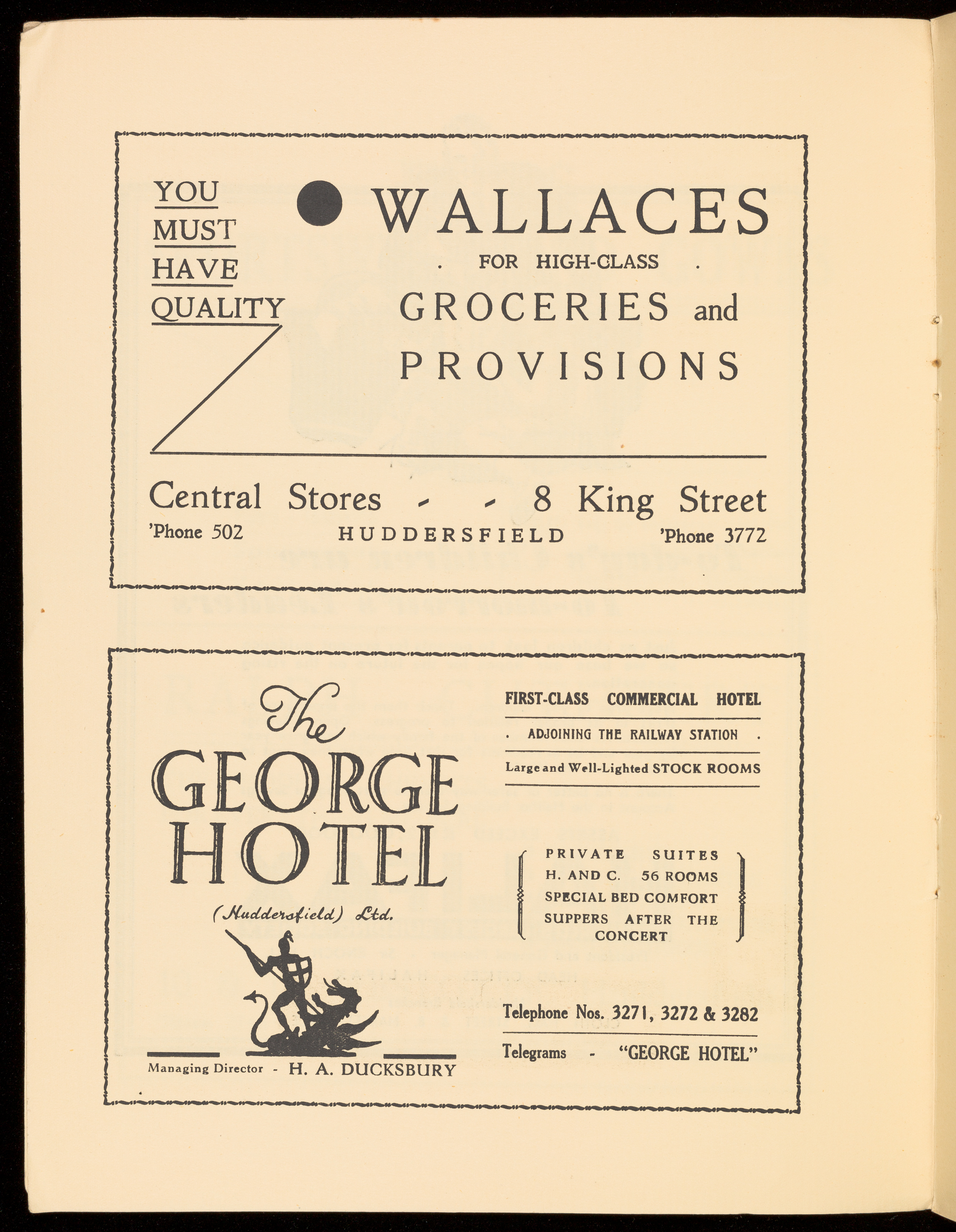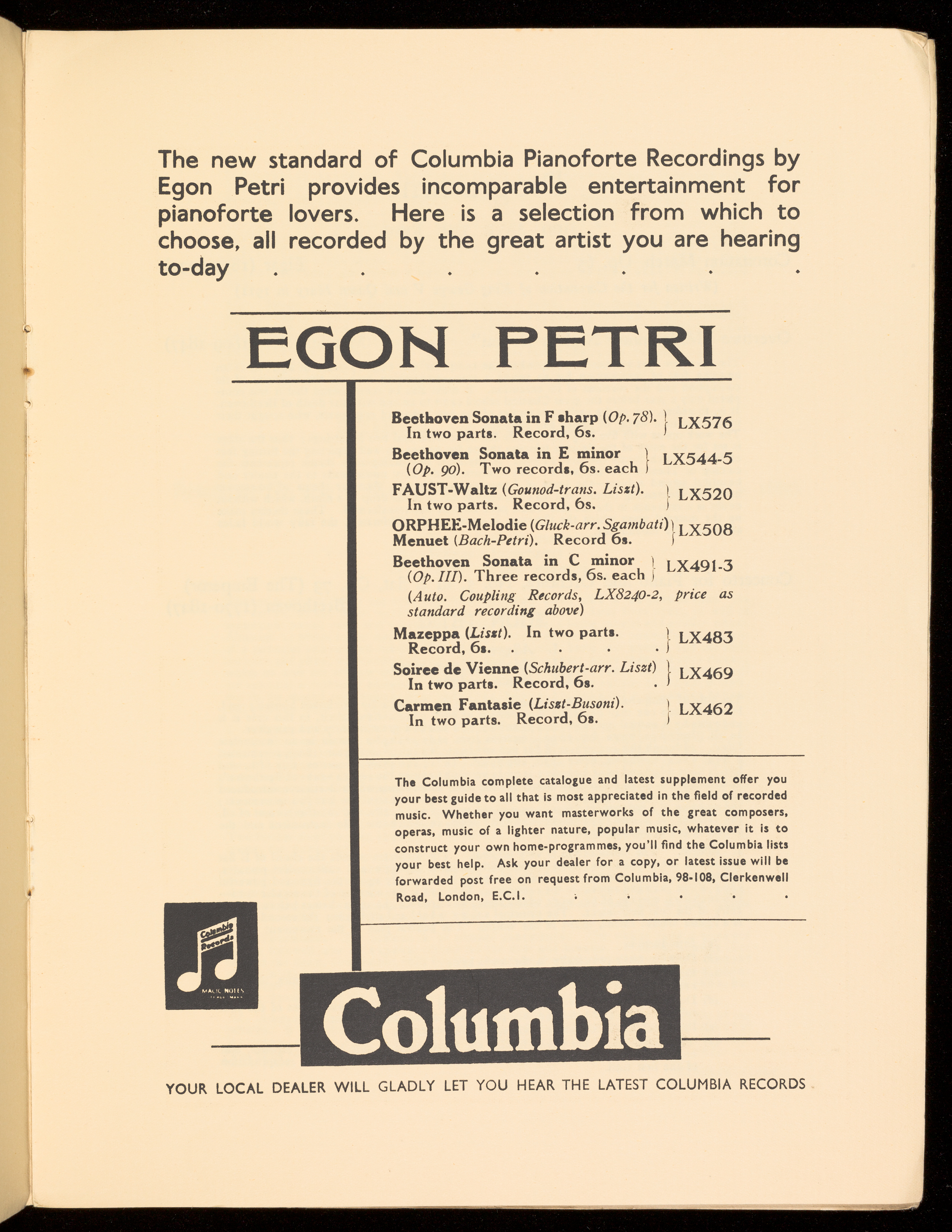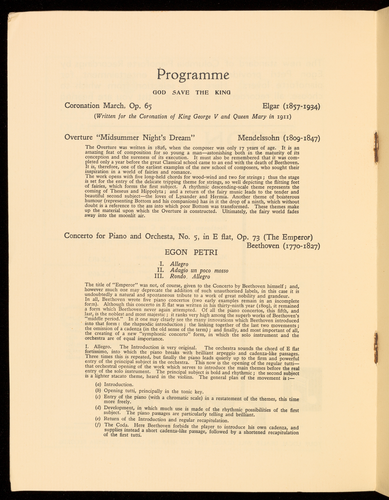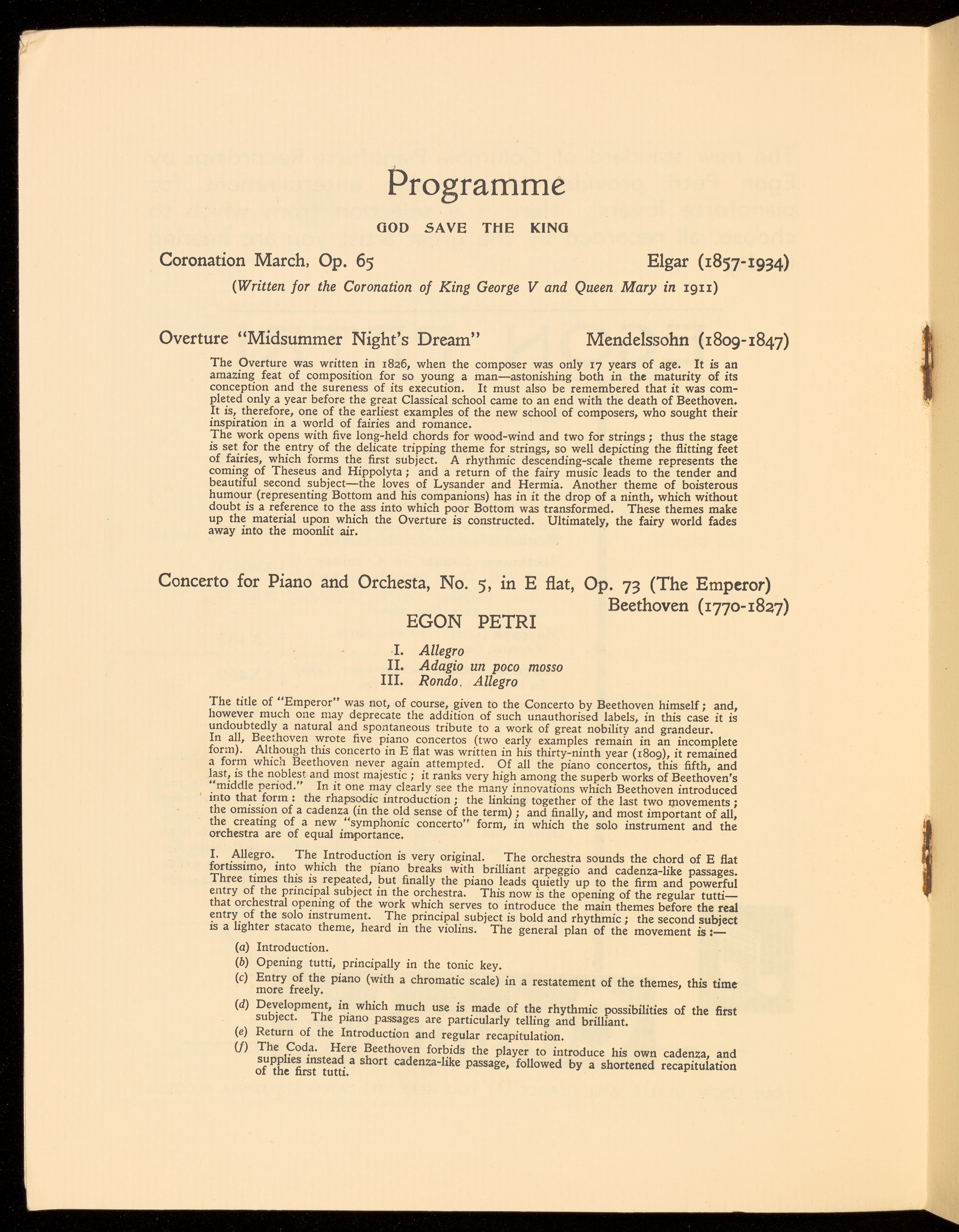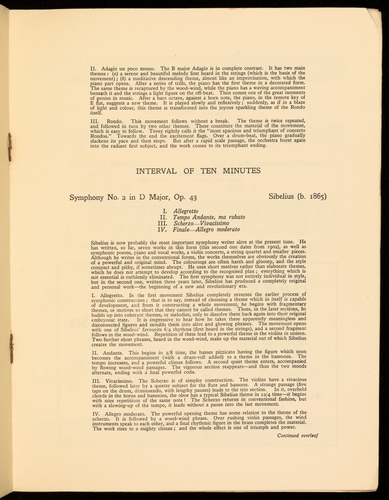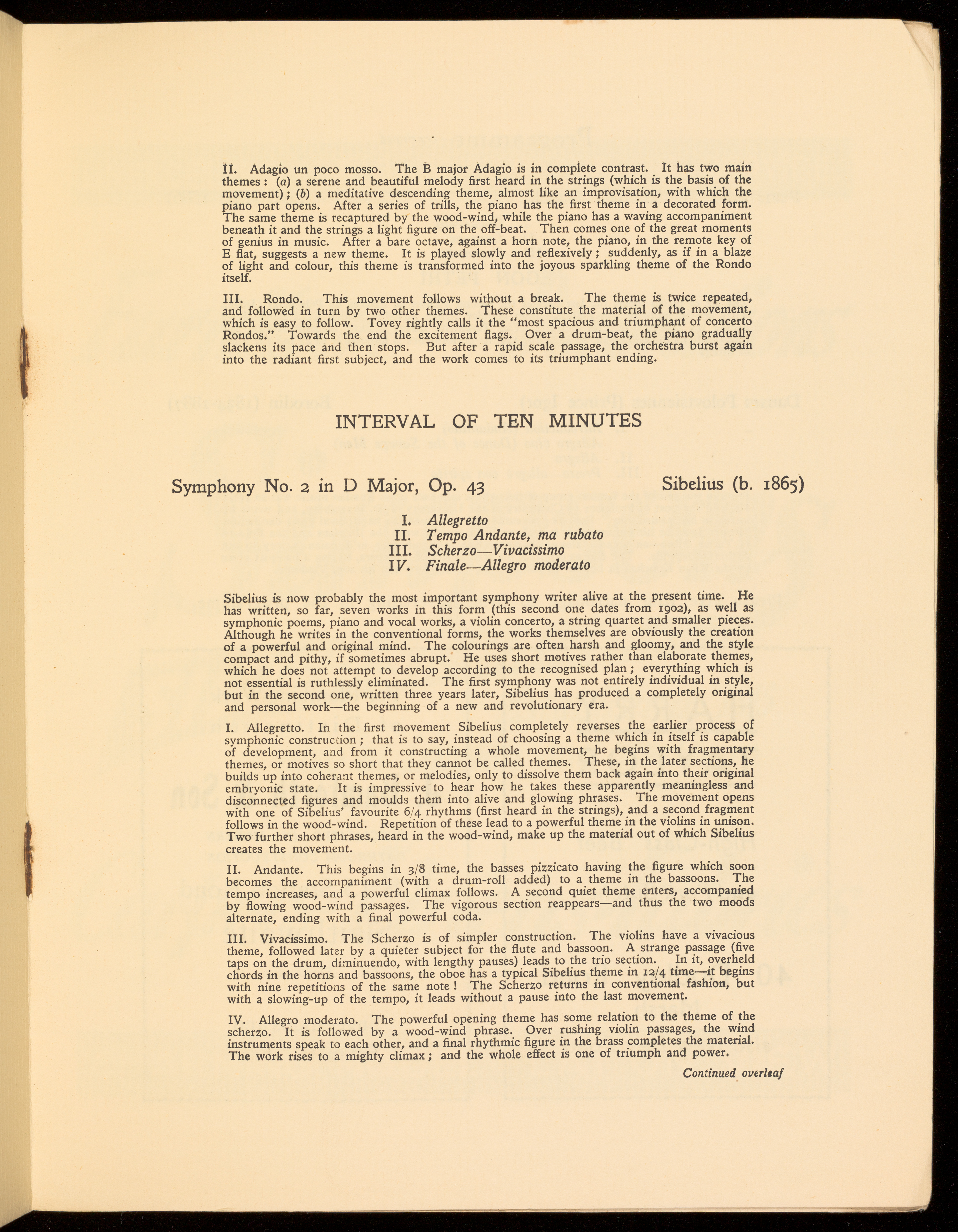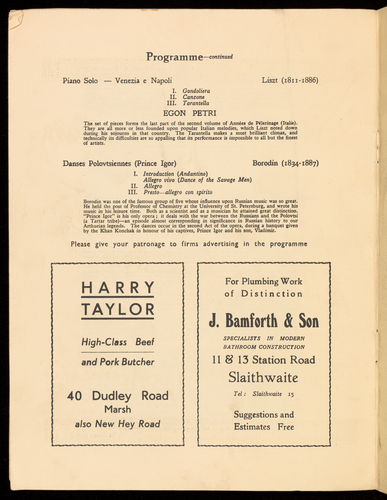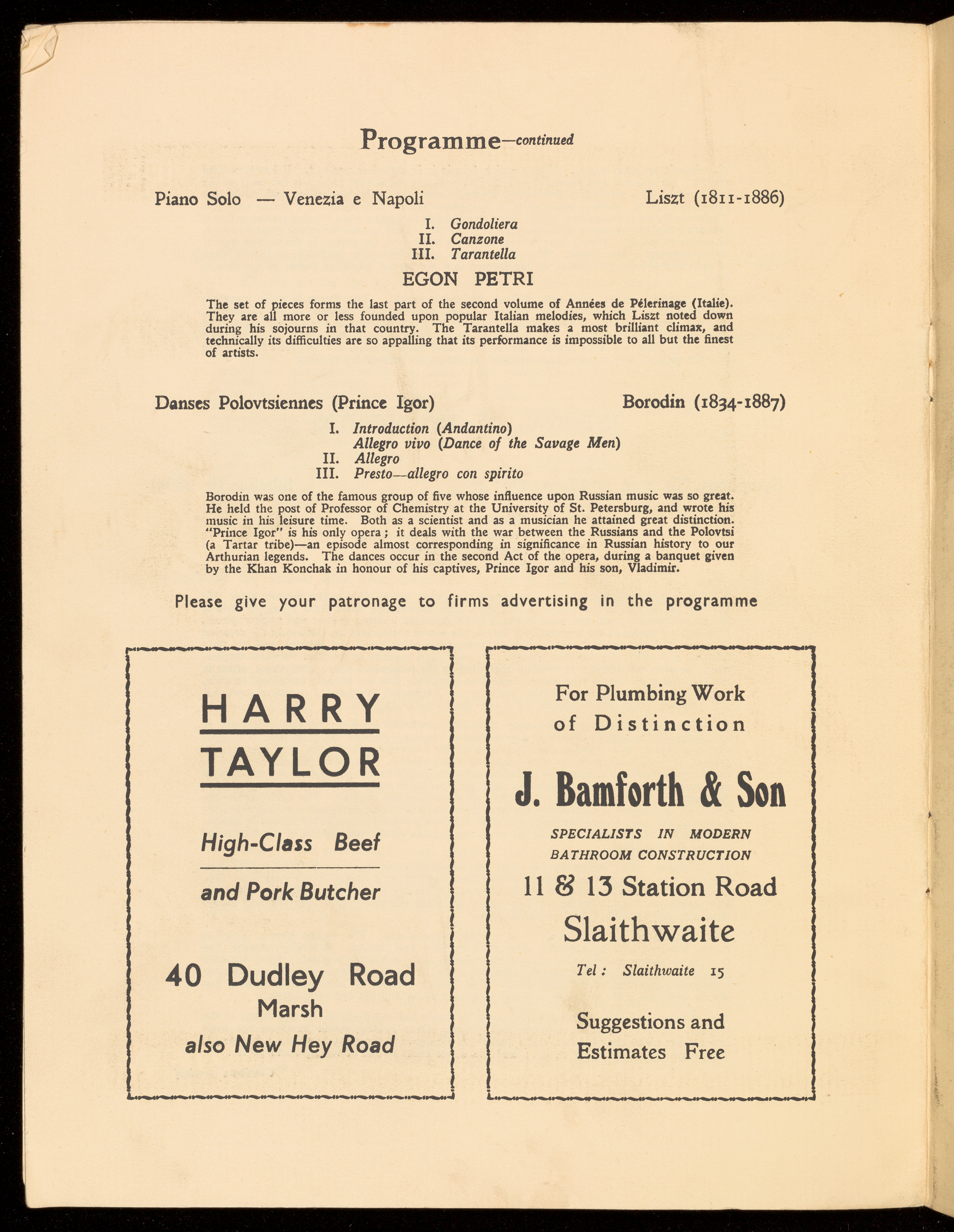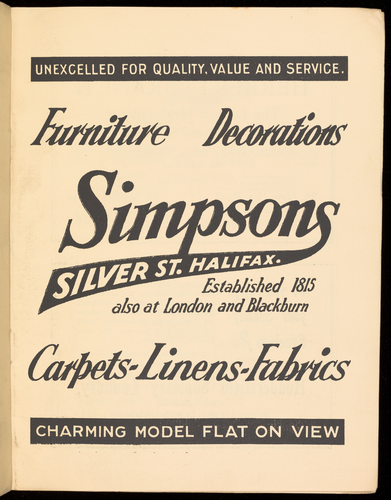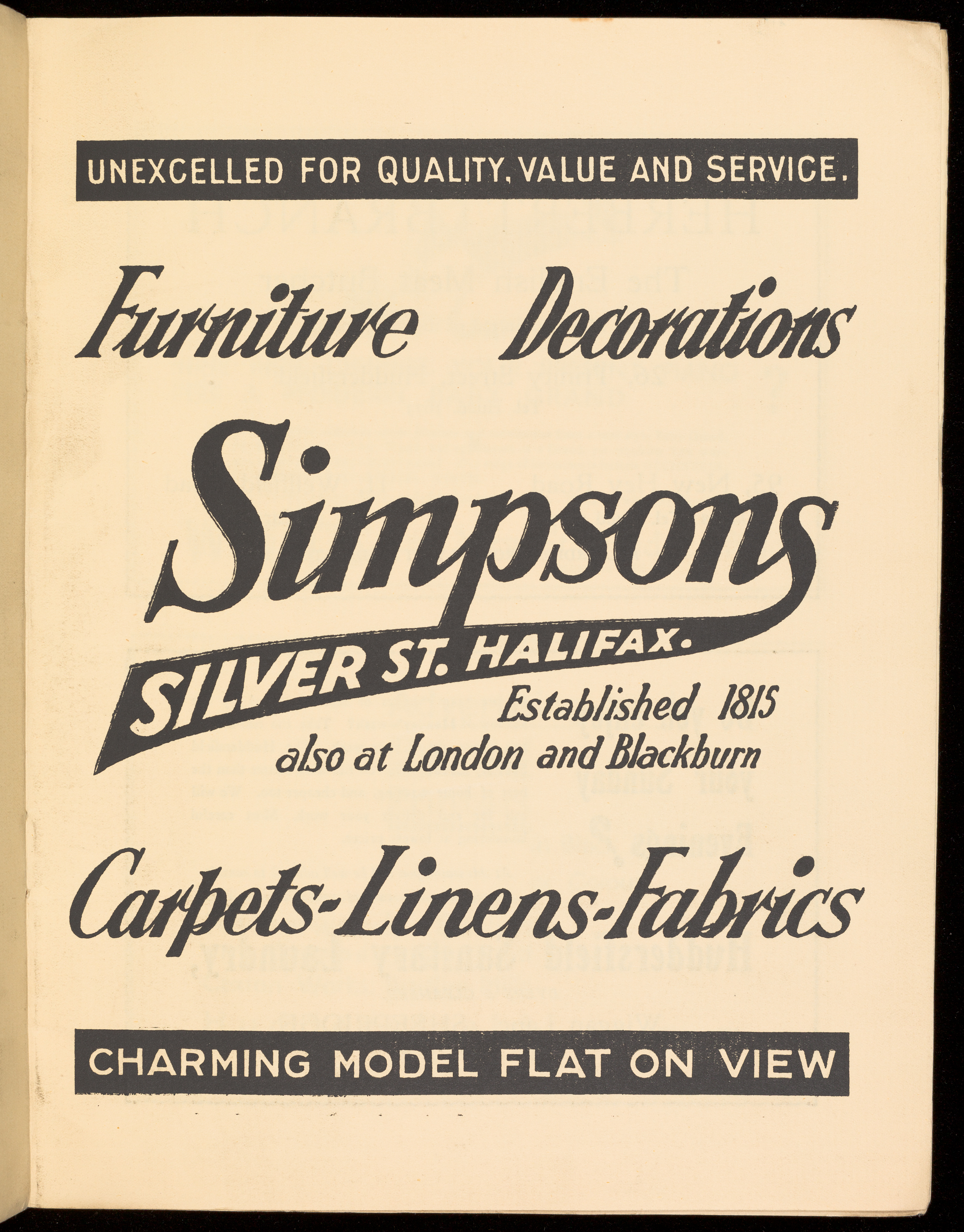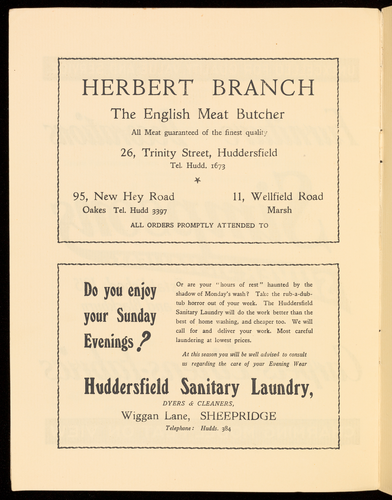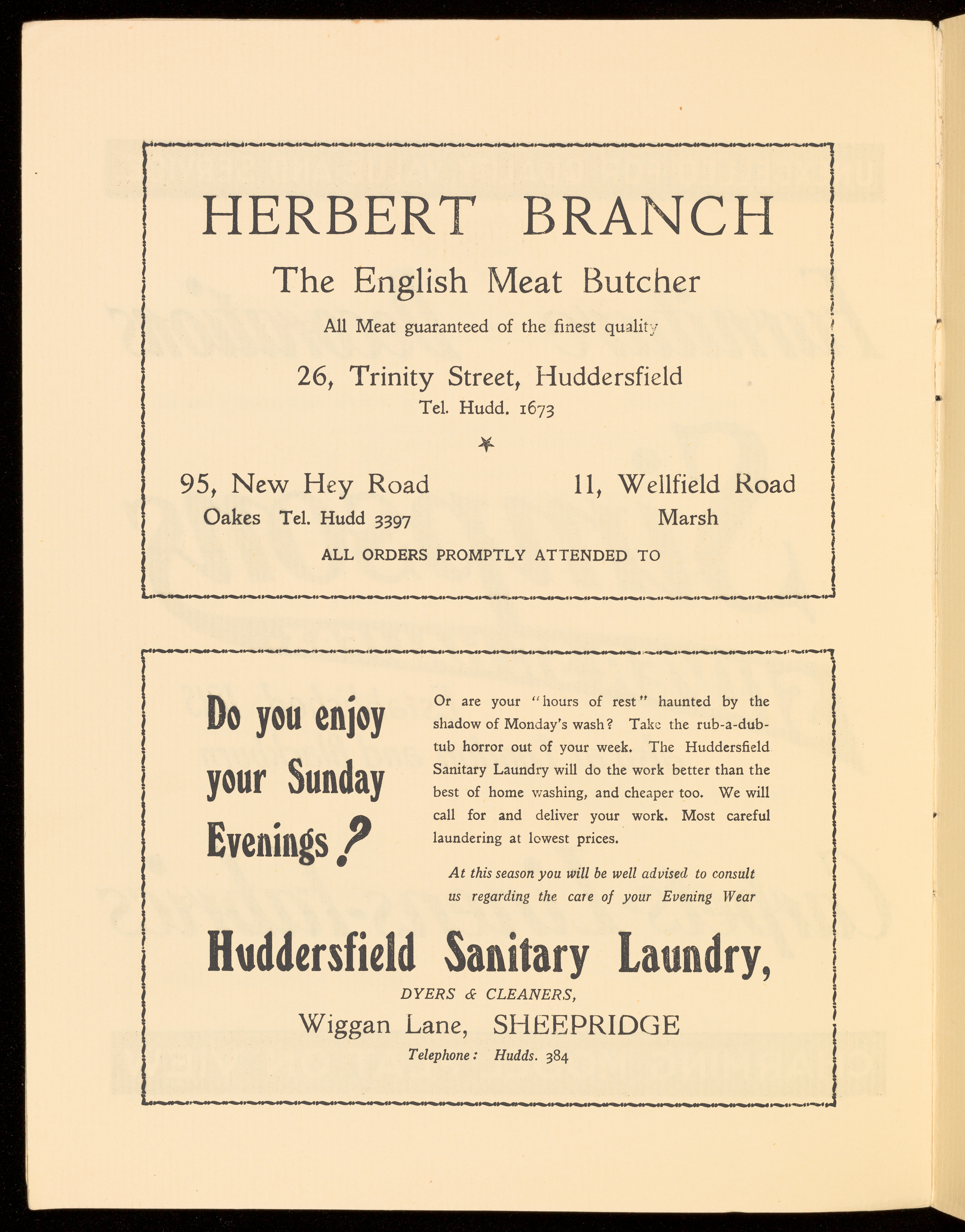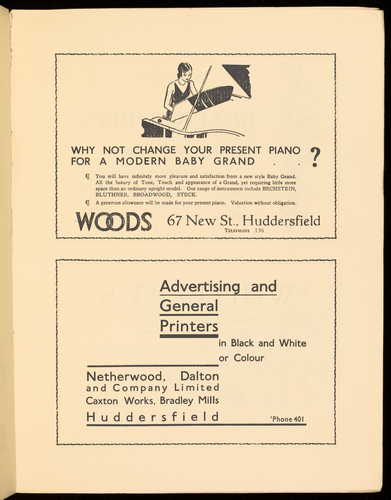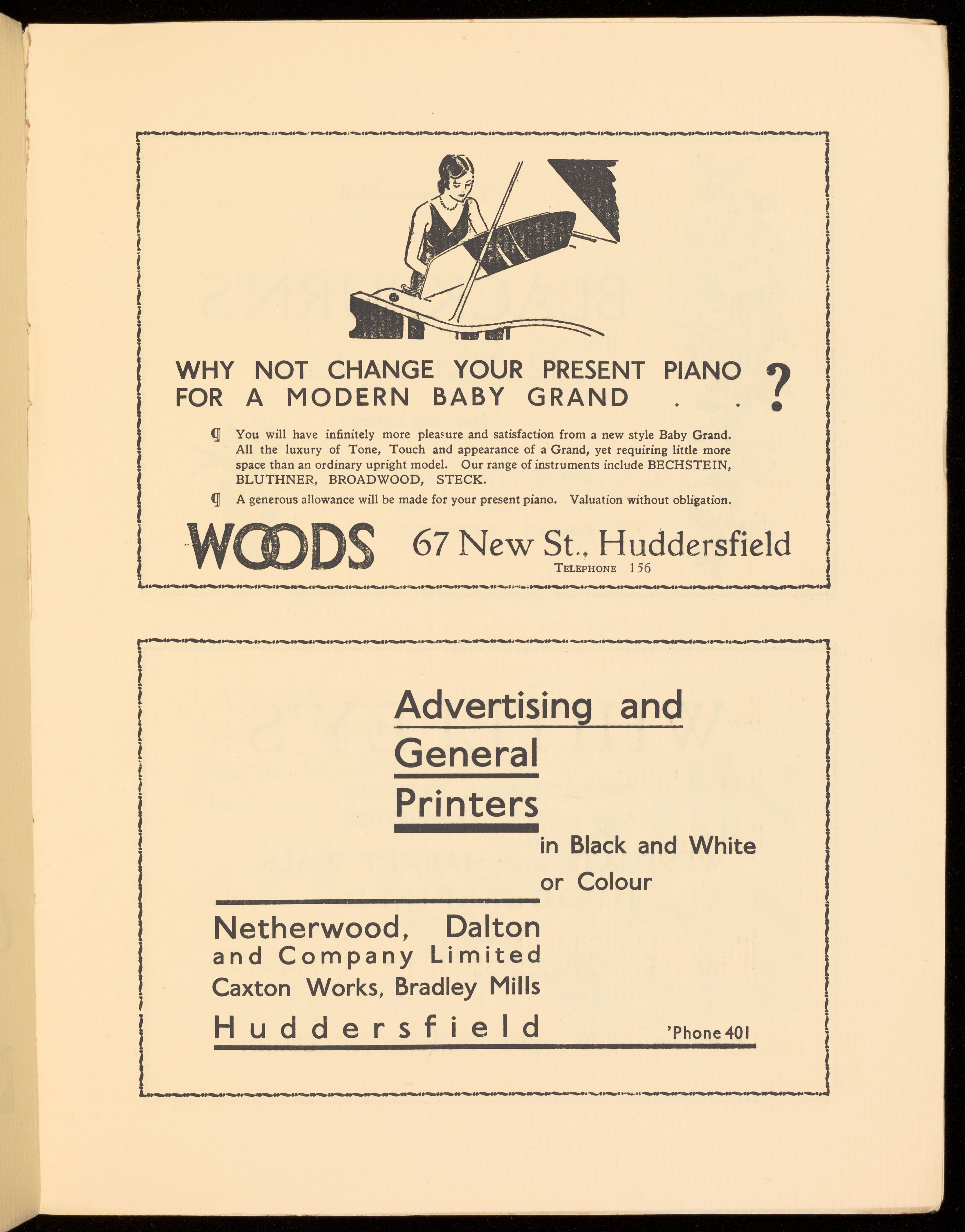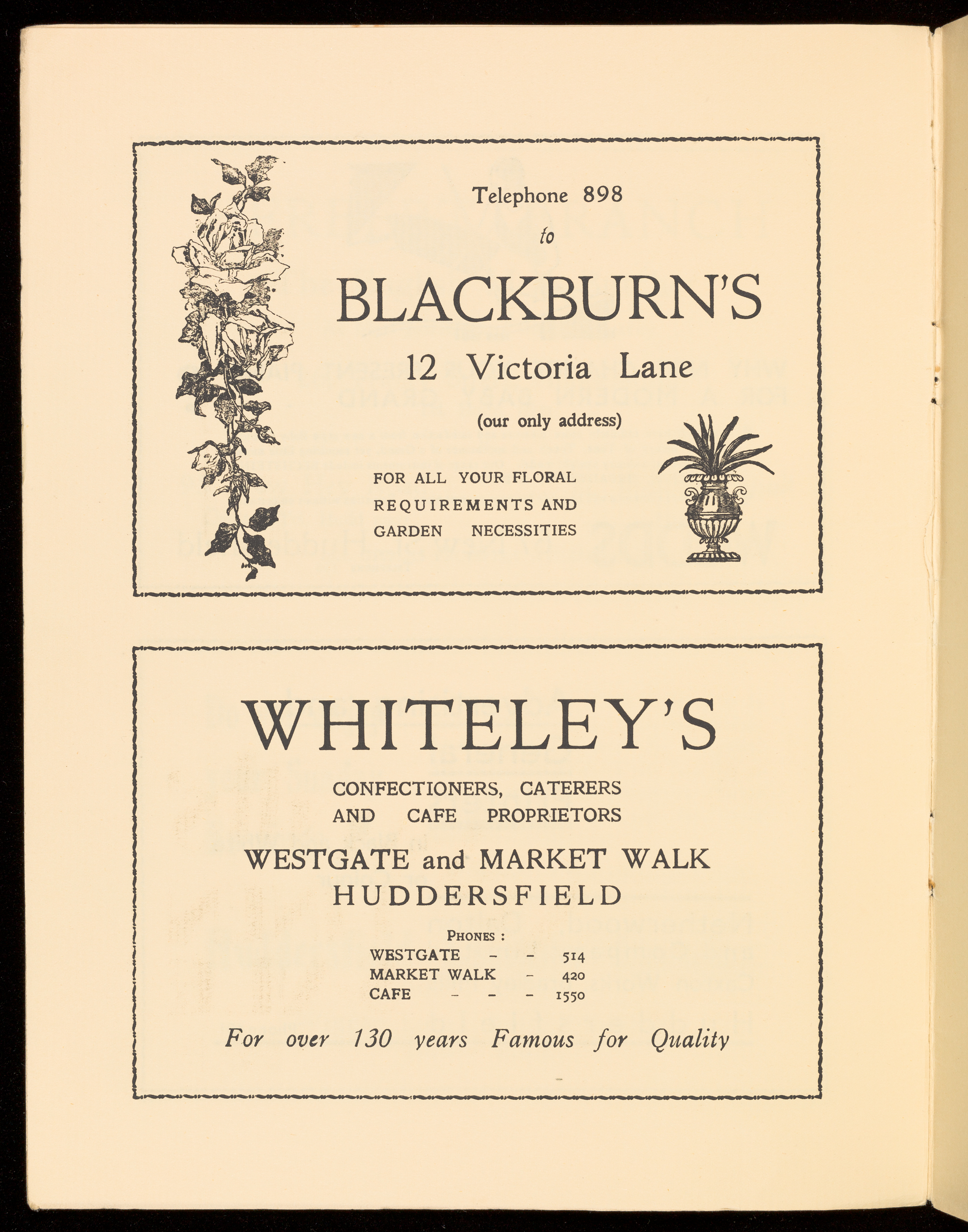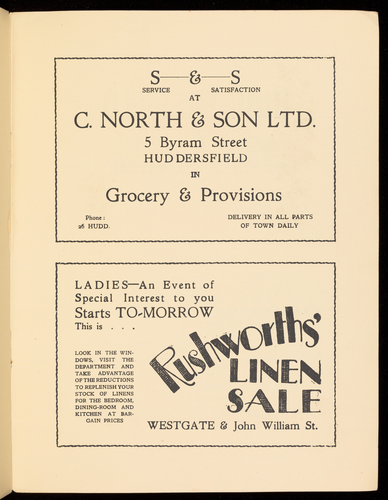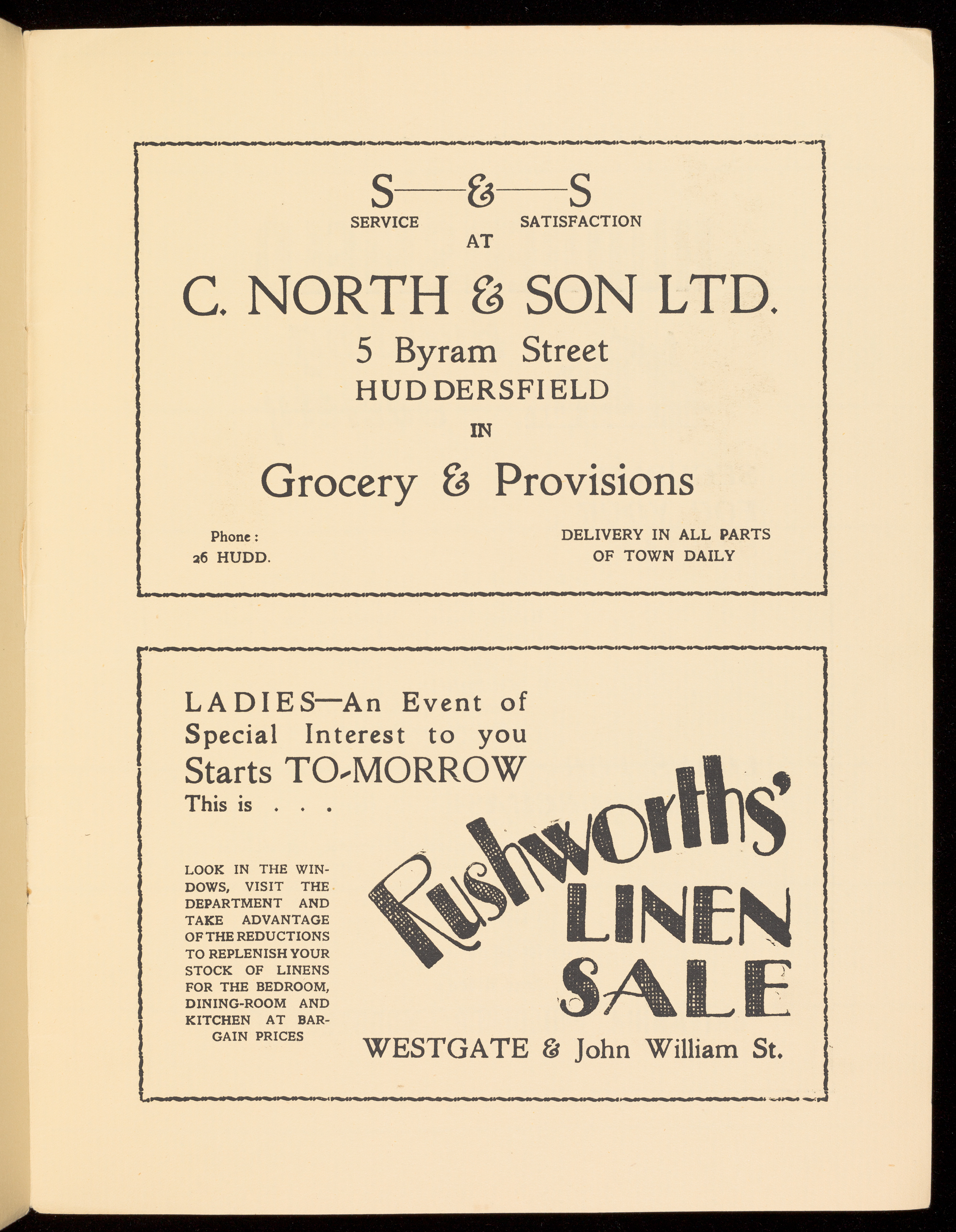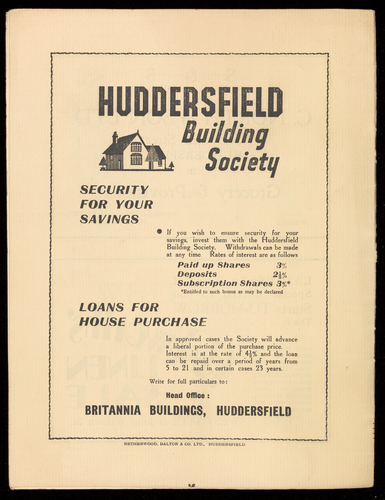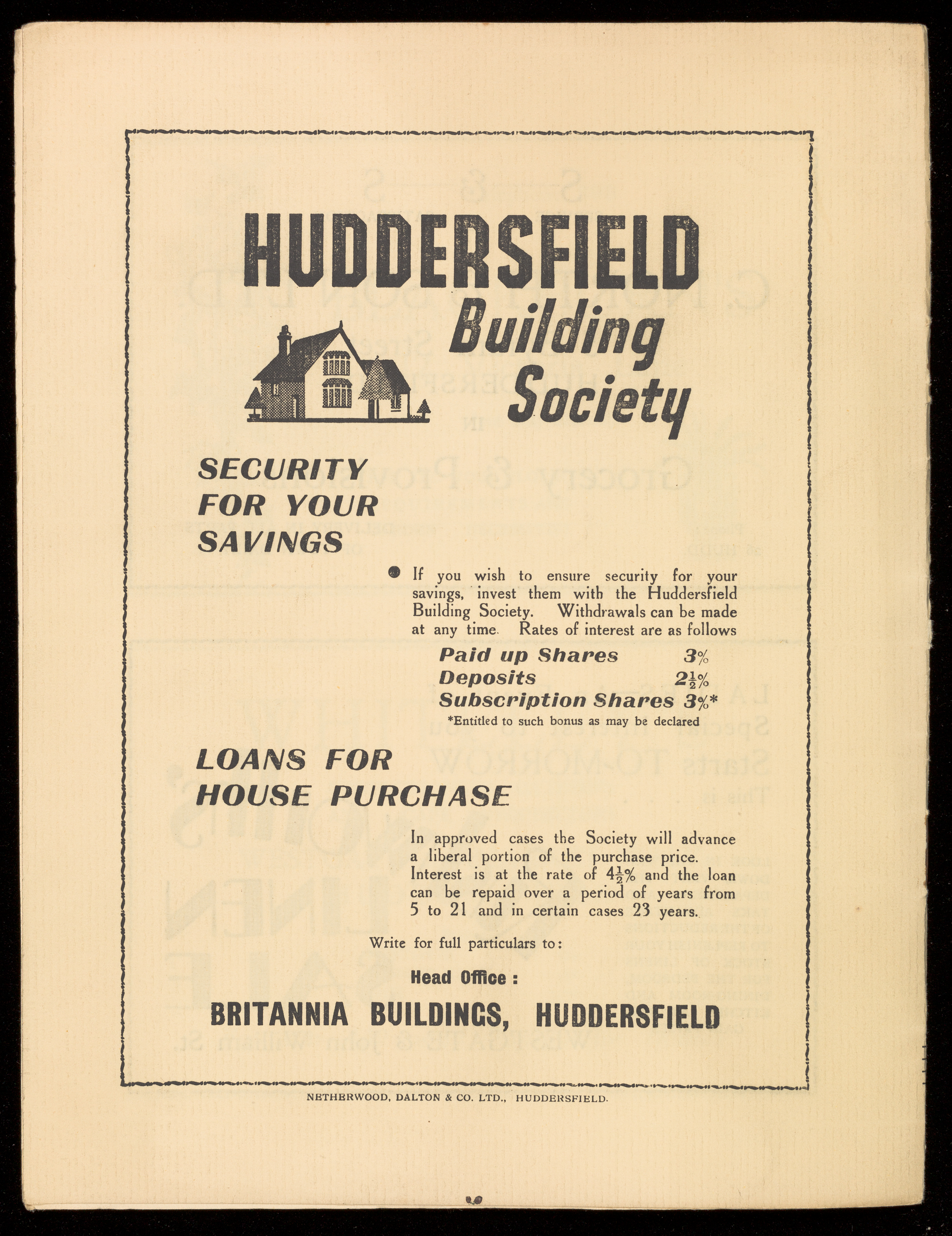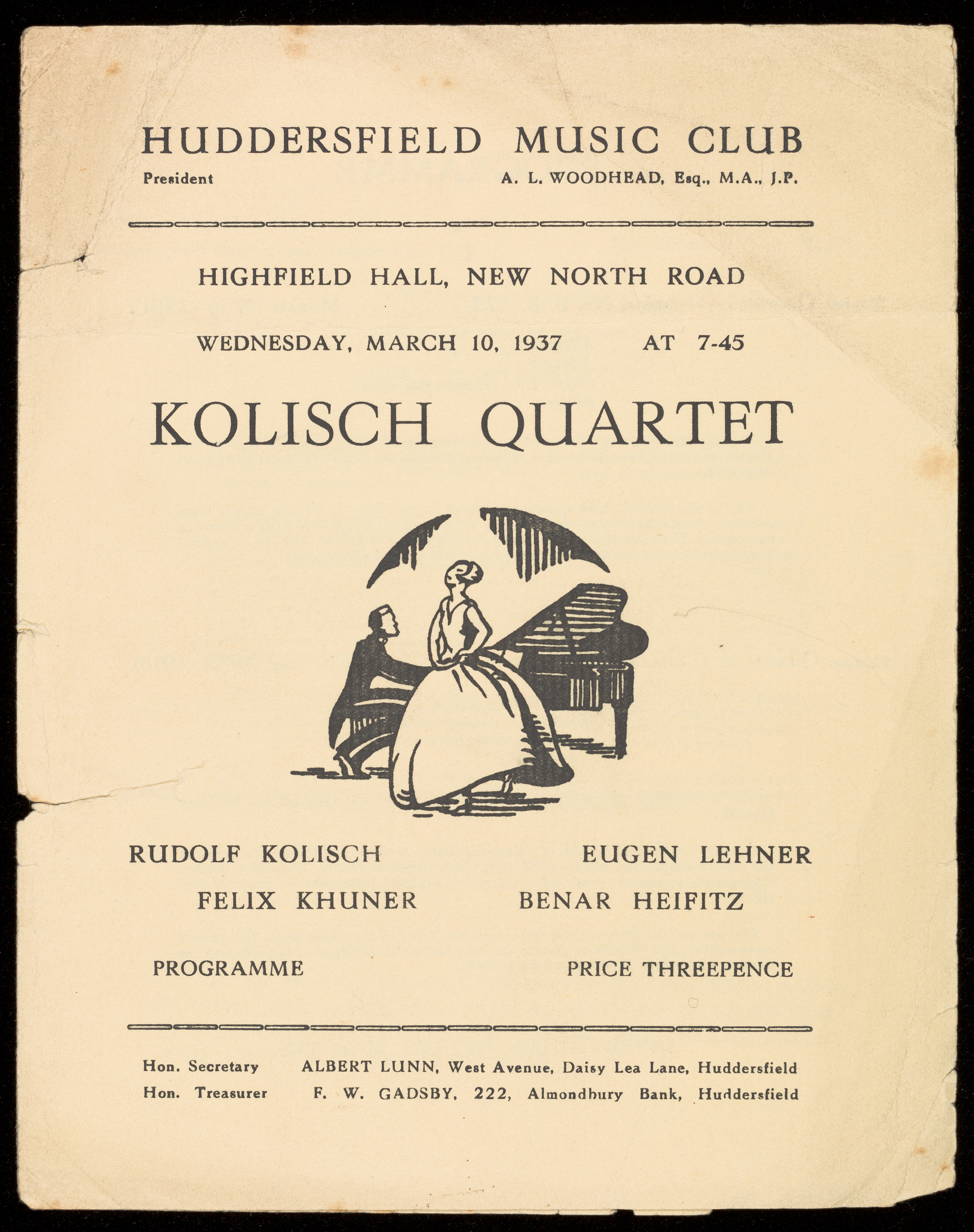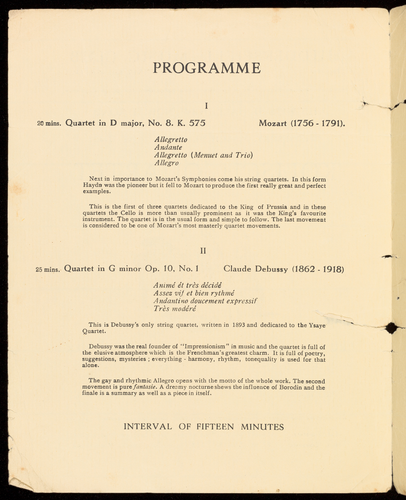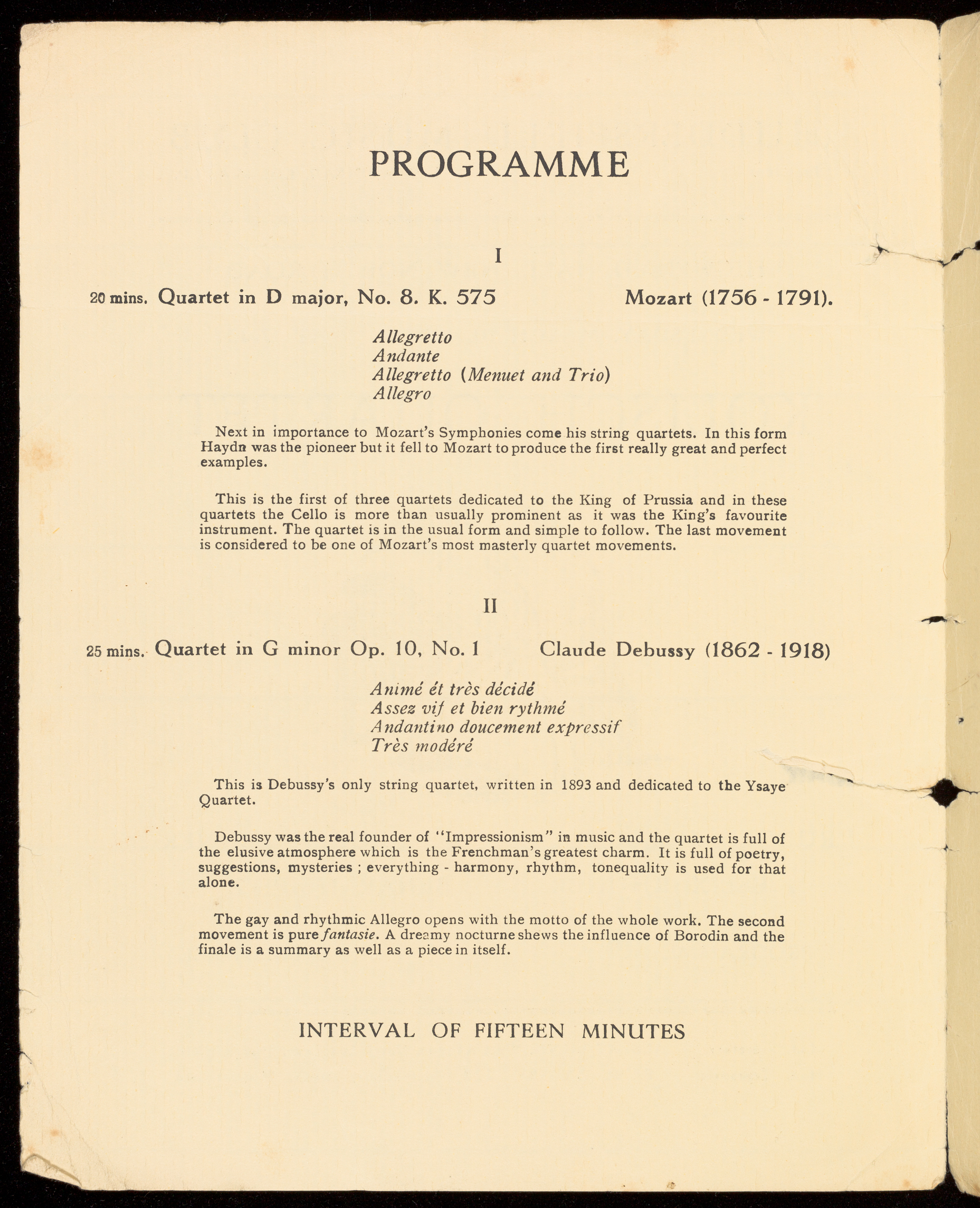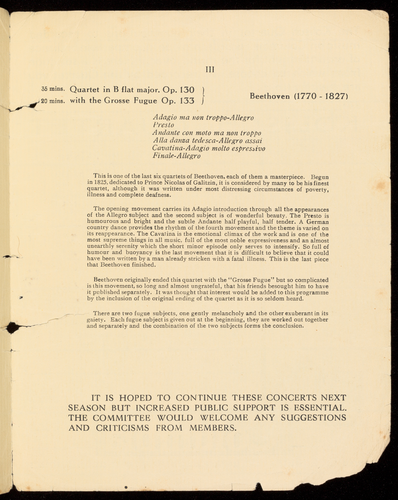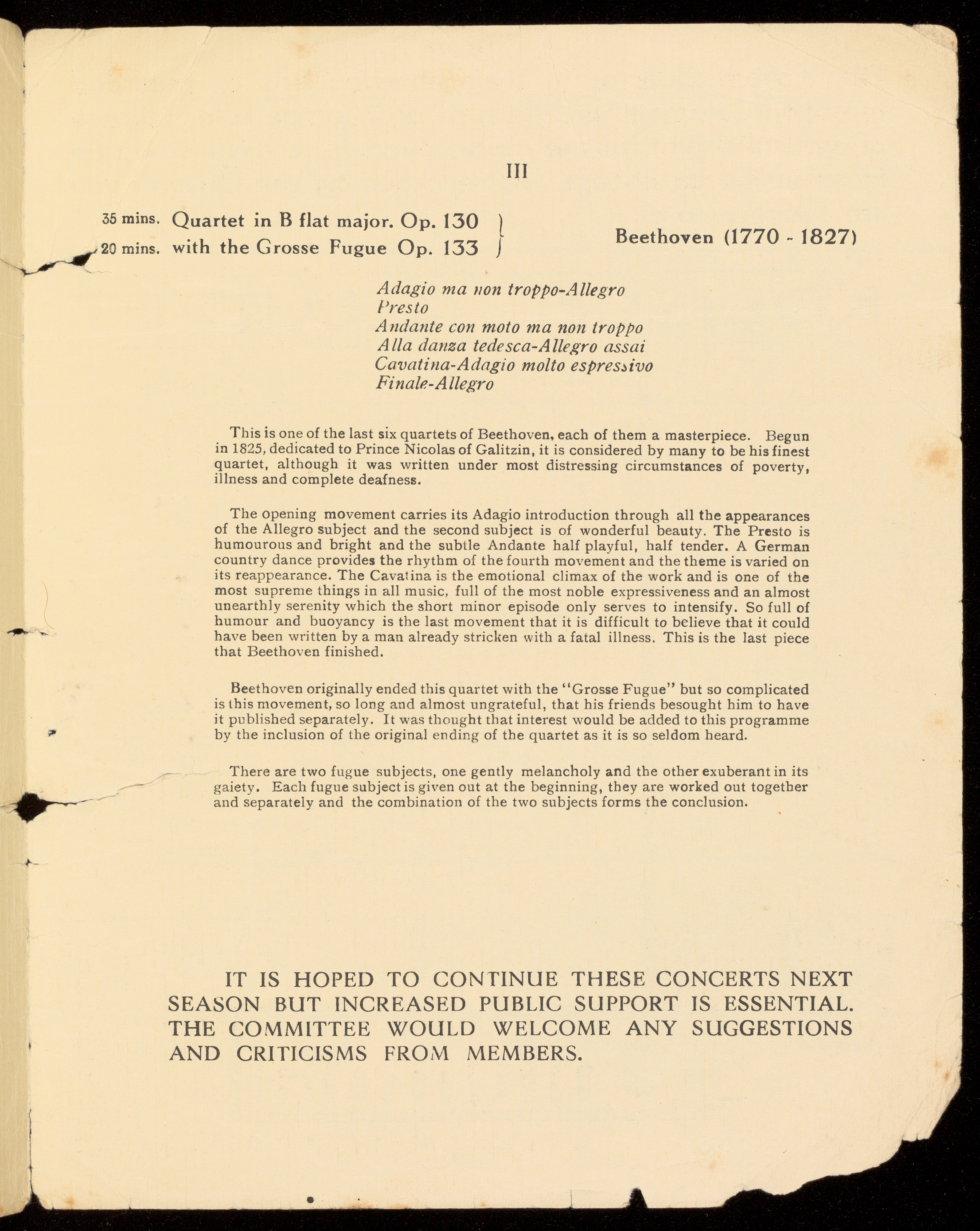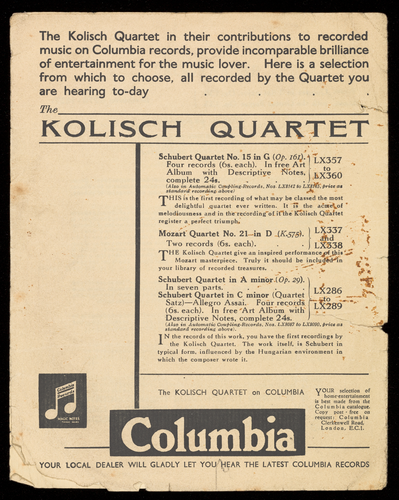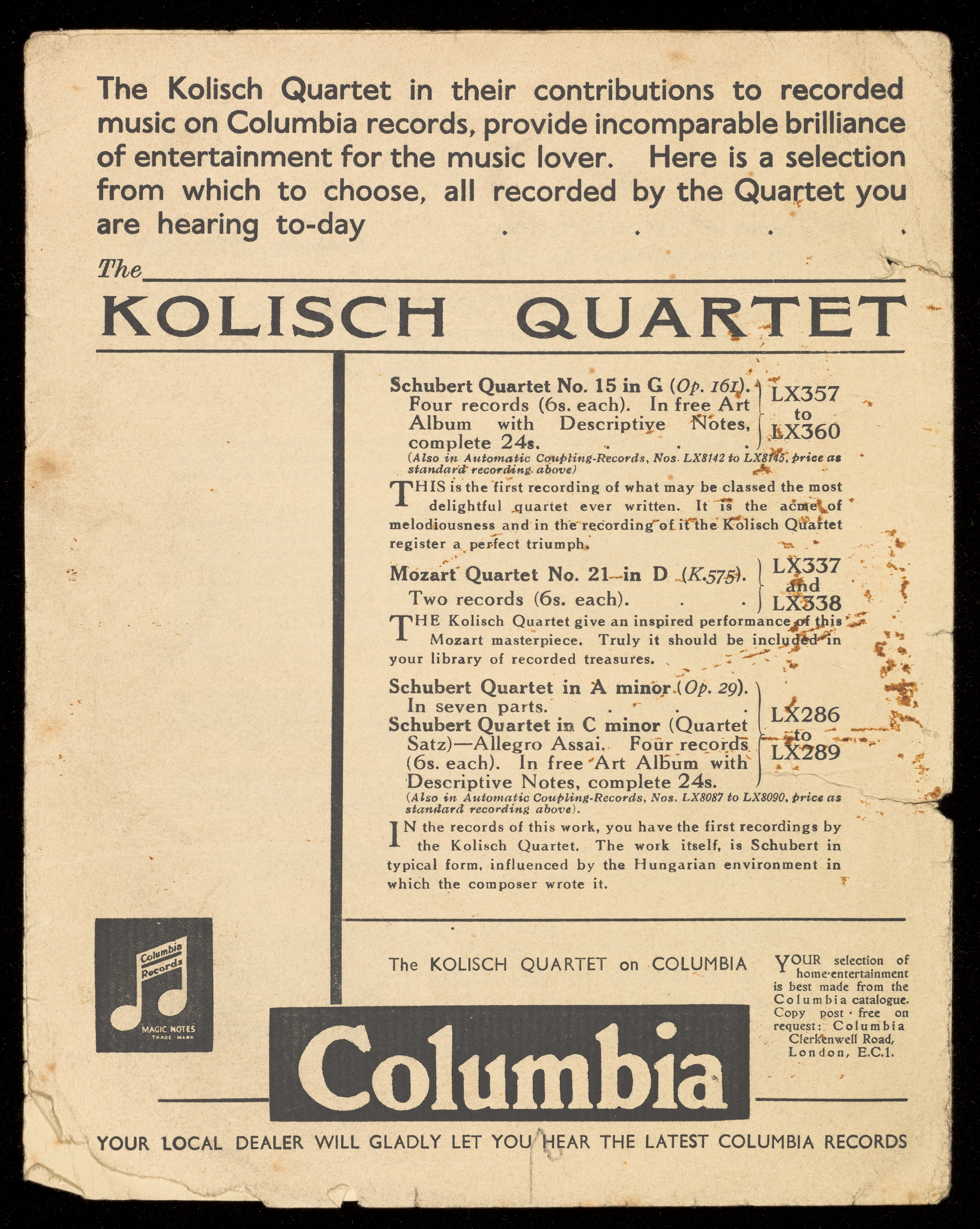Ocr'd Text:
HUDDERSFIELD MUSIC CLUB.
CONCERTS
FOR THE NINETEENTH SEASON
1936-37 TO BE GIVEN IN
HIGHFIELD ASSEMBLY HALL
(NEW NORTH ROAD)
WEDNESDAYS, OCT. 28, NOV. 11, DEC. 9, 1936.
WEDNESDAY, JAN. 13, MONDAY, FEB. 1,
WEDNESDAY, MARCH 10, 1937.
At 7-45 p.m.
(Please note change of day of fifth concert)
PA
Mrs. A. E. Everest.
Mrs. A. E. Hull, F.R.C.O.
Miss A. Shaw, L.R.A.M.
Percy Ainley.
W. Clifford Crook.
A. G. Crowther.
Hon Secretary
Hon. Treasurer -
ww
Committee:
President: A. L. WOODHEAD, M.A., J.P.
J. Stancliffe Ellis.
Mrs. H. Ainley.-
Miss B. Armitage, L.R.A.M.
Mrs. W. F. Clayton.
Miss D. Donaldson.
Mrs. C. Earnshaw.
Miss K. M. Evans, B.A.
Mrs. A. E. Everest.
Miss Freeman, J.P.
Mrs. Denys H. Hirst.
Mrs. A. E. Horsfall.
Irving Silverwood.
F. W. Thornton, M.R.C.S., L.R.C.P.
Fredrick Whiteley.
D. R. H. Williams.
ALBERT LUNN, 7, West Avenue, Daisy Lea Lane.
F. W. GADSBY, 222, Almondbury Bank Tel. 2763.
Ladies' Committee:
Mrs. A. E. Hull, F.R.C.O.
Mrs. G. G. Jarmain.
Mrs. A. W. Kaye.
Mrs. R. Stewart Park.
Miss A. Shaw, L.R.A.M.
Mrs. I. Silverwood.
Miss E. Spikes.
+Miss E. Whitwam, L.R.A.M.
Miss W. K. Willans.
THE CLUB IS OPEN TO ALL. THE SUBSCRIPTION
FOR THE SERIES OF SIX CONCERTS IS 21/- payable to the
Hon. Treasurer. (Town Office, Miss L. North, Messrs.
K. Levell, Ltd., Market Street. Tel. Hudd. 2294).
Ocr'd Text:
WEDNESDAY, 28th OCTOBER, 1936.
MORIZ ROSENTHAL.
THE MASTER PIANIST OF THE DAY.
"Rosenthal is the perfect pianist.... In him a whole school of poetry, not only of
piano playing, comes to that focus where the greatest number of vital forces
unite in their purest energy. Let us cherish the master while we may; we shall
not look upon his like again."
N.C., Manchester Guardian.
"The consummate artist."
Daily Telegraph
WEDNESDAY, 11th NOVEMBER, 1936.
WEISS
**
STRING QUARTET.
"Quartet playing at its best.'
Berlin-Allgemeine Musikzeitung.
"Such playing is rare; it has been one of the discoveries of the present season.
London-Daily Telegraph.
"Certainly a quartet of unique qualities." Amsterdam-Algemeen Handelsblad.
(VIENNA)
WEDNESDAY, 9th DECEMBER, 1936.
KEITH FALKNER.
THE FAMOUS ENGLISH SINGER.
"Keith Falkner is a great singer and a great artist."
London-The Star.
"Not only the possessor of a voice of great natural beauty but also a musician
and interpreter of a high order."
New York Times.
Ocr'd Text:
WEDNESDAY, 13th JANUARY, 1937.
POUGNET-MORRISON-
PINI TRIO.
JEAN POUGNET (VIOLIN).
ANTHONY PINI ('CELLO).
ANGUS MORRISON (PIANO).
"A Trio of fine talent."
"Ensemble playing of a remarkably finished quality."
MONDAY, 1st FEBRUARY, 1937.
(Please note change of day)
Observer.
Morning Post.
GIESEKING.
First appearance in Huddersfield of this brilliant
interpreter of modern music.
WEDNESDAY, 10th MARCH, 1937.
KOLISCH
STRING QUARTET.
"The very perfection of quartet playing."
The Times.
"The Kolisch Quartet are a remarkable group of musicians who play and even
rehearse without music. The result is an extraordinary intimacy of ensemble,'
Sunday Referee.
Paul Stefan.
The Toscanini among all the quartets in the world."
Ocr'd Text:
HUDDERSFIELD MUSIC CLUB
A. L. WOODHEAD, Esq., M.A., J.P.
President
HIGHFIELD HALL, NEW NORTH ROAD
WEDNESDAY, OCTOBER 28, 1936
LOUIS KENTNER
AT 7-45
STEINWAY CONCERT GRAND
PROGRAMME
Hon. Secretary
Hon. Treasurer
PRICE THREEPENCE
ALBERT LUNN, West Avenue, Daisy Lea Lane, Huddersfield
F. W. GADSBY, 222, Almond bury Bank, Huddersfield
Ocr'd Text:
PROGRAMME
I
Variations on "Weinen, Klagen, Sorgen, Zagen."
Liszt (1811-1886)
As July 31st, 1936 was the fiftieth anniversary of the
death of Liszt-the incomparable virtuoso of the piano, a composer now realized
to be far in advance of his time, and the friend of musicians--it is very suitable
that we should begin this season with a concert in which so many of Liszt's works
will be heard; and fortunate, too, that they should be interpreted by a pianist
of the same nationality as that to which Liszt himself belonged and held so dear.
We are now appreciating the great influence Liszt has had upon the composers
who have succeeded him. A careful study of Wagner's music reveals an amazing
number of instances in which his indebtedness is seen to Liszt's harmonic invention.
The French impressionistic composers have only followed the lead which Liszt
gave to them in such works as "Les jeux d'eaux à la Villa d'Este"; the modern
one-movement sonata-form (abandoned since the works of Scarlatti) is clearly
derived from Liszt's examples; while pieces like "Nuages gris" point unmistak-
ably to the writings of Bartok. Liszt's symphonic poems are the forerunners of
the works by Strauss, and even the writings of Franck have clear traces of this
powerful influence. Apart from this, it is hardly necessary to point out the
enormous part Liszt took in the development of the art of writing for the piano
and of piano technique.
These Variations are founded upon the descending chromatic
bass from the Crucifixus of Bach's Mass in B minor, which theme in its turn was
taken from an earlier Cantata, "Weinen, Klagen, Sorgen, Zagen" ("Weeping,
wailing, grieving, despairing"). This is a work of great harmonic boldness and
of a deeply spiritual and dramatic nature. Opening quietly, it develops a climax
of much power, after which the Choral "Was Gott tut, das ist wohlgetan” (“What
God does is right and good") is heard. Mr. Sitwell compares this work to a
Gothic structure encrusted, so to speak, with Baroque decorations.
Sonata in C major Op. 53
II
Allegro con brio
Introduzione (Adagio molto)
Beethoven (1770-1827)
Rondo (Allegro moderato)
This Sonata is dedicated to Beethoven's friend and patron,
Count Waldstein. Its form is unusual. A first movement, rhythmic and colour-
ful, is followed by a romantic Adagio molto, which leads without a break to the
final vivacious Rondo with its fine Coda. Beethoven originally intended the
well-known Andante in F to form the slow movement, but he later discarded the
idea in favour of the present slow Introduction.
Ocr'd Text:
Ballade in G minor Op 23
Ballade in A flat major Op. 47
Chopin (1811-1849)
(a) In none of Chopin's compositions does he surpass the
beauty, fire and nobility of conception which are to be found in the four Ballades.
The title is, indeed, a little misleading, for the scope of these works is much wider
than that of the traditional ballad of literature. Schumann called this first
Ballade in G minor "one of his wildest and most individual compositions," and
added that Chopin himself told him that for all the Ballades he drew his inspiration
from the poems of Mickiewicz, the Polish patriot and poet. This Ballade is full
of the most poetic and intense inspiration; alternating moods of calm and
agitation lead to a mad concluding climax.
(6) The third Ballade is the popular one in A flat major.
It is not so deeply emotional in feeling, but it contains melodies of great nobility
and charm, which again rise to a noble climax.
(a)
(b) Au bord d'une source
(c) Nuages gris
III
INTERVAL OF TEN MINUTES.
IV
(d) Feux Follets
(e)
(f)
Bénédiction de Dieu dans la solitude
La Leggierezza
Rákóczy March
Liszt (1811-1856)
(a) This piece is No. 3 of the "Harmonies poetiques and
religieuses," which owe their inspiration to the poems of Lamartine. Prefixed to
this piece as its motto are lines in which the poet asks from whence comes this
heavenly peace and faith to his troubled, restless, searching heart, by the power
of which he feels himself reborn. It is a rhapsody-like piece of exquisite beauty.
(b) At the whispering of Dawn
Nature, awakening,
Begins once more her play
Schiller.
There are three sets of pieces collected under the title of
Années de Pélerinage (Years of Pilgrimage). Of these the first book, of which
this is the fourth piece, deals with Swiss scenes. This is one of the outstandingly
fine pieces of the entire work, completely original in conception and successful
in effect. It is actually a descriptive tone-poem for the piano, representing the
poetry of an Alpine stream.
(c) "Nuages Cris" is one of Liszt's latest piano pieces, and
only recently published for the first time. Although short, it shows an amazing
modernity both in its harmony (which has been compared to that of Bartok and
Schönberg) and in the exceeding starkness of its style, making a most interesting
contrast with the earlier works.
(d) This piece ("Will o' the Wisp") is the fifth of the tre-
mendous Transcendental Studies. It is also an impressionistic picture; and the
interpretation of its lightness, grace and rapidity calls for an extremely high order
of virtuosity.
(e) "La Legierezza" is the name scmetimes given to the
second of a set of three concert studies which date from 1849. That is the year
of Chopin's death; is it too fanciful to trace the influence of Chopin's delicate,
fairy-like melodic movement in the passage-work of this piece.
(f) The Rakoczy March is based upon the well-known
Hungarian melody. It is wild and stirring to an amazing degree. It forms
another instance of the tribute always paid to Hungary by her great son.
Ocr'd Text:
1936
WED. 11 NOV.
WED. 9 DEC.
WEISS STRING QUARTET
KEITH FAULKNER
1937
WED. 13 JAN.
POUGNET-MORRISON-PINI TRIO
MON. 1 FEB.
WALTER GIESEKING
WED. 10 MAR. KOLISCH STRING QUARTET
THE CLUB IS OPEN TO ALL. THE SUBSCRIPTION FOR
THE REMAINING FIVE CONCERTS IS 18/- PAYABLE TO
THE HON. TREASURER. SINGLE TICKETS, 5/-, MAY BE
OBTAINED FROM THE HON. TREASURER, FROM MESSRS.
KENNETH LEVELL LTD, (LOTTIE NORTH), MARKET STREET,
FROM MRS. HULL, 48, NEW NORTH ROAD. OR AT THE
DOOR.
Ocr'd Text:
HUDDERSFIELD MUSIC CLUB
A. L. WOODHEAD, Esq., M.A., J.P.
President
HIGHFIELD HALL, NEW NORTH ROAD
WEDNESDAY, NOVEMBER 11, 1936 AT 7-45
WEISS STRING QUARTET
LILY WEISS
LOTTE SELKA FRIEDA KRAUSE
PROGRAMME
EDITH STEINBAUER
Hon. Secretary
Hon. Treasurer
PRICE THREEPENCE
ALBERT LUNN, West Avenue, Daisy Lea Lane, Huddersfield
F. W. GADSBY, 222, Almondbury Bank, Huddersfield
Ocr'd Text:
PROGRAMME
I
Quartet in G major, Op. 77, No. 1
Quartet in F major
Allegro con spirito
Adagio sostenuto
Presto (Menuet and Trio)
Allegro ma non troppo
Among the wealth of music which Haydn's genius poured out
there are known to be 77 string quartets, 104 symphonies, 52 sonatas for the piano,
and at least 87 works in a similar form for other combinations of instruments.
Sonata-form (which, of course, includes quartets and symphonies as well as the
Sonata as we generally understand the term) was brought to its modern perfection by
Haydn, who indeed used that form, as we have seen, so extensively that it was said
that "Haydn thinks in Sonatas." But it spite of this great volume of music, Haydn's
inspiration never seems to falter; each work possesses its own individuality and
charm to an amazing extent.
This quartet is the first of a set of six, dedicated to Count Erdödy
and written shortly after Haydn's second visit to London in 1795, After three
vigorous chords, the first movement opens with a fugato-like passage; a unison
passage leads to the more gentle second subject. The development and re-
capitulation are clear and easy to follow. The Adagio is quiet and songful, with
passages of delicate figuration. The Menuet and Trio are simple and playful; in the
latter, the violin melody is throughout accompanied by pizzicato chords. The Finale
opens with a strong unison passage, and, except for some quieter episodes, keeps up
the cheerful bustling triplet rhythm.
Haydn (1732-1809)
II
Allegro moderato
Assez vif, très rythmé
Très lent
Vif et agité
Ravel (b.1875)
Although Ravel is one of the most important modern French
composers, he is not of purely French origin; his father came of a French-Swiss
family while his mother was Basque. It is from the latter that he inherits so many
Ocr'd Text:
of the Spanish traits which are to be found in his music-the gay outlook on life, the
feeling for light and colour and his use of the complex rhythms of Spain. But
added to these qualities are found the virtues of French culture-craftsmanship,
restraint, fastidiousness, intelligence, wit, purity of form and style, and unerring
taste and balance. His output is relatively not large; he has only written one work
for string quartet; this, in its delicacy and clarity and the finish of its sound-texture,
has been called the "best-sounding" quartet ever written.
It is dedicated to his master Gabriel Fauré, and the first movement
opens in an almost Fauré-like manner; soon it developes its own character and style,
with many changes of colour and tempo. The second movement is really an original.
form of a Scherzo, with a contrasting section of much melodic charm. The slow
movement is complex in style, with fleeting references in it to the first movement ;
it ends with a wonderful raising of all four instruments to their highest registers.
The final movement (in 5/8 time) is gay and rhythmical,
INTERVAL OF TEN MINUTES.
Quartet in D minor, Op..posth.
III
Schubert (1797-1828)
Allegro
Andante con moto
Scherzo and Trio (Allegro molto)
Presto
Schubert wrote, in all, fifteen quartets; of these, the finest
examples are the quartets in A minor, D minor and G major. This work (the
Quartet in D minor) dates from 1826 but was not published before Schubert's death.
It was written during a period of illness and depression. It opens with a
dramatic motive, which reminds the listener vividly of the motive of "Fate knocking
at the door" from Beethoven's Symphony in C minor. This is followed by a long-
drawn melody on the violin, As a whole this movement is less lyrical and more
dramatic than much of Schubert's chamber music style. The Variations of the
second movement deal with the thought of death; they are founded upon the theme
of Schubert's famous song
"Death and the Maiden." The Scherzo is a return to
life, with its sharply-pointed rhythms; the Trio is gentler and more flowing. The
Finale opens with a vigorous unison passage, and, throughout, the movement is full
of rhythm and life.
Ocr'd Text:
1936
WED. 9 DEC.
KEITH FALKNER
Songs by John Blow, Handel, Schubert, Toye,
Stanford, Parry, Goossens and Armstrong Gibbs
1937
POUGNET-MORRISON-PINI TRIO
WED. 13 JAN.
MON. 1 FEB.
WALTER GIESEKING
WED. 10 MAR. KOLISCH STRING QUARTET
THE CLUB IS OPEN TO ALL. THE SUBSCRIPTION FOR
THE REMAINING FOUR CONCERTS IS 17/6 PAYABLE TO
THE HON. TREASURER. SINGLE TICKETS, 5/-, MAY BE
OBTAINED FROM THE HON. TREASURER, FROM MESSRS.
KENNETH LEVELL LTD, (LOTTIE NORTH), MARKET STREET,
FROM MRS. HULL, 48, NEW NORTH ROAD. OR AT THE
DOOR.
WED. 2 DEC.
Musical Evening in Highfield Hall at 7-45 p.m.
Concert by members of the Music Club. Coffee.
Any member not having received an invitation is
asked to communicate at once with Mrs. Hull, 48
New North Road, to whom all replies (with
applications for cards of admittance) should be
addressed.
PRELIMINARY NOTICE.
HOLME VALLEY MALE VOICE CHOIR CONCERT
TOWN HALL, HUDDERSFIELD, SATURDAY, DECEMBER 5th
at 7-30 p.m.
Artistes :
GARDA HALL
Soprano
Violinist
Tickets available at J. Wood & Sons, Ltd., New Street, Huddersfield,
in due course
MAURICE CLARE
Ocr'd Text:
The Committee begs to announce that owing to indisposition
KEITH FALKNER is unable to appear to-night. His place will be
taken by ASTRA DESMOND.
PROGRAMME.
1.
Dank sei Dir.
There in Myrtle shades.
(from Hercules/
3
Ich Liebe dich.
Wonne der Wehmuth.
Der Zwerg.
II.
Gesegnet sei das Grun
Wo find ich trost.
Auf einer Wanderung.
Bedeckt mich.
Frühling übers Jahr.
III
Rustle Sedges
Forget-me-nots.
A Spring Song.
Rock 0 Wave.
The Way of the World.
The First Meeting.
Thanks for Thy Warning
IV
INTERVAL of 15 MINUTES
Rondel.
Evening.
Sweet Venevil.
Seagull of the land under
Wave
Hebridean Sea Reivers.
Handel.
Accompanist.
Beethoven.
Schubert.
Hugo Wolf.
Sibelius.
Kilpinen.
Grieg.
Elgar.
Bantock.
Delius.
Kennedy Fraser.
Norman Franklin.
Ocr'd Text:
HUDDERSFIELD MUSIC CLUB
A. L. WOODHEAD, Esq., M.A., J.P.
President
HIGHFIELD HALL, NEW NORTH ROAD
WEDNESDAY, DECEMBER 9, 1936
KEITH FALKNER
AT THE PIANO
PROGRAMME
Hon. Secretary
Hon. Treasurer
AT 7-45
M.P
MICHAEL MULLINAR
PRICE THREEPENCE
ALBERT LUNN, West Avenue, Daisy Lea Lane, Huddersfield
F. W. GADSBY, 222, Almondhury Bank, Huddersfield
Ocr'd Text:
Important Announcement
Town Hall, Huddersfield
Friday, Feb. 5th, 1937
THE
HALLÉ ORCHESTRA
Conductor: Sir Hamilton Harty
Pianist: Egon Petri
Plan will be open at Messrs. Kenneth Levell (Lottie North)
Market Street, on Monday, Jan. 18th
Ocr'd Text:
1
Zum neuen Jahr
Im Grab
Nachtstück
PROGRAMME
Vittoria, Vittoria
Self banished
Revenge Timotheus cries (Alexander's Feast)
Litanei
Freude der Kinderjahre
Nay but you who do not love her
The Chapel on the hill
}
The bold unbiddable child
When we two parted
To Althea from prison
I
II
Pious Celinda
When Arthur first in Court began
INTERVAL OF FIFTEEN MINUTES
III
IV
Dear Heart, why will you use me so?
Cool is the valley now
I hear the noise of many waters
Mönch von Salzburg (14th Cent.)
arr. Paumgartner
}
Carissimi (1604-1674)
John Blow (1648-1708)
Handel (1685-1759)
Schubert (1797-1828)
Toye (b. 1883)
Stanford (1852-1924)
Parry (1848-1919)
Goossens (5. 1893)
"from Chamber Music "
words by Jaines Joyce
Armstrong Gibbs (b. 1889)
Ocr'd Text:
1937
WED. 13 JAN.
POUGNET-MORRISON-PINI TRIO
Trio in E flat, Op. 40
Trio in A minor
Trio in B Flat, Op. 97
MON. 1 FEB.
WALTER GIESEKING
WED.. 10 MAR. KOLISCH STRING QUARTET
Brahms
Ravel
Beethoven
THE CLUB IS OPEN TO ALL. THE SUBSCRIPTION FOR
THE REMAINING THREE CONCERTS IS 12/- PAYABLE TO
THE HON. TREASURER. SINGLE TICKETS, 5/-, MAY BE
OBTAINED FROM THE HON. TREASURER, FROM MESSRS.
KENNETH LEVELL LTD, (LOTTIE NORTH), MARKET STREET,
FROM MRS. HULL, 48, NEW NORTH ROAD, OR AT THE
DOOR.
Ocr'd Text:
HUDDERSFIELD MUSIC CLUB
A. L. WOODHEAD, Esq., M.A., J.P.
President
HIGHFIELD HALL, NEW NORTH ROAD
WEDNESDAY, JANUARY 13, 1937
THE
POUGNET-MORRISON-PINI
TRIO
JEAN POUGNET (Violin)
AT 7-45
ANGUS MORRISON (Piano)
PROGRAMME
ANTHONY PINI (Cello)
PRICE THREEPENCE
Hon. Secretary ALBERT LUNN, West Avenue, Daisy Lea Lane, Huddersfield
F. W. GADSBY, 222, Almondbury Bank, Huddersfield
Hon. Treasurer
Ocr'd Text:
PROGRAMME
Trio in E flat major, Op. 40
Trio in A minor
I
Andante: Poco piu animato
Scherzo. Allegro: molto meno allegro
Adagio mesto
Finale. Allegro con brio.
This Trio was originally written for piano, violin and horn; and though in
performance the viola or cello is frequently substituted for the horn, it is really
unfortunate that a work, whose conception and colouring are so completely based
upon the characteristics of that instrument so beloved by Brahms, should not be
heard in its original form.
In the Spring of 1865 Brahms's mother, to whom he was deeply and tenderly
devoted, died. From his grief two works emerged-the German Requiem (which,
Kalkbeck states, was first suggested to his mind by the shock of Schumann's
death a few years earlier) and the Horn Trio, which has been called a "miniature
requiem." Whatever may have been the inspiration, the first, second and third
movements of the Trio are sombre in colouring and not until the fourth move-
ment does any real joy enter into it. It has also been called "an Eichendorff
romance in four parts, each a German woodland song that wakes old legends."
Out of these green shades the fresh flourishes of the huntsman's horn, at the
opening of the last movement, rouses the hearer abruptly.
The first movement is particularly original. It opens with an Andante,
which is twice interrupted by a more agitated episodic section. For the first and
only time Brahms abandoned the Sonata form for his opening movement. The
themes are short and incisive. There is no attempt at development; a broadly
varied repitition suffices, which all the more deepens the impression of woodland
voices singing. The second movement, with its regular beat, takes us past the
forest smithy; for the Trio the postillion plays his old-world folk-tune. The
eighty-six bar Adagio is a complete contrast. Even Brahms rarely wrote such
moving and heart-felt music. At the sixty-third bar a hint of the theme of the
final movement is heard. This theme is entirely inspired by the music of the
hunting horn, and the whole movement is vigorous and lively.
Brahms (1833-1897)
II
Modéré
Pantoum : assez vij
Passacaille : très large
Finale: animé
Ravel (b. 1875)
Since the death of Debussy, Ravel is the leading composer of France. But
his output is relatively small. An experimentalist, he does not allow a work to
appear until his acute and fastidious critical faculty is satisfied. He is not a
polyphonist, as Debussy, to a large extent, was. His harmony is bold though
restrained. His rhythms are striking, and these, as well as his vivid clean
colourings, probably come to him through his Basque (Spanish) ancestry.
Ocr'd Text:
The Trio in A minor (1915), though based on a well-used combination of instru-
ments, is, however, full of freshness of idea and treatment. As in the Quartet,
the first movement is of "aphoristic compression, yet is faithful to the spirit of
the classic plan." The first theme has a striking rhythmic effect in the division
of the 4/4 measure into groups of three and five quavers. The second movement
"Pantoum," an Eastern dance, is a fantastic scherzo. The "Passacaille" (an
old dance founded on a ground bass) is less interesting, but the Finale, in 5/4 and
7/4 time, has brilliancy and vigour which lead to a striking climax. Throughout,
the piano part is written with great skill and understanding, but part of the
originality of the work lies in the way in which the strings are treated with equal
authority and power.
INTERVAL OF TEN MINUTES
Trio in B Flat major, Op. 97
III
Beethoven (1770-1827)
Allegro moderato
Sherzo: Allegro
Andante cantabile ma pero con moto
Allegro moderato
The Trio in B major was written in 1811. It came almost at the end of a
long period of great chamber compositions. The work is typical of Beethoven's
happiest period; the problems of his young manhood were solved, while those of
the later years had not yet appeared. The Trio was shortly followed by the very
original Symphony in A, No. 7; so that during the composition of the first work
the dormant impulse toward symphonic composition was re-awakening. It also
marks the end of Beethoven's use of the piano as the centre of a chamber music
ensemble. He must then have realized that the piano, though complete in itself
to attempt the expression of his deepest thoughts, was unsuitable, in combina-
tion, for that type of chamber music by which he sought to convey the absolute
abstraction of his last chamber works for strings alone.
The Trio opens with the calm, resolute first subject announced by the piano.
The strings enter at the sixth bar. This eventually leads to the second subject
in the key of G major. A striking pizzicato passage (with the piano playing
staccato thirds) leads through long shakes to the recapitulation. The movements
end with a vigorous coda. The Scherzo is highly original; it begins with a
tripping figure played by the cello and echoed by the violin and the piano. A
strange chromatic theme in B flat minor opens the trio section. The slow
movement is one of the most profound and beautiful ever written by Beethoven.
As was so often the case, the form is that of a theme with variations. The
theme is announced by the piano alone, and it is not difficult to follow its course
through the variations till the music fades away into silence. The final movement,
which breaks abruptly into the Andante, is in Rondo form, and ends with a
magnificent Presto founded on the first theme, in 6/8 time.
Ocr'd Text:
1937
MON. 1 FEB.
WALTER GIESEKING-Piano Recital
Works by Schumann, Casella, Debussy, Liszt
Kolisch String Quartet
WED. 10 MAR.
coscoscascos cascoscoscoscos cascos cascoscoscasion concion con con concoscoscoscosion cosion concoscon con cascoscosson
Town Hall. Huddersfield
Friday, Feb. 5th, 1937
at 7-30 p.m,
THE
HALLÉ ORCHESTRA
Conductor: Albert Coates
Pianist Egon Petri
Tickets, 8/6 6/- Area, 5/- 3/6 2/6 (reserved)
1/- (unreserved)
Plan opens at Messrs. Kenneth Levell (Lottie North)
Market Street, on Monday, Jan. 18th
coscoscoscos cascoscascascascascasion canon canon cascascoscoscos con cosesscasion concoscose coscascoscos cascos
THE CLUB IS OPEN TO ALL. THE SUBSCRIPTION FOR
THE REMAINING TWO CONCERTS IS 8/6 PAYABLE TO
THE HON. TREASURER. SINGLE TICKETS, 5/-, MAY BE
OBTAINED FROM THE HON. TREASURER, FROM MESSRS.
KENNETH LEVELL LTD, (LOTTIE NORTH), MARKET STREET,
FROM MRS. HULL, 48, NEW NORTH ROAD, OR AT THE
DOOR.
Ocr'd Text:
HUDDERSFIELD MUSIC CLUB
A. L. WOODHEAD, Esq., M.A., J.P.
President
HIGHFIELD HALL, NEW NORTH ROAD
MONDAY, FEBRUARY 1, 1937
WALTER GIESEKING
AT 7-45
GROTRIAN-STEINWEG CONCERT GRAND
PROGRAMME
Hon. Secretary
Hon. Treasurer
PRICE THREEPENCE
ALBERT LUNN, West Avenue, Daisy Lea Lane, Huddersfield
F. W. GADSBY, 222, Almondhury Bank, Huddersfield
Ocr'd Text:
PROGRAMME
I
Davidsbündlertnäze, Op. 6
Schumann (1810-1856)
The Davidsbündlertänze consists of eighteen short dance-like pieces, which
were composed in 1837, published in 1838, and issued in their final form in 1850.
They are, therefore, among the first of Schumann's mature works, and are in every
way typical of the "Romantic" school of composers. Schumann, after surmounting
many difficulties, finally married Clara Wieck in 1840. Of the Davidsbündler he
writes to her in 1838" There are many marriage thoughts in the dances -
they originated in the most joyful excitement I can ever remember - I will
explain them to you sometime." And later, " . .
... But my Clara will discover
what is in the dances which are dedicated to her more than anything else of mine
the story is a whole Polterabend (Festivities on the eve of a marriage), and now
you can picture to yourself the beginning and the end. If ever I was happy at the
piano it was when I was composing these. ..
An old German saying appears on the title page:
Aye hand in hand go weal and woe,
In weal be good, in woe thy courage show.
""
The works open with a two-bar motto by C. W. (Clara Wieck), continued
by Schumann for two bars. The dances themselves have no separate titles, but
the tempo and other indications (2. With expression; 3. With humour; 4.
Impatiently; 10. In Ballade style; 13. Wild and merry; 15. As if from the distance)
reveal their characteristics clearly. Another clue to their meaning is given by the
initial F or E, or both, which Schumann adds at the end of each piece. These
stand for Florestan and Eusebius, and are connected with Schumann's mysterious
Davidsbündler (David's League). This was a kind of secret association, existing
chiefly in Schumann's imagination though there were some real characters in it,
which was to unite those artists, or friends of art, who held views in common,
against their opponents, the Philistines. Through the mouths of these personages
Schumann expressed many of his critical opinions. Florestan and Eusebius are
used to denote two different aspects of Schumann's own personality - the former
being the fiery enthusiast and the latter the gentle dreamer.
Symphonia Arioso e Toccata, Op. 59
Casella (b 1883)
(First provincial performance in England)
Casella was born in Turin, but studied piano with Diemer and composition
with Fauré at the Paris Corservatoire. There he won the Premier Prix. Casella
has led a busy life as a performer, composer, conductor, and writer on musical
subjects. In 1917 he founded the society that has since become the Societa
Italiana di musica moderna. He has written two symphonies, two orchestral
suites, quartets and a number of smaller piano and orchestral works. He is himself
an accomplished pianist and knows how to write for his instrument with skill
and understanding. The most able of modern Italian composers, he is able to
express wit with great effect.
The Symphonia was written in 1936.
INTERVAL OF TEN
OF TEN MINUTES
Ocr'd Text:
Hommage à Rameau
Masques
Cloches à travers les feuilles k
Mouvement
HETH=
TI
Perhaps Debussy's finest and most individual work was his piano compositions.
He follows Chopin and Liszt as the creator of another new and original style both
of piano playing and composition. His exquisitely sensitive ear enabled him to
translate into sound the almost inexpressible vibrations of light, colour and
shadows in a way which had never before been achieved. Technically, he
demands from his interpreters a new subtlety of finger (and foot), and a
completely fresh rhythmical conception.
Jeux d'eaux de la Villa d'Este
Sonetto 104 del Petrarca
Bénédiction de Dieu dans la Solitude.
"Hommage à Rameau" (Debussy's tribute to a great French predecessor),
"Mouvement" and "Cloches a travers les feuilles" (a piece of Impressionistic
music painting) all belong to the two sets of "Images", published in 1905 and
1907. "Masques" dating from 1904, of considerable technical difficulty and
abounding in rhythmic subtleties, portrays a fantastic and wayward mood.
Debussy (1862-1918)
WEDNESDAY, MAR. 10
III
It is most interesting to hear Liszt's "Jeux d' eaux de la Villa d' Este"
after the impressionistic pieces of Debussy, for then it is easy to realise the great
influence that Liszt has had over later composers, and how he himself is the real
originator of modern tone painting.
Liszt (1811-1886)
The "Jeux d' eaux", one of the pieces forming the third volume of the
Années de Pélerinage, is" an evocation of the fountains and noise of waters" in
that lovely garden in Italy where Liszt loved to be. "Sonetto 104 del Petrarca"
is taken from the second volume of the Années de Pélerinage (Italie). In this
volume there are three Petrarch sonnets, all of which were originally songs, and
only were arranged as piano pieces for inclusion in this Italian group. "Bénédiction
de Dieu" is No. 3 of the "Harmonies poetiques et religeuses," which owe their
inspiration to the poems of Lamartine. Prefixed to it as a motto are lines in which
the poet asks from whence comes this heavenly peace and faith to his restless,
troubled heart.
FRIDAY, FEB. 5 HALLÉ ORCHESTRA
X
TOWN HALL at 7-30 p.m.
Conductor: ALBERT COATES
Pianist: EGON PETRI
KOLISCH STRING QUARTET
Ocr'd Text:
-P
MAGIC NOTES
TRAOR MARK
WALTER
ORDER THESE RECORDS FOR YOUR
LIBRARY OF RECORDED
"TREASURES"
GIESEKING
in his superb pianoforte artistry on Columbia Records.
Have such enjoyment for the brightness of your leisure
hours at home-
ON SALE EVERYWHERE
Mozart Concerto in E flat (K271)
} ₁
LX559-62
In eight parts. Four records (6s. each)
Supplied in Art Album (free). COMPLETE 24s.
(Also in Auto. Coupling Records, price as above)
(a) Moment Musical in F minor (Schubert)
(b) Intermezzo in C (Brahms)
(a) Waltz in D flat (Chopin): (b) Prelude
in F (Chopin)
Alla Turca (Allegretto, from Mozart K331
Sonata in A)
Harmonious Blacksmith (Handel)
La Cathedrale Engloutie (Debussy)-LB30
Reflets dans l'Eau (Debussy)
Soiree dans Grenade (Debussy)
●
Liszt Concerto No. 1 in E flat. In four parts.
Two records (6s. each)
●
LB31 (4s.)
(4s.)
}
LX342-6
Beethoven "Emperor" Concerto, No. 5
In nine parts. Five records (6s. each)
Supplied in Art Album (free). COMPLETE, 30s.
(Also in Auto. Coupling Records, price as above)
LX514 (6s.)
LX480 (6s.)
LX181-2
Symphonic Variations (Franck). In four 1 LX192-3
parts. Two records (6s. each).
Columbia catalogue on request from Columbia, Clerkenwell Road,
London, E.C.1., gives further recordings by GIESEKING, Send
P.C. for copy !
Columbia
RECORDS
MAGIS NATES
TRADEMARK
Ocr'd Text:
HALLÉ
ORCHESTRA
TOWN HALL
HUDDERSFIELD
Friday, February 5th, 1937
at 7-30 p.m.
Under the patronage of His Worship the Mayor (Councillor J. Barlow,
J.P.) and A. L. Woodhead, Esq., M.A., J.P. (President Huddersfield
Music Club).
basin
Coronation Festival
Concert
Conductor: Albert Coates
Pianist
Egon Petri
-
TICKETS 8/6, 6/-, 5/-, 3/6, 2/- (reserved), 1/- (unreserved)
From Messrs. K. LEVELL (Lottie North) Market Street, Tel. Hudd. 2294
or from members of the Committee
Programme
Price Sixpence
Berl
Buch
Promoted by the
Ladies Committee
Huddersfield Music
Club
Committee:
Mrs. H. Ainley
Miss B. Armitage, L.R.A.M.
Mrs. W. F. Clayton
Miss D. Donaldson
Mrs. C. Earnshaw
Miss K. M. Evans, B.A.
Miss Freeman, J. P.
Mrs. Denys H. Hirst
Mrs. A. E. Horsfall
Mrs. G. G. Jarmain
Mrs. A. W. Kaye
Mrs. R. Stewart Park
Mrs. I. Silverwood
Miss E. Spikes
Miss E. Whitwam, L.R.A.M.
Miss W. K. Willans
Hon. Secretaries :
Mrs. A. E. Hull, F.R.C.O.
Miss A. Shaw, L.R.A.M.
Hon. Treasurer:
Mrs. A. E. Everest
Ocr'd Text:
FURS
SPORTSWEAR AND GOWNS
Furs - Gowns
Sportswear
Knitwear
Wool Frocks
Millinery
Phone
505
FUR repairs under
personal supervision
WE beg to announce that the
new and exclusive collec-
tion of Furs, Sportswear
& Gowns (including Bridal
Wear) is now ready and
we hope to have the
pleasure of your visit
IRVIN BROOK LTD.
JOHN WILLIAM ST.
Huddersfield
Phone
505
Ocr'd Text:
(0232-5
11
To-day's Children are
HUDDERSFIELD WOMEN'S CONSERVATIVE and UNIONIST
DAY TRIP
to
::
CORONATION
12th MAY, 1937
Inclusive Charge
morrow's Leaders
ASSOCIATION
* Leave Huddersfield 12 p.m., 11th May.
* Excellent Breakfast and Supper on train.
* Special Saloon Coaches meet train and take
party to line of route of procession.
✰ Luncheon.
::
* Drive to Hampton Court where Tea will
be served, Special drive to view decorated
parts of city (a unique opportunity).
* Seats can be booked at Palladium Theatre
for performance commencing 9-30 pm.
Theatre Tickets Extra
40/- to Members
41/- to Non-Members
This is the chance of a lifetime.
Numbers are strictly limited. Reserve
your seat now at 2a, East Parade, where
deposits and reservations can be made.
Special hours, 7 p.m. to 9 p.m. each
Friday evening. A deposit of 2/6 secures
your seat.
Ocr'd Text:
FURS
SPORTSWEAR AND GOWNS
Furs - Gowns
Sportswear
Knitwear
RALPH
THE MODERN CHEMISTS
FOR EVERYTHING MEDICAL
WE beg to announce that the
new and exclusive collec-
tion of Furs, Sportswear
e Bridal
CUTHBERT
LIMITED
DISPENSING
INVALID REQUISITES
TABLE WATERS
TOILET PREPARATIONS
PHOTOGRAPHICS
10 & 12 WESTGATE, Huddersfield
'Phone 2746
Ocr'd Text:
2412540
org
S
To-day's Children are
To-morrow's Leaders
Just as children look to parents for present guidance
so we base our hopes for the future on the rising
generation.
Prove true to your children. Teach them the importance of
thrift in its proper relation to progress. Open a Savings
Account for each member of the family which can grow year
by year and be in readiness for that time when they want to
step out into the World.
There is no better or safer way than to start a regular Savings
Account in the Halifax Building Society.
ASSETS EXCEED £112,000,000
HALIFAX
THE WORLD'S LARGEST BUILDING SOCIETY
Sir ENOCH HILL
HALIFAX
President and General Manager
HEAD OFFICES
Huddersfield Branches
CLOTH HALL STREET & 8, MARKET PLACE
Ocr'd Text:
YOU
MUST
HAVE
QUALITY
WALLACES
FOR HIGH-CLASS
Central Stores
'Phone 502
GROCERIES and
PROVISIONS
The
GEORGE
HOTEL
(Huddersfield) Ltd.
.
HUDDERSFIELD
Managing Director - H. A. DUCKSBURY
8 King Street
'Phone 3772
FIRST-CLASS COMMERCIAL HOTEL
●
ADJOINING THE RAILWAY STATION
Large and Well-Lighted STOCK ROOMS
PRIVATE SUITES
H. AND C. 56 ROOMS
SPECIAL BED COMFORT
SUPPERS AFTER THE
CONCERT
Telephone Nos. 3271, 3272 & 3282
Telegrams
"GEORGE HOTEL"
Ocr'd Text:
The new standard of Columbia Pianoforte Recordings by
Egon Petri provides incomparable entertainment for
pianoforte lovers. Here is a selection from which to
choose, all recorded by the great artist you are hearing
to-day
月
MACIC NOTES
LI AUT MAI
Columbie
Records
EGON PETRI
Beethoven Sonata in F sharp (Op. 78). LX576
In two parts. Record, 6s.
Beethoven Sonata in E minor } LX544-5
(Op. 90). Two records, 6s. each
LX520
FAUST-Waltz (Gounod-trans. Liszt).
In two parts. Record, 6s.
ORPHEE-Melodie (Gluck-arr. Sgambati)
Menuet (Bach-Petri). Record 6s.
LX508
Beethoven Sonata in C minor
(Op. III). Three records, 6s. each
LX491-3
(Auto. Coupling Records, LX8240-2, price as
standard recording above)
Mazeppa (Lisst). In two parts.
Record, 6s.
●
Soiree de Vienne (Schubert-arr. Liszt)
In two parts. Record, 6s.
Carmen Fantasie (Liszt-Busoni).
In two parts. Record, 6s.
LX483
LX469
LX462
The Columbia complete catalogue and latest supplement offer you
your best guide to all that is most appreciated in the field of recorded
music. Whether you want masterworks of the great composers,
operas, music of a lighter nature, popular music, whatever it is to
construct your own home-programmes, you'll find the Columbia lists
your best help. Ask your dealer for a copy, or latest issue will be
forwarded post free on request from Columbia, 98-108, Clerkenwell
Road, London, E.C.I.
Columbia
YOUR LOCAL DEALER WILL GLADLY LET YOU HEAR THE LATEST COLUMBIA RECORDS.
Ocr'd Text:
Coronation March, Op. 65
Programme
GOD SAVE THE KING
(Written for the Coronation of King George V and Queen Mary in 1911)
Elgar (1857-1934)
Overture "Midsummer Night's Dream"
Mendelssohn (1809-1847)
The Overture was written in 1826, when the composer was only 17 years of age. It is an
amazing feat of composition for so young a man-astonishing both in the maturity of its
conception and the sureness of its execution. It must also be remembered that it was com-
pleted only a year before the great Classical school came to an end with the death of Beethoven.
It is, therefore, one of the earliest examples of the new school of composers, who sought their
inspiration in a world of fairies and romance.
The work opens with five long-held chords for wood-wind and two for strings; thus the stage
is set for the entry of the delicate tripping theme for strings, so well depicting the flitting feet
of fairies, which forms the first subject. A rhythmic descending-scale theme represents the
coming of Theseus and Hippolyta; and a return of the fairy music leads to the tender and
beautiful second subject-the loves of Lysander and Hermia. Another theme of boisterous
humour (representing Bottom and his companions) has in it the drop of a ninth, which without
doubt is a reference to the ass into which poor Bottom was transformed. These themes make
up the material upon which the Overture is constructed. Ultimately, the fairy world fades
away into the moonlit air.
Concerto for Piano and Orchesta, No. 5, in E flat, Op. 73 (The Emperor)
Beethoven (1770-1827)
EGON PETRI
I. Allegro
II. Adagio un poco mosso
Rondo. Allegro
III.
The title of "Emperor" was not, of course, given to the Concerto by Beethoven himself; and,
however much one may deprecate the addition of such unauthorised labels, in this case it is
undoubtedly a natural and spontaneous tribute to a work of great nobility and grandeur.
In all, Beethoven wrote five piano concertos (two early examples remain in an incomplete
form). Although this concerto in E flat was written in his thirty-ninth year (1809), it remained
a form which Beethoven never again attempted. Of all the piano concertos, this fifth, and
last, is the noblest and most majestic; it ranks very high among the superb works of Beethoven's
"middle period." In it one may clearly see the many innovations which Beethoven introduced
into that form: the rhapsodic introduction; the linking together of the last two movements;
the omission of a cadenza (in the old sense of the term); and finally, and most important of all,
the creating of a new "symphonic concerto" form, in which the solo instrument and the
orchestra are of equal importance.
I. Allegro. The Introduction is very original. The orchestra sounds the chord of E flat
fortissimo, into which the piano breaks with brilliant arpeggio and cadenza-like passages.
Three times this is repeated, but finally the piano leads quietly up to the firm and powerful
entry of the principal subject in the orchestra. This now is the opening of the regular tutti-
that orchestral opening of the work which serves to introduce the main themes before the real
entry of the solo instrument. The principal subject is bold and rhythmic; the second subject
is a lighter stacato theme, heard in the violins. The general plan of the movement is :-
(a) Introduction.
(b) Opening tutti, principally in the tonic key.
(c) Entry of the piano (with a chromatic scale) in a restatement of the themes, this time
more freely.
(d) Development, in which much use is made of the rhythmic possibilities of the first
subject. The piano passages are particularly telling and brilliant.
(e) Return of the Introduction and regular recapitulation.
(f) The Coda. Here Beethoven forbids the player to introduce his own cadenza, and
supplies instead a short cadenza-like passage, followed by a shortened recapitulation
of the first tutti.
Ocr'd Text:
II. Adagio un poco mosso. The B major Adagio is in complete contrast. It has two main
themes: (a) a serene and beautiful melody first heard in the strings (which is the basis of the
movement); (b) a meditative descending theme, almost like an improvisation, with which the
piano part opens. After a series of trills, the piano has the first theme in a decorated form.
The same theme is recaptured by the wood-wind, while the piano has a waving accompaniment
beneath it and the strings a light figure on the off-beat. Then comes one of the great moments
of genius in music. After a bare octave, against a horn note, the piano, in the remote key of
E flat, suggests a new theme. It is played slowly and reflexively; suddenly, as if in a blaze
of light and colour, this theme is transformed into the joyous sparkling theme of the Rondo
itself.
III. Rondo.
This movement follows without a break. The theme is twice repeated,
and followed in turn by two other themes. These constitute the material of the movement,
which is easy to follow. Tovey rightly calls it the "most spacious and triumphant of concerto
Rondos." Towards the end the excitement flags. Over a drum-beat, the piano gradually
slackens its pace and then stops. But after a rapid scale passage, the orchestra burst again
into the radiant first subject, and the work comes to its triumphant ending.
INTERVAL OF TEN MINUTES
Symphony No. 2 in D Major, Op. 43
I. Allegretto
II. Tempo Andante, ma rubato
Scherzo-Vivacissimo
III.
IV.
Finale-Allegro moderato
Finale.
Sibelius (b. 1865)
Sibelius is now probably the most important symphony writer alive at the present time. He
has written, so far, seven works in this form (this second one dates from 1902), as well as
symphonic poems, piano and vocal works, a violin concerto, a string quartet and smaller pieces.
Although he writes in the conventional forms, the works themselves are obviously the creation
of a powerful and original mind. The colourings are often harsh and gloomy, and the style
compact and pithy, if sometimes abrupt. He uses short motives rather than elaborate themes,
which he does not attempt to develop according to the recognised plan; everything which is
not essential is ruthlessly eliminated. The first symphony was not entirely individual in style,
but in the second one, written three years later, Sibelius has produced a completely original
and personal work-the beginning of a new and revolutionary era.
I. Allegretto. In the first movement Sibelius completely reverses the earlier process of
symphonic construction; that is to say, instead of choosing a theme which in itself is capable
of development, and from it constructing a whole movement, he begins with fragmentary
themes, or motives so short that they cannot be called themes. These, in the later sections, he
builds up into coherant themes, or melodies, only to dissolve them back again into their original
embryonic state. It is impressive to hear how he takes these apparently meaningless and
disconnected figures and moulds them into alive and glowing phrases. The movement opens
with one of Sibelius' favourite 6/4 rhythms (first heard in the strings), and a second fragment
follows in the wood-wind. Repetition of these lead to a powerful theme in the violins in unison.
Two further short phrases, heard in the wood-wind, make up the material out of which Sibelius
creates the movement.
II. Andante. This begins in 3/8 time, the basses pizzicato having the figure which soon
The
becomes the accompaniment (with a drum-roll added) to a theme in the bassoons.
tempo increases, and a powerful climax follows. A second quiet theme enters, accompanied
by flowing wood-wind passages. The vigorous section reappears-and thus the two moods
alternate, ending with a final powerful coda.
III. Vivacissimo. The Scherzo is of simpler construction. The violins have a vivacious
theme, followed later by a quieter subject for the flute and bassoon. A strange passage (five
In it, overheld
taps on the drum, diminuendo, with lengthy pauses) leads to the trio section.
chords in the horns and bassoons, the oboe has a typical Sibelius theme in 12/4 time-it begins
with nine repetitions of the same note! The Scherzo returns in conventional fashion, but
with a slowing-up of the tempo, it leads without a pause into the last movement.
IV. Allegro moderato. The powerful opening theme has some relation to the theme of the
scherzo. It is followed by a wood-wind phrase. Over rushing violin passages, the wind
instruments speak to each other, and a final rhythmic figure in the brass completes the material.
The work rises to a mighty climax; and the whole effect is one of triumph and power.
Continued overleaf
Ocr'd Text:
Piano Solo
Programme-continued
Venezia e Napoli
I.
Gondoliera
II.
Canzone
III. Tarantella
EGON PETRI
The set of pieces forms the last part of the second volume of Années de Pélerinage (Italie).
They are all more or less founded upon popular Italian melodies, which Liszt noted down
during his sojourns in that country. The Tarantella makes a most brilliant climax, and
technically its difficulties are so appalling that its performance is impossible to all but the finest
of artists.
Danses Polovtsiennes (Prince Igor)
I. Introduction (Andantino)
Allegro vivo (Dance of the Savage Men)
Allegro
II.
III. Presto-allegro con spirito
SHISH
Borodin was one of the famous group of five whose influence upon Russian music was so great.
He held the post of Professor of Chemistry at the University of St. Petersburg, and wrote his
music in his leisure time. Both as a scientist and as a musician he attained great distinction.
"Prince Igor" is his only opera; it deals with the war between the Russians and the Polovtsi
(a Tartar tribe)-an episode almost corresponding in significance in Russian history to our
Arthurian legends. The dances occur in the second Act of the opera, during a banquet given
by the Khan Konchak in honour of his captives, Prince Igor and his son, Vladimir.
Please give your patronage to firms advertising in the programme
HARRY
TAYLOR
Liszt (1811-1886)
High-Class Beef
and Pork Butcher
40 Dudley Road
Marsh
also New Hey Road
Borodin (1834-1887)
SIK
For Plumbing Work
of Distinction
J. Bamforth & Son
SPECIALISTS IN MODERN
BATHROOM CONSTRUCTION
11 8 13 Station Road
Slaithwaite
Tel: Slaithwaite 15
Suggestions and
Estimates Free
kas
கூரமைகளு
Ocr'd Text:
UNEXCELLED FOR QUALITY, VALUE AND SERVICE.
Furniture Decorations
Simpsons
SILVER ST. HALIFAX.
Established 1815
also at London and Blackburn
Carpets-Linens Fabrics
CHARMING MODEL FLAT ON VIEW
Ocr'd Text:
HERBERT BRANCH
The English Meat Butcher
All Meat guaranteed of the finest quality
26, Trinity Street, Huddersfield
Tel. Hudd. 1673
*
95, New Hey Road
Oakes Tel. Hudd 3397
Die
11, Wellfield Road
Marsh
ALL ORDERS PROMPTLY ATTENDED TO
Do you enjoy
your Sunday
Evenings?
Or are your "hours of rest" haunted by the
shadow of Monday's wash? Take the rub-a-dub-
tub horror out of your week. The Huddersfield.
Sanitary Laundry will do the work better than the
best of home washing, and cheaper too. We will
call for and deliver your work. Most careful
laundering at lowest prices.
At this season you will be well advised to consult
us regarding the care of your Evening Wear
Huddersfield Sanitary Laundry,
DYERS & CLEANERS,
Wiggan Lane, SHEEPRIDGE
Telephone: Hudds. 384
Ocr'd Text:
WHY NOT CHANGE YOUR PRESENT PIANO
FOR A MODERN BABY GRAND
?
You will have infinitely more pleasure and satisfaction from a new style Baby Grand.
All the luxury of Tone, Touch and appearance of a Grand, yet requiring little more
space than an ordinary upright model. Our range of instruments include BECHSTEIN,
BLUTHNER, BROADWOOD, STECK.
A generous allowance will be made for your present piano. Valuation without obligation.
WOODS 67 New St., Huddersfield
TELEPHONE 156
Advertising and
General
Printers
in Black and White
or Colour
Netherwood, Dalton
and Company Limited
Caxton Works, Bradley Mills
Huddersfield
'Phone 401
Ocr'd Text:
Telephone 898
to
BLACKBURN'S
12 Victoria Lane
(our only address)
FOR ALL YOUR FLORAL
REQUIREMENTS AND
GARDEN NECESSITIES
PHONES :
WHITELEY'S
CONFECTIONERS, CATERERS
AND CAFE PROPRIETORS
WESTGATE and MARKET WALK
HUDDERSFIELD
WESTGATE
MARKET WALK
CAFE
GADD
TUBUTED
514
420
1550
1311/
For over 130 years Famous for Quality
Ocr'd Text:
S &
AT
C. NORTH & SON LTD.
5 Byram Street
HUDDERSFIELD
Phone:
26 HUDD.
SERVICE
Grocery & Provisions
LOOK IN THE WIN-
DOWS, VISIT THE
DEPARTMENT AND
S
SATISFACTION
IN
TAKE
ADVANTAGE
OF THE REDUCTIONS
TO REPLENISH YOUR
STOCK OF LINENS
FOR THE BEDROOM,
DINING-ROOM AND
KITCHEN AT BAR-
GAIN PRICES
LADIES An Event of
Special Interest to you
Starts TO-MORROW
This is .
DELIVERY IN ALL PARTS
OF TOWN DAILY
Rishworths
LINEN
SALE
WESTGATE & John William St.
Ocr'd Text:
K
2
HUDDERSFIELD
Building
Society
SECURITY 1019 3 VISOJE
FOR YOUR
SAVINGS
If
wish to
you
ensure security for your
savings, invest them with the Huddersfield
Building Society. Withdrawals can be made
at any time. Rates of interest are as follows
3%
Paid up Shares
Deposits
2/1/%
Subscription Shares 3%*
*Entitled to such bonus as may be declared
LOANS FOR
HOUSE PURCHASE
In approved cases the Society will advance
a liberal portion of the purchase price.
Interest is at the rate of 41% and the loan
can be repaid over a period of years from
5 to 21 and in certain cases 23 years.
Write for full particulars to:
Head Office :
BRITANNIA BUILDINGS, HUDDERSFIELD
NETHERWOOD, DALTON & CO. LTD., HUDDERSFIELD.
Ocr'd Text:
HUDDERSFIELD MUSIC CLUB
A. L. WOODHEAD, Esq., M.A., J.P.
President
HIGHFIELD HALL, NEW NORTH ROAD
WEDNESDAY, MARCH 10, 1937
KOLISCH QUARTET
RUDOLF KOLISCH
h
FELIX KHUNER
PROGRAMME
AT 7-45
EUGEN LEHNER
BENAR HEIFITZ
PRICE THREEPENCE
Hon. Secretary ALBERT LUNN, West Avenue, Daisy Lea Lane, Huddersfield
Hon. Treasurer F. W. GADSBY, 222, Almondhury Bank, Huddersfield
Ocr'd Text:
PROGRAMME
I
20 mins. Quartet in D major, No. 8. K. 575
Allegretto
Andante
Allegretto (Menuet and Trio)
Allegro
Next in importance to Mozart's Symphonies come his string quartets. In this form
Haydn was the pioneer but it fell to Mozart to produce the first really great and perfect
examples.
25 mins. Quartet in G minor Op. 10, No. 1
This is the first of three quartets dedicated to the King of Prussia and in these
quartets the Cello is more than usually prominent as it was the King's favourite
instrument. The quartet is in the usual form and simple to follow. The last movement
is considered to be one of Mozart's most masterly quartet movements.
Mozart (1756-1791).
II
Claude Debussy (1862-1918)
Animé ét très décidé
Assez vif et bien rythmé
Andantino doucement expressif
Très modéré
This is Debussy's only string quartet, written in 1893 and dedicated to the Ysayet
Quartet.
Debussy was the real founder of "Impressionism" in music and the quartet is full of
the elusive atmosphere which is the Frenchman's greatest charm. It is full of poetry,
suggestions, mysteries; everything - harmony, rhythm, tonequality is used for that
alone.
The gay and rhythmic Allegro opens with the motto of the whole work. The second
movement is pure fantasie. A dreamy nocturne shews the influence of Borodin and the
finale is a summary as well as a piece in itself.
INTERVAL OF FIFTEEN MINUTES
Ocr'd Text:
35 mins. Quartet in B flat major. Op. 130 )
20 mins. with the Grosse Fugue Op. 133 J
III
Beethoven (1770-1827)
Adagio ma non troppo-Allegro
Presto
Andante con moto ma non troppo
Alla danza tedesca-Allegro assai
Cavatina-Adagio molto espressivo
Finale-Allegro
This is one of the last six quartets of Beethoven, each of them a masterpiece. Begun
in 1825, dedicated to Prince Nicolas of Galitzin, it is considered by many to be his finest
quartet, although it was written under most distressing circumstances of poverty,
illness and complete deafness.
The opening movement carries its Adagio introduction through all the appearances
of the Allegro subject and the second subject is of wonderful beauty. The Presto is
humourous and bright and the subtle Andante half playful, half tender. A German
country dance provides the rhythm of the fourth movement and the theme is varied on
its reappearance. The Cavatina is the emotional climax of the work and is one of the
most supreme things in all music, full of the most noble expressiveness and an almost
unearthly serenity which the short minor episode only serves to intensify. So full of
humour and buoyancy is the last movement that it is difficult to believe that it could
have been written by a man already stricken with a fatal illness. This is the last piece
that Beethoven finished.
Beethoven originally ended this quartet with the "Grosse Fugue" but so complicated
is this movement, so long and almost ungrateful, that his friends besought him to have
it published separately. It was thought that interest would be added to this programme
by the inclusion of the original ending of the quartet as it is so seldom heard.
There are two fugue subjects, one gently melancholy and the other exuberant in its
gaiety. Each fugue subject is given out at the beginning, they are worked out together
and separately and the combination of the two subjects forms the conclusion.
IT IS HOPED TO CONTINUE THESE CONCERTS NEXT
SEASON BUT INCREASED PUBLIC SUPPORT IS ESSENTIAL.
THE COMMITTEE WOULD WELCOME ANY SUGGESTIONS
AND CRITICISMS FROM MEMBERS.
Ocr'd Text:
The Kolisch Quartet in their contributions to recorded
music on Columbia records, provide incomparable brilliance
of entertainment for the music lover. Here is a selection
from which to choose, all recorded by the Quartet you
are hearing to-day
The
KOLISCH
Columbia
Records
QUARTET
MAGIC NOTES
TRADE MARK
Schubert Quartet No. 15 in G (Op. 161).
Four records (6s. each). In free Art
Album with Descriptive Notes,
complete 24s.
(Also in Automatic Coupling-Records, Nos. LX8142 to LX8145, price as
standard recording above)
LX357
to
LX360
THIS is the first recording of what may be classed the most
delightful quartet ever
written. It is the acme of
melodiousness and in the recording of it the Kolisch Quartet
register a perfect triumph.
Mozart Quartet No. 21-in D (K.575).
LX337
and
Two records (6s. each).
LX338
HE Kolisch Quartet give an inspired performance of this
Mozart masterpiece. Truly it should be included in
your library of recorded treasures.
THE
Schubert Quartet in A minor (Op. 29).
In seven parts.
Schubert Quartet in C minor (Quartet
Satz)-Allegro Assai. Four records
(6s. each). In free Art Album with
Descriptive Notes, complete 24s.
(Also in Automatic Coupling-Records, Nos. LX8087 to LX8090, price as
standard recording above).
The KOLISCH QUARTET on COLUMBIA
LX286
to
LX289
IN
N the records of this work, you have the first recordings by
the Kolisch Quartet. The work itself, is Schubert in
typical form, influenced by the Hungarian environment in
which the composer wrote it.
T
YOUR selection of
home entertainment
is best made from the
Columbia catalogue.
Copy post free
request: Columbia
Clerkenwell Road,
London, E.C.1.
●
on
Columbia
YOUR LOCAL DEALER WILL GLADLY LET YOU HEAR THE LATEST COLUMBIA RECORDS




















































 loading...
loading...